Nebraska Aviation Hall of Fame
Nebraska’s Aviation Hall of Fame was started in 1991, with the intent of preserving the memory of Nebraskans who have made outstanding contributions to aviation, and to preserve the memory of their immeasurable contributions to our state and country.
The Hall of Fame had a humble beginning. Rob Hurst, of the Air force Association, and Ed Clark, a former employee of the NE Department of Aeronautics and PIREPS editor, took it upon themselves to get the Hall started. On their own time, and using their personal resources, they presented their idea to the aviation community. They were pleasantly surprised at the positive response. Nominations were received, and a selection process was established. The Nebraska Aviation Hall of Fame was born!
As the Nebraska Aviation Hall of Fame began to take shape, it was clear that initially, it would have a very modest existence. No plans were made to establish a permanent home for the Hall. Members of the selection committee would be asked to volunteer their time, and no fees would be assessed for submitting a nomination.
That first year saw 11 inducted into the Hall. The list of inductees has grown steadily since then. In 1993, Hurst and Clark developed a mobile display, which included photos and textual information concerning each of the inductees. Approximately 25,000 people viewed the exhibition when it first appeared at the Western Heritage Museum in Omaha that spring. Just as the display continues to expand to include each year’s inductees, so does the public’s interest in the Nebraska Aviation Hall of Fame.
In order to be considered for induction into the NE Aviation Hall of Fame, a person must be nominated. Nominees from all walks of life are welcome. Educators, FBO operators, military pilots, designers and manufacturers, spray pilots, airport administrators and managers, etc; each one is considered. The nominee’s achievements may have been accomplished worldwide, nationally, or within the state of NE. The nominee must be a native born Nebraskan, living or not, or one who has performed a significant portion of their achievement while being a resident of the state.
Anyone wishing to make a nomination may do so by downloading the nomination form. Induction takes place on an annual basis, and no specific quota is set for each year’s class. Nominations are due by September 15th each year. Nominees not selected are reconsidered the next year, and may be renominated at any time.
Those selected for induction are honored with a plaque recognizing their achievements. Their names and a record of their achievements are also permanently put on file at the NE State Historical Society. It has become tradition for an awards ceremony to be held on an annual basis in conjunction with the NE Aviation Council’s Symposium banquet held during the last week of January each year.
Name of Inductee - Year of Induction
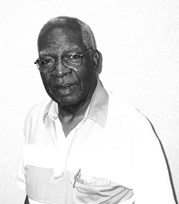 Lt. Colonel Paul Adams was born in 1920 in Greenville, South Carolina. Adams entered the Tuskegee Institute in Alabama in 1942. After graduating as a fighter pilot, he was assigned to patrol the Naples harbor, flying with the 332nd Fighter Group. This African-American unit, known as the “Red Tail” group because of their distinctive aircraft paint scheme, established the unprecedented record of flying more than 1,500 missions in Europe and North Africa, losing only ninety-eight pilots.
Lt. Colonel Paul Adams was born in 1920 in Greenville, South Carolina. Adams entered the Tuskegee Institute in Alabama in 1942. After graduating as a fighter pilot, he was assigned to patrol the Naples harbor, flying with the 332nd Fighter Group. This African-American unit, known as the “Red Tail” group because of their distinctive aircraft paint scheme, established the unprecedented record of flying more than 1,500 missions in Europe and North Africa, losing only ninety-eight pilots.
After the war, Adams served at a variety of locations worldwide and finally, as Deputy Base Commander at Lincoln, Nebraska. He retired in 1963 after twenty years of service. He served in nine major campaigns and received the Commendation Medal with three Oak Leaf clusters. After retiring from the Air Force, Adams joined the staff at Lincoln High School as an Industrial Arts teacher. One of the first three African-American teachers in the school system, he continued to teach until 1982.
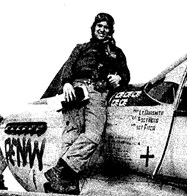
Lester Arasmith was born in St. Joseph, Missouri, on June 9, 1924, and graduated from high school on the 6th of June, 1942. He joined the U.S. Army Air Corps as an aviation cadet at Ft. Leavenworth, Kansas, on June 16, 1942, and was commissioned as a 2nd Lieutenant and awarded his pilot wings on December 5, 1943.
Lt. Arasmith joined the 530th Fighter Squadron of the 311th Fighter Group flying P-51 Mustangs in Burma (and later in China) in August 1944. During his service there, he destroyed five KI-43 Nakajima Oscar fighters and one Mitsubishi Zero as well as severely damaging one more.
In January of 1947 he left active duty and joined the Reserves. Captain Arasmith returned to active duty with the newly formed U.S. Air Force later that same year, and in July 1950 deployed to Korea where he flew F-51 Mustangs and F-80 Shooting Stars with the 40th Fighter Interceptor Squadron and then with the 41st FIS of the 35th Fighter Group. Major Arasmith next flew F-86 Sabre jets with the 94th FIS at George AFB, California, from June 1951 to January 1955. Colonel Arasmith then served as Commander of the 327th Combat Support Squadron and the Base Commander at Truex Field, Wisconsin, from August 1963 to July 1966.
In 1968 he deployed to Southeast Asia where he served as commander of the 3rd Combat Support Group at Bien Hoa Air Force Base from May 1968 to March 1969. After serving in Viet Nam, Colonel Arasmith returned to the U.S. and retired from the Air Force on July 31, 1969. During his military career, Lester Arasmith earned the following Decorations, Citations, and Awards: Combat Aviator Wings; United Nations Service; Viet Nam Campaign; Republic of Korea War Service; Air Force Longevity Service w/ Oak Leaf; Armed Forces Reserve; Small Arms Expert Marksman; National Defense Service w/star; Korean Service w/4 stars; Viet Nam Service w/3 stars; Asia-Pacific Campaign w/3 stars; WWII Victory; Army of Occupation; Presidential Unit Citation; American Campaign; Airman Medal; Air Force Commendation w/Oak Leaf; 2 Air Medals w/Oak Leaves; and Distinguished Flying Cross w/2 Oak Leaves.
Following his military service, Lester Arasmith received his PhD in Economics from the University of Colorado and served on the faculties of the University of Nebraska-Omaha and Bethel University in St. Paul, Minnesota. He and his wife, Nadine, returned to Lincoln in 1990 to be near their family. Lester Arasmith continues to reside close to his daughter in Lincoln.
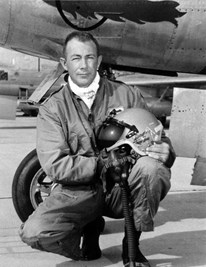
Fred H. Bailey, Jr. helped lead the Nebraska Air National Guard to a position of statewide prominence and respect. Bailey began his aviation career in the Civilian Pilot Training program in 1940 and used his flying skills in the U.S. Army Air Force as a wartime flight instructor. In 1946 Bailey became one of the original members of the Nebraska Air National Guard and served as Flight Commander of its 173rd Fighter Squadron. Bailey’s unit, flying P-51 Mustangs, saw active duty during the Korean War. His subsequent years with the Air Guard were marked by numerous promotions and considerable recognition for his efforts to develop his command into an outstanding force.
 Harry Barr soloed on January 16, 1955 and passed his private license check ride on July 3, 1955. With his partner, Donald Duncan, he founded Duncan Aviation, currently employing more than 1,700 aviation professionals. They also created Panhandle Aviation, operating a fleet of helicopters to support missile site construction.
Harry Barr soloed on January 16, 1955 and passed his private license check ride on July 3, 1955. With his partner, Donald Duncan, he founded Duncan Aviation, currently employing more than 1,700 aviation professionals. They also created Panhandle Aviation, operating a fleet of helicopters to support missile site construction.
For twenty-four years, he contracted for support services for government operations for the United States Bureau of Land Management in Alaska. As an active member of the Lincoln Sport Parachute Club, Barr made more than seventy jumps. He is a founding member of the Midwest Aerobatic Club and participated in numerous aerobatic contests and air shows.
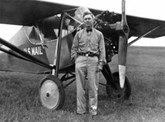 Arvine Bierman, the first inductee into the Hall of Fame, helped pioneer civilian aviation in Nebraska. Flying lessons began in 1926. A move to Holdrege, Nebraska resulted in a twelve-year stint as personal pilot for Frank Brewster, the "flying doctor." He took Brewster on countless missions of mercy, most notably during the devastating Republican River floods of the 1930s, when Bierman's airplane carried sick and injured persons, medicine, and food. To promote aviation Bierman barnstormed, gave demonstrations, introduced crop spraying in Phelps County, and operated the fledgling Holdrege airport. During World War II he shared his flying skills as a teacher for 700 Navy Cadets.
Arvine Bierman, the first inductee into the Hall of Fame, helped pioneer civilian aviation in Nebraska. Flying lessons began in 1926. A move to Holdrege, Nebraska resulted in a twelve-year stint as personal pilot for Frank Brewster, the "flying doctor." He took Brewster on countless missions of mercy, most notably during the devastating Republican River floods of the 1930s, when Bierman's airplane carried sick and injured persons, medicine, and food. To promote aviation Bierman barnstormed, gave demonstrations, introduced crop spraying in Phelps County, and operated the fledgling Holdrege airport. During World War II he shared his flying skills as a teacher for 700 Navy Cadets.
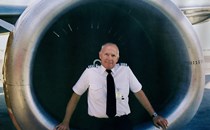 Ed Bowes was born raised and educated in Lincoln, Nebraska. Ed served as a medic in the U.S. Army stationed in West Germany. Upon discharge, Ed working at odd jobs obtained his Private Pilot Rating then using the benefits of the GI Bill earned his Commercial Pilot Rating. Ed earned his Commercial Flight Instructor Rating and began training students as a Flight Instructor for Lincoln Aviation Institute in Lincoln, Nebraska. Ed worked as an aerial applicator in Chester, Nebraska and Wahoo, Nebraska and then later ran an aerial application business in Ashland, Nebraska for several years. Ed became proficient giving aerobatic instruction which prompted his appointment by the FAA as an Aerobatic Competency Evaluator. This led to a position as an Aerobatic Competency Evaluator for the International Council of Airshows. Ed also earned his Rotor Wing Certificate.
Ed Bowes was born raised and educated in Lincoln, Nebraska. Ed served as a medic in the U.S. Army stationed in West Germany. Upon discharge, Ed working at odd jobs obtained his Private Pilot Rating then using the benefits of the GI Bill earned his Commercial Pilot Rating. Ed earned his Commercial Flight Instructor Rating and began training students as a Flight Instructor for Lincoln Aviation Institute in Lincoln, Nebraska. Ed worked as an aerial applicator in Chester, Nebraska and Wahoo, Nebraska and then later ran an aerial application business in Ashland, Nebraska for several years. Ed became proficient giving aerobatic instruction which prompted his appointment by the FAA as an Aerobatic Competency Evaluator. This led to a position as an Aerobatic Competency Evaluator for the International Council of Airshows. Ed also earned his Rotor Wing Certificate.
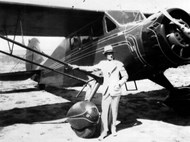 Dr. Frank A. Brewster, born in Gage County Nebraska in 1872, made history in 1919 as the first civilian doctor to fly to a patient’s bedside. Known as the “World’s First Flying Surgeon,” he was the first physician to purchase an airplane for use in making professional calls.
Dr. Frank A. Brewster, born in Gage County Nebraska in 1872, made history in 1919 as the first civilian doctor to fly to a patient’s bedside. Known as the “World’s First Flying Surgeon,” he was the first physician to purchase an airplane for use in making professional calls.
Brewster built one of the first airports in Nebraska at Beaver City and then financed and built airports in Grand Island, Holdrege, and, Nebraska, as well as Oberlin, Kansas. In 1960, the Holdrege Municipal Airport was named Brewster Field in his honor, with a dedication ceremony and air show.
 Donald W. Brown was born and raised in the Denver, Colorado area. Brown helped start W & B Army Primary Flying School in Oklahoma and worked for the Cutter-Carr Flying School in New Mexico as test pilot and superintendent of maintenance. He changed the pace of wing repairs by introducing his method of wing spar splicing. In 1943, Brown worked as a maintenance inspector for the Civil Aeronautics Administration in Lincoln, Nebraska. In 1946, the Browns moved to Lodgepole, Nebraska and started Lodgepole Flying Service, the first in the state to use twin engine aircraft in charter operation. Brown started a fixed base operation in Sidney and Kimball, flew pipeline patrol, and conducted agricultural spraying and dusting operations. Brown flew around-the-clock rescue missions during plains blizzards. He started the Mid-Continent School of Aeronautics.
Donald W. Brown was born and raised in the Denver, Colorado area. Brown helped start W & B Army Primary Flying School in Oklahoma and worked for the Cutter-Carr Flying School in New Mexico as test pilot and superintendent of maintenance. He changed the pace of wing repairs by introducing his method of wing spar splicing. In 1943, Brown worked as a maintenance inspector for the Civil Aeronautics Administration in Lincoln, Nebraska. In 1946, the Browns moved to Lodgepole, Nebraska and started Lodgepole Flying Service, the first in the state to use twin engine aircraft in charter operation. Brown started a fixed base operation in Sidney and Kimball, flew pipeline patrol, and conducted agricultural spraying and dusting operations. Brown flew around-the-clock rescue missions during plains blizzards. He started the Mid-Continent School of Aeronautics.
In 1961, Brown became airport manager at Alliance, Nebraska and opened Don Air Service and an aircraft and helicopter distributorship. In 1971, he started Trans-Nebraska Airlines. Brown logged more than 50,000 accident-free hours in almost every type of aircraft.
 Phil Brown was born on August 19, 1943 in Lincoln, NE. In 1946 the Brown’s moved to Lodgepole where Phil grew up around aviation, soloing four airplanes on his sixteenth birthday. He gained experience helping with the family business, Lodgepole Flying Service and later Don Air Service in Alliance. Some of his accomplishments include demonstrating helicopter and aircraft, flight instruction, aircraft mechanic, charter operations, pipeline patrol, agricultural spraying, flying in air shows and helping to start the Mid-Continent School of Aeronautics, which brought students from all over the world. Phil helped during several power outages caused by Nebraska blizzards, delivering medicine to snow bound families and in one case, pulling a hunter from the Platte River who had fallen through the ice and could not get out. The City of Alliance requested Brown’s assistance when they installed a new water tower but did not have a crane available to hoist a light atop the tower. Using a Brantly 305 helicopter, he landed on top of the tower so the lamp could be installed. From 1964 to 1966, Brown was an advanced instrument instructor on the Huey helicopter at Ft. Rucker, Alabama and was the youngest instructor at the Fort. He flew with Hamilton Brothers Oil Company on the North Slope above the Arctic Circle sling loading oil rigs and supplies. During his time there, he flew a civilian Huey to rescue an oil drilling crew whose barge was being crushed by the ice flow. Brown ordered the crew to discard their wet coats, which enabled him to rescue the entire crew.
Phil Brown was born on August 19, 1943 in Lincoln, NE. In 1946 the Brown’s moved to Lodgepole where Phil grew up around aviation, soloing four airplanes on his sixteenth birthday. He gained experience helping with the family business, Lodgepole Flying Service and later Don Air Service in Alliance. Some of his accomplishments include demonstrating helicopter and aircraft, flight instruction, aircraft mechanic, charter operations, pipeline patrol, agricultural spraying, flying in air shows and helping to start the Mid-Continent School of Aeronautics, which brought students from all over the world. Phil helped during several power outages caused by Nebraska blizzards, delivering medicine to snow bound families and in one case, pulling a hunter from the Platte River who had fallen through the ice and could not get out. The City of Alliance requested Brown’s assistance when they installed a new water tower but did not have a crane available to hoist a light atop the tower. Using a Brantly 305 helicopter, he landed on top of the tower so the lamp could be installed. From 1964 to 1966, Brown was an advanced instrument instructor on the Huey helicopter at Ft. Rucker, Alabama and was the youngest instructor at the Fort. He flew with Hamilton Brothers Oil Company on the North Slope above the Arctic Circle sling loading oil rigs and supplies. During his time there, he flew a civilian Huey to rescue an oil drilling crew whose barge was being crushed by the ice flow. Brown ordered the crew to discard their wet coats, which enabled him to rescue the entire crew.
From 1970-72, Brown was VP and Chief Pilot of Trans-Nebraska Airlines working with his father, Don Brown. This commuter airline tied Nebraska to Denver and Chicago. Phil retired from Seattle Jetstream in 2004 and is currently flying part time charter and rescue missions in Meeker, Colorado. Phil has flown over 110 makes and models of aircraft ranging from the J-3 Cub to the Boeing 737, including helicopters, and has logged more than 25,000 accident free hours.
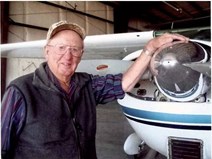 Clifton A. Buske was born on September 14, 1927 on the family ranch north of Lisco, Nebraska. A friend, Marvin Stevensen purchased a Curtis Robin, which he stored on the Buske ranch. Eleven year old, Clifton, became fascinated with flying, and got to ride with Stevensen every weekend. He was always buying airplane models, putting them together and flying them. After the war, Stevensen started a flight school with army surplus trainers. Buske talked his father into buying a Piper J3 Cub so that he and his sister could learn to fly. A hangar was built on the Buske ranch that would hold five small planes.
Clifton A. Buske was born on September 14, 1927 on the family ranch north of Lisco, Nebraska. A friend, Marvin Stevensen purchased a Curtis Robin, which he stored on the Buske ranch. Eleven year old, Clifton, became fascinated with flying, and got to ride with Stevensen every weekend. He was always buying airplane models, putting them together and flying them. After the war, Stevensen started a flight school with army surplus trainers. Buske talked his father into buying a Piper J3 Cub so that he and his sister could learn to fly. A hangar was built on the Buske ranch that would hold five small planes.
After graduation from high school, Buske’s parents insisted that he have two more years of school. So he agreed to go to the Spartan School of Aeronautics in Tulsa, Oklahoma for a year. There he received his mechanics rating. Upon returning home, Buske flew his dad, who was county commissioner, to check the roads in his district. He also flew for some of the neighboring ranches twice a week to check their summer ranges for water.
In 1967, Buske was appointed to the Airport Zoning Board and in 1970 to the Garden County Airport Authority. Under his leadership the Authority was able to construct the main hangar/office and an eight unit t-hangar. Buske was also responsible for the addition of 1000’ to the existing runway making it 4700’ X 50’. In 2005, a parallel taxiway to runway 12 was built. In 2006, a credit card fueling system was installed. Prior to that, Buske or one of the other board members would have to make the fifteen mile trip to the airport to provide fuel for aircraft.
Buske maintained the Garden County Airport facilities with his own labor. He hosted Nebraska Department of Aeronautics and FAA meetings at the airport, which he felt was very important to thank officials for the projects.
Several other projects are planned for the airport over the next few years. After their completion, Buske plans to retire with 40 years of service to the community and airport.
 Robert L. Carlisle, a flier since 1938 from Norfolk, Nebraska applied his aviation skills and knowledge to many uses and presented them before a variety of audiences. Carlisle served as a United States Navy aviator in World War II and in the Naval Reserve until 1957. He commanded the Norfolk Civil Air Patrol Squadron. He also participated in “Operation Snowbound” in 1948-49, carrying out forty-six missions searching for lost aircraft, and flew levee patrol in Omaha during the devastating 1953 floods.
Robert L. Carlisle, a flier since 1938 from Norfolk, Nebraska applied his aviation skills and knowledge to many uses and presented them before a variety of audiences. Carlisle served as a United States Navy aviator in World War II and in the Naval Reserve until 1957. He commanded the Norfolk Civil Air Patrol Squadron. He also participated in “Operation Snowbound” in 1948-49, carrying out forty-six missions searching for lost aircraft, and flew levee patrol in Omaha during the devastating 1953 floods.
Northeast Nebraska benefited from his years of public service on the Norfolk Airport Authority and the Norfolk Chamber of Commerce transportation committee, from his organization of the “Wings for Children” charitable flight program, and from his extensive educational lectures on aviation subjects. An accomplished flier, Carlisle also held two speed records for Class C-1a and C-1b aircraft.
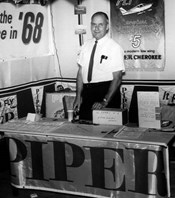 Lloyd Carr, born in Alliance, Nebraska has been involved in Aviation since age twenty. After graduation from the Von Hoffman School of Aeronautics in St. Louis, Missouri in 1930, he and a friend bought a wrecked OX-5 American Eagle Bi-plane, rebuilt it and taught himself to fly. In 1958 he was hired to manage the Sidney Municipal Airport. There he started Overland Air Service, operated a Piper Aircraft Dealership and Certified Service Center, taught nearly one hundred people to fly, was instrumental in the development of commercial service by Frontier Airlines, and fostered the growth and development of the airport and General Aviation for twenty-six years. Carr logged 12,000 hours of safe flying and was especially renowned for his mechanical abilities. During the blizzard of 1949 he flew along Highway 30 for many hours looking for survivors. Arizona Wing, the OX-5 Aviation Pioneers, made him an honorary member for his contributions to aviation.
Lloyd Carr, born in Alliance, Nebraska has been involved in Aviation since age twenty. After graduation from the Von Hoffman School of Aeronautics in St. Louis, Missouri in 1930, he and a friend bought a wrecked OX-5 American Eagle Bi-plane, rebuilt it and taught himself to fly. In 1958 he was hired to manage the Sidney Municipal Airport. There he started Overland Air Service, operated a Piper Aircraft Dealership and Certified Service Center, taught nearly one hundred people to fly, was instrumental in the development of commercial service by Frontier Airlines, and fostered the growth and development of the airport and General Aviation for twenty-six years. Carr logged 12,000 hours of safe flying and was especially renowned for his mechanical abilities. During the blizzard of 1949 he flew along Highway 30 for many hours looking for survivors. Arizona Wing, the OX-5 Aviation Pioneers, made him an honorary member for his contributions to aviation.
 Carl H. Christophersen worked for Harold Hoskins and Associates in Lincoln (now HWS Consulting) for more than forty years, providing engineering expertise for numerous projects at thirty-three Nebraska airports. He graduated from Lincoln High School in 1949 and received a B.S. in Civil Engineering from the University of Nebraska in 1953.
Carl H. Christophersen worked for Harold Hoskins and Associates in Lincoln (now HWS Consulting) for more than forty years, providing engineering expertise for numerous projects at thirty-three Nebraska airports. He graduated from Lincoln High School in 1949 and received a B.S. in Civil Engineering from the University of Nebraska in 1953.
Christopherson was a pilot and airplane owner, but he distinguished himself by helping to shape one-third of the active airports in Nebraska today, providing engineering design and construction observation, as well as project administration, planning, and funding application services. His legacy can be seen when using any of the facilities he helped develop.
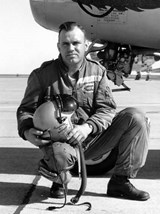 Clarence Christensen, Jr., veteran military flier, made aviation history when he won the Ricks Trophy Race in 1958. Born in Hooper, Nebraska, Christensen joined the United States Army Air Force in 1942 and piloted a B-24 bomber in the European Theater. After the war he remained in the reserves as a flier, then joined the Nebraska Air National Guard in 1949. Christensen retired in 1978 with the rank of Lieutenant Colonel.
Clarence Christensen, Jr., veteran military flier, made aviation history when he won the Ricks Trophy Race in 1958. Born in Hooper, Nebraska, Christensen joined the United States Army Air Force in 1942 and piloted a B-24 bomber in the European Theater. After the war he remained in the reserves as a flier, then joined the Nebraska Air National Guard in 1949. Christensen retired in 1978 with the rank of Lieutenant Colonel.
None of his many personal achievements surpassed his winning the Ricks Trophy Race. Representing the 173rd Fighter Interceptor Squadron, “Chris” Christensen flew his F-86D Sabre jet over the 850-mile course between Jacksonville, Florida, and Dallas, Texas, in one hour, forty-eight minutes, and twenty seconds.
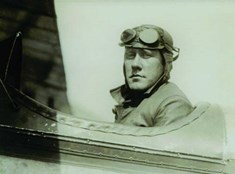 Jens Tinus Christensen was born in Denmark on August 25, 1890 but came to Nebraska at the age of four when his parents immigrated to America. They settled in Blair and that is where Christensen went to school. He graduated from Dana College.
Jens Tinus Christensen was born in Denmark on August 25, 1890 but came to Nebraska at the age of four when his parents immigrated to America. They settled in Blair and that is where Christensen went to school. He graduated from Dana College.
Christensen joined the military in 1917, took flight training and served as a flight instructor during World War I mustering out in 1919. He continued flying, performing at exhibitions in cities around the Midwest. He hired on with the aviation mail service in 1920 and was one of the first to fly the Omaha-Chicago route, which was based at a field on the Ak-Sar-Ben grounds.
Flying the mail in 1920 was very dangerous. Pilots had no radio contact and no instruments for flying in bad weather. Thirty-one of the first forty pilots hired by the post office died in the line of duty.
Christensen was considered one of the best airmail pilots. As an experienced stunt flyer, he had a good sense of the winds a oft and set speed records for the Omaha-Chicago and Chicago-New York airmail runs. Christensen helped to found the Associated Airmail Pilots union, serving as one of it’s first presidents.
Christensen was transferred to Chicago in 1921and made his first flight on the Chicago-Cleveland route on a foggy April morning. On his approach to Cleveland, he got lost in the fog and had to fly low over the city in search of landmarks. The engine on his DeHaviland biplane sputtered and failed. Christensen aimed for the river to avoid pedestrians on the streets but crash landed and burst into flames on the railroad tracks beside the Cuyahoga River.
The funeral in Blair, gave an indication of his popularity and accomplishments as a flyer. More than 1,000 cars ( a huge number in 1921) arrived at the burial site and an estimated 10,000 people attended the services and watched as planes from the Omaha Airmail Division flew over and dropped garlands of flowers. His grave was marked with a giant propeller and in 1941 the local airfield was named for him.
Tinus Christensen brought credit to Nebraska through his service as a pioneer aviator. His accomplishments were ground-breaking and his skills landed him in the record books. He inspired others through his energy, positive attitude and love of flying.
 Elmwood native Grace (Betty) Clements helped put a sizable crack in the glass ceiling regarding women becoming military pilots during WWII. Learning to fly in 1940 in Madison, Wisconsin while attending grad school, then continuing her flight training at Beebe Air Service while teaching in Hastings, Nebraska, Betty earned her private pilot’s license in 1942. Betty then joined the Civil Air Patrol. In 1943, Betty heard about the Women Airforce Service Pilots (WASP) program and had enough hours to qualify. She applied and was then invited by WASP director, Jacqueline Cochran, to join class 43-W-5 at Avenger Field, Sweetwater, Texas for flight training. Betty trained on the PT-19, BT-15, AT-6, AT-9, and the twin-engine AT-17. In advanced training she flew the B-17 but was subsequently transferred to Blytheville, Arkansas Army Airfield where she flew ferrying missions around the United States.
Elmwood native Grace (Betty) Clements helped put a sizable crack in the glass ceiling regarding women becoming military pilots during WWII. Learning to fly in 1940 in Madison, Wisconsin while attending grad school, then continuing her flight training at Beebe Air Service while teaching in Hastings, Nebraska, Betty earned her private pilot’s license in 1942. Betty then joined the Civil Air Patrol. In 1943, Betty heard about the Women Airforce Service Pilots (WASP) program and had enough hours to qualify. She applied and was then invited by WASP director, Jacqueline Cochran, to join class 43-W-5 at Avenger Field, Sweetwater, Texas for flight training. Betty trained on the PT-19, BT-15, AT-6, AT-9, and the twin-engine AT-17. In advanced training she flew the B-17 but was subsequently transferred to Blytheville, Arkansas Army Airfield where she flew ferrying missions around the United States.
Under secret orders, she was transferred to Wendover Field in Utah to support the group training with Col. Paul W. Tibbetts Jr. for the eventual bombing of Hiroshima, Japan. At Wendover she flew a Lockheed Hudson Bomber delivering people and supplies for the atom bomb experiments. After the WASP program was deactivated in 1944, WASP Clements had flown 1,047 hours in 13 different types of military aircraft.
With an interest in medicine, Betty enrolled in Red Cross Training and was sent to the Philippines where she was assigned to a US Army Hospital in Manilla where she dealt with the atrocities left by the retreating Japanese Army. Upon her return to the States, Betty enrolled in the University of Nebraska, College of Medicine and continued her medical training as an MD. After graduating she accepted a neurology fellowship at the Mayo Clinic and also studied at the National Neurological Institute in London, England. Dr. Clements opened a practice as a neurologist in Phoenix, Arizona and was a founding member and teacher at the Barrow Neurological Institute of St. Joseph’s Hospital in Phoenix. Betty remained active as an aviator and a member of the Ninety-Nines. In 2010 she was posthumously awarded the Congressional Gold Medal.
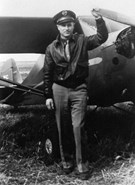 John Clinch is considered the “father of North Platte aviation.” A Norfolk, Nebraska native, Clinch came to North Platte, Nebraska in 1938, when the airfield was a fenced pasture, and started the Clinch Flying Service. For thirteen years he also managed the North Platte airport, which has become a modern municipal airport. His public career also consisted of assisting in the development of the State Department of Aeronautics and helping organize the Nebraska Aviation Trades Association.
John Clinch is considered the “father of North Platte aviation.” A Norfolk, Nebraska native, Clinch came to North Platte, Nebraska in 1938, when the airfield was a fenced pasture, and started the Clinch Flying Service. For thirteen years he also managed the North Platte airport, which has become a modern municipal airport. His public career also consisted of assisting in the development of the State Department of Aeronautics and helping organize the Nebraska Aviation Trades Association.
During World War II Clinch put his flying skills to work as a teacher. Seven hundred naval cadets took to the air at the North Platte field. After the war the Clinch Flying Service expanded into Clinch International, a noted flying service.
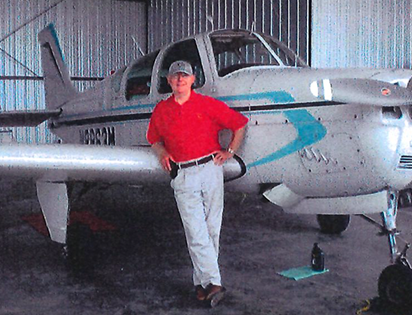 Geary L. Combs has a long history of contributing to the advancement of aviation at Blair, Nebraska. In 2003 he joined the Blair Airport Authority, becoming its chairman in 2005 serving in that role until his passing in 2022. During his 17 years as Chair the airport built a new runway, increased the number of based aircraft from 37 to over 70, and brought fuel sales from 8,000 gallons to 300,000 gallons per year. Additionally, hangars and other infrastructure were constructed to accommodate the growth. Before his passing he set into motion the process to extend the runway from 4,200’ to 5,000’.
Geary L. Combs has a long history of contributing to the advancement of aviation at Blair, Nebraska. In 2003 he joined the Blair Airport Authority, becoming its chairman in 2005 serving in that role until his passing in 2022. During his 17 years as Chair the airport built a new runway, increased the number of based aircraft from 37 to over 70, and brought fuel sales from 8,000 gallons to 300,000 gallons per year. Additionally, hangars and other infrastructure were constructed to accommodate the growth. Before his passing he set into motion the process to extend the runway from 4,200’ to 5,000’.
During Geary’s 17 years of leadership as Chairman of the Blair Airport Authority 24 major projects were accomplished. A few examples:
- 2006 – Fuel Farm
- 2007 – New Executive and T-Hangars
- 2007 – AWOS Commissioned
- 2009 – Parallel Taxiway
- 2009 – GPS LNAV Approaches Commissioned
In addition, Geary led the effort for construction of a single 80’ by 80’ hangar to be owned by Blair Airport Authority to accommodate a Fixed Base Operation that would provide aviation services on the Blair Airport. Both the new hangar and FBO were completed in 2012.
Subsequently the following years saw Geary’s leadership lead to the development of additional corporate and private hangars, lower minimums for the airports LPV instrument approaches and the relocation of the Omaha Police Department to the Blair Airport.
At the State level, Geary supported and promoted both the State Aviation Economic Impact Study and State Aviation Plan and testified in front of the Nebraska Legislature Transportation Committee in support of legislation to promote and grow aviation in Nebraska.
Geary’s legacy will have a lasting impact on aviation in the State of Nebraska.
 Brigadier General Harold E. Confer was born in Culbertson in 1924. He received his wings and commission as Second Lieutenant in the U.S. Army Air Corps in 1945. In 1961 Hal Confer’s crew flew the first supersonic bomber (B-58) to three new world speed records. Their record of 1,284 m.p.h. on the 1,000 kilometer course resulted in the award of the prestigious Thompson Trophy. He served as Commander of the 1st Strategic Reconnaissance Squadron, Deputy Commander for Operations. In 1967 he and his Reconnaissance Systems Operator Charles “Red” McNeer qualified in the SR-71, the only native Nebraskan to fly the SR-71 (the world’s fastest and highest flying aircraft). In 1969 he became Vice Wing Commander and in 1970 he moved to Wing Commander, and serving in that position until 1972.
Brigadier General Harold E. Confer was born in Culbertson in 1924. He received his wings and commission as Second Lieutenant in the U.S. Army Air Corps in 1945. In 1961 Hal Confer’s crew flew the first supersonic bomber (B-58) to three new world speed records. Their record of 1,284 m.p.h. on the 1,000 kilometer course resulted in the award of the prestigious Thompson Trophy. He served as Commander of the 1st Strategic Reconnaissance Squadron, Deputy Commander for Operations. In 1967 he and his Reconnaissance Systems Operator Charles “Red” McNeer qualified in the SR-71, the only native Nebraskan to fly the SR-71 (the world’s fastest and highest flying aircraft). In 1969 he became Vice Wing Commander and in 1970 he moved to Wing Commander, and serving in that position until 1972.
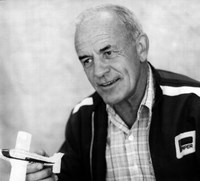 John “Jack” Costello, a U.S. Army Air Corps flight instructor, made his first solo flight at age sixteen. He cofounded F.C. Flying Service, aNorfolk, Nebraska commercial crop spraying business in 1952. Costello served as president of the Nebraska Aviation Trades Association and was named Airman of the Year in 1979.
John “Jack” Costello, a U.S. Army Air Corps flight instructor, made his first solo flight at age sixteen. He cofounded F.C. Flying Service, aNorfolk, Nebraska commercial crop spraying business in 1952. Costello served as president of the Nebraska Aviation Trades Association and was named Airman of the Year in 1979.
In 1977 he flew a section of the commemorative air mail route as part of the Silver Wings Fraternity’s observance of the Fiftieth Anniversary of Transcontinental Air Mail Transportation.
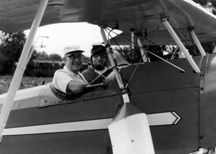 Roy Cram, a Burwell, Nebraska physician and aviation enthusiast, preserved a vital part of our state’s aviation history. In 1962 Cram bought an Arrow Sport, one of six known to exist, restored the plane to its original appearance and condition, and flew it for years. Purchased by the Nebraska State Historical Society Foundation in 1977, with help from the Friends of Lincoln Aviation, the Arrow Sport is on display at the Lincoln Municipal Airport.
Roy Cram, a Burwell, Nebraska physician and aviation enthusiast, preserved a vital part of our state’s aviation history. In 1962 Cram bought an Arrow Sport, one of six known to exist, restored the plane to its original appearance and condition, and flew it for years. Purchased by the Nebraska State Historical Society Foundation in 1977, with help from the Friends of Lincoln Aviation, the Arrow Sport is on display at the Lincoln Municipal Airport.
Cram combined a love of flying with community service. His efforts to promote aviation, teach young aviators, and develop a new Burwell airport were recognized when it was dedicated in 1961 as Cram Field.
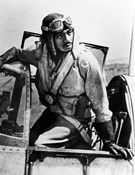 Alfonza W. Davis was born in Omaha, September 23, 1919. Davis joined the Army in 1941 and was assigned to the Air Corps as an aviation cadet at Tuskegee Army Air Field, AL. As a flight squadron leader, he graduated at the top of his class and became Omaha’s first African-American aviator to earn an officer commission and pilot wings.Davis was Assistant Group Operations Officer for the 332nd Fighter Group. This black unit, known as the “Red Tail” group because of their distinctive aircraft paint scheme, established the unprecedented record of flying all their bomber escort missions (200 from June 1944–April 1945) without the loss of a single bomber to enemy aircraft. He became Squadron Commander of the 99th Pursuit Squadron and was killed in action in 1944. His citations include the Purple Heart, Distinguished Flying Cross, and the Distinguished Unit Citation. In May 1988 the Davis Chapter of Tuskegee Airmen was founded in Omaha to conduct historical research and document the aspirations, frustrations, and successes of these pioneering men and women in military aviation who served our country, fighting two wars—one against enemy military forces and the other against racism at home and abroad.
Alfonza W. Davis was born in Omaha, September 23, 1919. Davis joined the Army in 1941 and was assigned to the Air Corps as an aviation cadet at Tuskegee Army Air Field, AL. As a flight squadron leader, he graduated at the top of his class and became Omaha’s first African-American aviator to earn an officer commission and pilot wings.Davis was Assistant Group Operations Officer for the 332nd Fighter Group. This black unit, known as the “Red Tail” group because of their distinctive aircraft paint scheme, established the unprecedented record of flying all their bomber escort missions (200 from June 1944–April 1945) without the loss of a single bomber to enemy aircraft. He became Squadron Commander of the 99th Pursuit Squadron and was killed in action in 1944. His citations include the Purple Heart, Distinguished Flying Cross, and the Distinguished Unit Citation. In May 1988 the Davis Chapter of Tuskegee Airmen was founded in Omaha to conduct historical research and document the aspirations, frustrations, and successes of these pioneering men and women in military aviation who served our country, fighting two wars—one against enemy military forces and the other against racism at home and abroad.
 Douglas G. Decker was born July 21, 1948 in Fairbury, NE, and grew up in Hollenberg, KS . Doug joined the Army in March 1968, training as a helicopter pilot at Fort Wolters, TX. In 1969, he went to Vietnam to fly the AH1 Cobra. Doug transferred to the Hughes 300. In November 1976, he joined the NE Army National Guard and began flying the UH-1 Huey as a medical pilot for the 24th Medical Company, based in Lincoln, NE. During the next several decades, he was an Aviation Safety Officer, Instructor Pilot, UH-60 (Blackhawk) Pilot and Flight Examiner. Decker was involved in humanitarian tours to Central America, Operation Desert Shield/Desert Storm, and Operation Joint Forge. He progressed from Warrant Officer 1 to Chief Warrant Officer 5.
Douglas G. Decker was born July 21, 1948 in Fairbury, NE, and grew up in Hollenberg, KS . Doug joined the Army in March 1968, training as a helicopter pilot at Fort Wolters, TX. In 1969, he went to Vietnam to fly the AH1 Cobra. Doug transferred to the Hughes 300. In November 1976, he joined the NE Army National Guard and began flying the UH-1 Huey as a medical pilot for the 24th Medical Company, based in Lincoln, NE. During the next several decades, he was an Aviation Safety Officer, Instructor Pilot, UH-60 (Blackhawk) Pilot and Flight Examiner. Decker was involved in humanitarian tours to Central America, Operation Desert Shield/Desert Storm, and Operation Joint Forge. He progressed from Warrant Officer 1 to Chief Warrant Officer 5.
Awards received by Decker during his 36 years with the military including Meritorious Service Medal, Air Medal with combat distinguished “V”(valor) three times, Army Commendation Medal-three awards, Army Achievement Medal-three awards, Meritorious Unit Commendation, Army Reserve Component Achievement Medal-six times, National Defense Service Medal Army, Armed Forces Expeditionary Medal-twice, Vietnam Service Medal with 3 bronze stars, Southwest Asia Medal with2 bronze stars, Armed Forces Reserve Medal with “M” device-twice, Army Reserve Component, Overseas Training Ribbon-three times, Republic of Vietnam Campaign Medal, Republic of Vietnam Gallantry Cross, Unit Citation with bronze star, NATO Medal, Kuwait Liberation Medal (Kuwait), Kuwait Liberation Medal-(Saudi Arabia), NE National Guard Emergency Service Medal-seventeen times, Nebraska National Guard Legion of Merit, NE National Guard Meritorious Service Medal, NE National Guard 25 year Service Medal and the Humanitarian Service Medal. Decker transitioned from UH-1(Huey) to UH-60(Blackhawk) and then to the fixed wing B200 Super King Aire (C12). Doug retired from the NE Army National Guard with over 6,000 hours of military flight time. He also had 1,000 civilian flight hours.
 Raymond F. DeMers, (center) World War II aviator from Sunol, Cheyenne County Nebraska, helped set a record by destroying the most German aircraft in one combat mission. On March 28, 1944, his 357th Fighter Squadron of P-51B Mustang fighters attacked an air base in southern France, destroying eighteen enemy aircraft and damaging thirty-one.
Raymond F. DeMers, (center) World War II aviator from Sunol, Cheyenne County Nebraska, helped set a record by destroying the most German aircraft in one combat mission. On March 28, 1944, his 357th Fighter Squadron of P-51B Mustang fighters attacked an air base in southern France, destroying eighteen enemy aircraft and damaging thirty-one.
One month later DeMers flew a mission over Germany, where he shot down two planes and damaged a third. While strafing enemy shipping on the Rhine River, he was hit by anti-aircraft fire and killed. During his brief career he flew more than fifty combat missions and forty operational sorties. He was awarded the Distinguished Flying Cross.
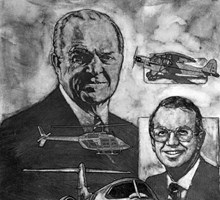 Donald Duncan (on the left) and his son J. Robert Duncan have been highly influential in Nebraska aviation and aviation business worldwide. Countless aviation professionals learned their trade at Duncan Aviation. Donald was an extraordinary salesman who entered aviation in 1956 opening a Beech dealership in Omaha, Nebraska. Robert had an active interest in aviation and the family business, soloing at age sixteen and working all of his extra hours at Duncan Aviation. He became the president of Duncan Aviation at age 26. Duncan Aviation garnered one of six original Learjet dealerships. The business grew dramatically, becoming a One Stop Service Center, a leader in business aviation, and a progressive, cutting-edge, family-owned business. Robert Duncan has participated in many different aviation organizations including The National Business Aircraft Association, the National Aviation Transportation Association, and the National Aircraft Resale Association. He is the recipient of the University of Nebraska-Lincoln’s Entrepreneur of the Year award and Creighton University’s Family Business award.
Donald Duncan (on the left) and his son J. Robert Duncan have been highly influential in Nebraska aviation and aviation business worldwide. Countless aviation professionals learned their trade at Duncan Aviation. Donald was an extraordinary salesman who entered aviation in 1956 opening a Beech dealership in Omaha, Nebraska. Robert had an active interest in aviation and the family business, soloing at age sixteen and working all of his extra hours at Duncan Aviation. He became the president of Duncan Aviation at age 26. Duncan Aviation garnered one of six original Learjet dealerships. The business grew dramatically, becoming a One Stop Service Center, a leader in business aviation, and a progressive, cutting-edge, family-owned business. Robert Duncan has participated in many different aviation organizations including The National Business Aircraft Association, the National Aviation Transportation Association, and the National Aircraft Resale Association. He is the recipient of the University of Nebraska-Lincoln’s Entrepreneur of the Year award and Creighton University’s Family Business award.
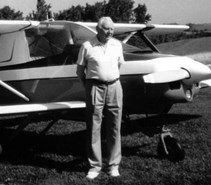 William H. Durand, engineer and designer, has designed, built, and flown gliders and airplanes since 1934. He served as professor of Engineering at Omaha University and established their Aeronautics Unit. He instructed student pilots and sponsored the University Flying Club. His C-40 solo sport monoplane was built in 1942 by his aviation classes, giving students experience in aerodynamics, drafting, and fabrication. Durand helped found the Experimental Aircraft Association Chapter 80, serving two terms as president. He developed the Durand Sky Ranch airfield in northwest Omaha, where many student pilots learned to fly. In the 1950s he formed his own engineering and design firm and a street in the Offutt Air Force Base was named Durand Drive in his honor. The Durand Sky Ranch is known for ultralite flying and innovative wind tunnel experiments.
William H. Durand, engineer and designer, has designed, built, and flown gliders and airplanes since 1934. He served as professor of Engineering at Omaha University and established their Aeronautics Unit. He instructed student pilots and sponsored the University Flying Club. His C-40 solo sport monoplane was built in 1942 by his aviation classes, giving students experience in aerodynamics, drafting, and fabrication. Durand helped found the Experimental Aircraft Association Chapter 80, serving two terms as president. He developed the Durand Sky Ranch airfield in northwest Omaha, where many student pilots learned to fly. In the 1950s he formed his own engineering and design firm and a street in the Offutt Air Force Base was named Durand Drive in his honor. The Durand Sky Ranch is known for ultralite flying and innovative wind tunnel experiments.
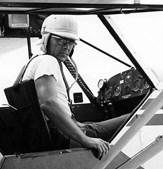 Joe Engels received his Aircraft and Engine certificate in 1939 from the Lincoln Flying School in Lincoln, Nebraska. In 1947, he started Engels Aircraft in Minot, North Dakota. In 1952, Engels Aircraft became an Fixed Base Operation at the Fairbury, Nebraska airport, offering aerial application, charter service, new and used aircraft sales, flight instruction, and aircraft maintenance. In 1961, the business expanded to Beatrice, Nebraska. Engels served as one of the first aerial agricultural application pilots in Nebraska and was a charter member of the Nebraska Aviation Trades Association. He received the Association’s Airman of the Year award. Engels was a single engine, multi-engine, and instrument instructor. He received the Charles Taylor Mechanic Award from the Federal Aviation Administration for holding an Aircraft and Engine license for more than fifty years.
Joe Engels received his Aircraft and Engine certificate in 1939 from the Lincoln Flying School in Lincoln, Nebraska. In 1947, he started Engels Aircraft in Minot, North Dakota. In 1952, Engels Aircraft became an Fixed Base Operation at the Fairbury, Nebraska airport, offering aerial application, charter service, new and used aircraft sales, flight instruction, and aircraft maintenance. In 1961, the business expanded to Beatrice, Nebraska. Engels served as one of the first aerial agricultural application pilots in Nebraska and was a charter member of the Nebraska Aviation Trades Association. He received the Association’s Airman of the Year award. Engels was a single engine, multi-engine, and instrument instructor. He received the Charles Taylor Mechanic Award from the Federal Aviation Administration for holding an Aircraft and Engine license for more than fifty years.
 Fred E. “Bud” Farington, Jr., a native of Falls City, Nebraska, wore the wings of both the United States Army Air Force and the British Royal Air Force. Educated at the Dallas Aviation School at Love Field in Dallas, Texas, he joined the British Royal Air Force in 1942 and was later commissioned as a Second Lieutenant in the United States Air Corps. Farington flew sixty-five combat missions and instructed pilots during World War II. He also instructed pilots during the Korean Conflict. His military awards included the Air Medal with seven clusters, the European Theater ribbon with three stars, the Presidential Citation, and the American Theater ribbon. Farington operated an aerial agricultural application and flight instruction business in Humboldt, Nebraska prior to serving as Airport Manager at the Auburn Municipal Airport. He also founded Auburn Flying Service, Inc., offering flight instruction and agricultural aviation services. In 1983 he constructed a home-built, open cockpit airplane. Farington was recognized as the 1990 Nebraska Aviation Trades Association Airman of the Year. In 1993, the Auburn Municipal Airport was renamed Farington Field in recognition of his service to the aviation industry.
Fred E. “Bud” Farington, Jr., a native of Falls City, Nebraska, wore the wings of both the United States Army Air Force and the British Royal Air Force. Educated at the Dallas Aviation School at Love Field in Dallas, Texas, he joined the British Royal Air Force in 1942 and was later commissioned as a Second Lieutenant in the United States Air Corps. Farington flew sixty-five combat missions and instructed pilots during World War II. He also instructed pilots during the Korean Conflict. His military awards included the Air Medal with seven clusters, the European Theater ribbon with three stars, the Presidential Citation, and the American Theater ribbon. Farington operated an aerial agricultural application and flight instruction business in Humboldt, Nebraska prior to serving as Airport Manager at the Auburn Municipal Airport. He also founded Auburn Flying Service, Inc., offering flight instruction and agricultural aviation services. In 1983 he constructed a home-built, open cockpit airplane. Farington was recognized as the 1990 Nebraska Aviation Trades Association Airman of the Year. In 1993, the Auburn Municipal Airport was renamed Farington Field in recognition of his service to the aviation industry.
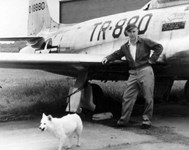 Glenn M. Fisher grew up in Liberty, Nebraska and worked as an inspector at the Martin Bomber Plant in Omaha, Nebraska during World War II. He joined the Civil Air Patrol and became the commanding officer of his squadron. Fisher wrote a curriculum for a course in airplane and engine mechanics for the University of Omaha and taught the first session of the course. In 1944 he earned his pilot’s license and became a commercial pilot and flight instructor. After the war, Fisher started a flying school in Kansas and did aerial photography. From 1970 until his death, he served as Accident Prevention Counselor for the Federal Aviation Administration. In 1980 he was named General Aviation Flight Instructor of the Year.
Glenn M. Fisher grew up in Liberty, Nebraska and worked as an inspector at the Martin Bomber Plant in Omaha, Nebraska during World War II. He joined the Civil Air Patrol and became the commanding officer of his squadron. Fisher wrote a curriculum for a course in airplane and engine mechanics for the University of Omaha and taught the first session of the course. In 1944 he earned his pilot’s license and became a commercial pilot and flight instructor. After the war, Fisher started a flying school in Kansas and did aerial photography. From 1970 until his death, he served as Accident Prevention Counselor for the Federal Aviation Administration. In 1980 he was named General Aviation Flight Instructor of the Year.
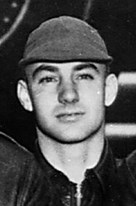 Sgt. Donald E. Fitzmaurice was born in Lincoln, Nebraska in 1919. After graduation from St. Mary’s Cathedral High School in Lincoln in 1937, he attended the University of Nebraska-Lincoln. During World War II he served in the 95th Bomb Squadron–17th Bombardment Group, U.S.A.A.F., and was a major participant in the first significant American success against the Japanese. In this daring, daylight raid on Tokyo, Japan, he served as an Engineer-Gunner on a B-25, that bombed Tokyo under anti-aircraft fire. The “Green Hornet” ran out of fuel before reaching the China coast and crashed. Fitzmaurice drowned in the China Sea. Historians have credited this mission with prematurely pushing the Japanese Navy into a disasterous attack on Midway, a defeat considered to be a turning point in World War II. His Aviation Awards include Distinguished Flying Cross, Purple Heart, American Defense Service Medal, American Campaign Medal, Asiatic-Pacific Campaign Medal, World War II Victory Medal, and the Chinese Breast Order of Yung Hui.
Sgt. Donald E. Fitzmaurice was born in Lincoln, Nebraska in 1919. After graduation from St. Mary’s Cathedral High School in Lincoln in 1937, he attended the University of Nebraska-Lincoln. During World War II he served in the 95th Bomb Squadron–17th Bombardment Group, U.S.A.A.F., and was a major participant in the first significant American success against the Japanese. In this daring, daylight raid on Tokyo, Japan, he served as an Engineer-Gunner on a B-25, that bombed Tokyo under anti-aircraft fire. The “Green Hornet” ran out of fuel before reaching the China coast and crashed. Fitzmaurice drowned in the China Sea. Historians have credited this mission with prematurely pushing the Japanese Navy into a disasterous attack on Midway, a defeat considered to be a turning point in World War II. His Aviation Awards include Distinguished Flying Cross, Purple Heart, American Defense Service Medal, American Campaign Medal, Asiatic-Pacific Campaign Medal, World War II Victory Medal, and the Chinese Breast Order of Yung Hui.
 Donald Boyd Fitzwater, born in Filley, Nebraska, was the youngest airport manager in Nebraska when he became manager of the Beatrice airport in 1954, at age twenty-three. He was a squadron commander for the Civil Air Patrol from 1949-1959. Fitzwater earned his private pilot’s license in 1951 and logged more than 4,000 hours. In 1993, the Beatrice Airport was named General Aviation Airport of the Year by the Nebraska Department of Aeronautics. Fitzwater helped organize the Flying Connestogas in 1968.
Donald Boyd Fitzwater, born in Filley, Nebraska, was the youngest airport manager in Nebraska when he became manager of the Beatrice airport in 1954, at age twenty-three. He was a squadron commander for the Civil Air Patrol from 1949-1959. Fitzwater earned his private pilot’s license in 1951 and logged more than 4,000 hours. In 1993, the Beatrice Airport was named General Aviation Airport of the Year by the Nebraska Department of Aeronautics. Fitzwater helped organize the Flying Connestogas in 1968.
He is credited with inventing the Fitzhook, a tie-down for aircraft, and the Evaring, a recycled rubber weed control and erosion barrier for runways. He also served as one of Nebraska’s first Weather Observers. Retired in 1999, he held the Nebraska record for managing the same airport for the most consecutive years. After retirement, he was appointed to the Beatrice Airport Authority, where he served as Chairman.
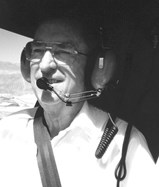 Chester H. Fliesbach served as a naval aviator from 1941 through 1945 and was awarded the Distinguished Flying Cross with seven stars. As the co-owner of the West Nebraska Express, he flew Beechcraft Bonanzas and Barons during the twenty-six years of operation. Fliesbach served for fifteen years as a member of the Nebraska Aeronautics Commission. He helped found the Panhandle Soarers Glider Club. In 1995, at age 77, he qualified as a helicopter pilot. He logged more than 10,440 hours in the air and held instrument, instructor, single and multi-engine land, sailplane, and helicopter ratings.
Chester H. Fliesbach served as a naval aviator from 1941 through 1945 and was awarded the Distinguished Flying Cross with seven stars. As the co-owner of the West Nebraska Express, he flew Beechcraft Bonanzas and Barons during the twenty-six years of operation. Fliesbach served for fifteen years as a member of the Nebraska Aeronautics Commission. He helped found the Panhandle Soarers Glider Club. In 1995, at age 77, he qualified as a helicopter pilot. He logged more than 10,440 hours in the air and held instrument, instructor, single and multi-engine land, sailplane, and helicopter ratings.
 Roy Furstenberg manufactured the first commercial airplane in Omaha, Nebraska. Furstenberg's Prettiest Mile Airways, forerunner to his Overland Airways, was located at today's entrance to Eppley Airfield and started with a handful of planes. But it was the Overland Sport, a two-seat training and sport plane that put Furstenberg's company on the map in the 1920s. The company designed, tested, promoted, and sold the plane, said by one pilot to be "the sweetest little flying ship he had ever handled."
Roy Furstenberg manufactured the first commercial airplane in Omaha, Nebraska. Furstenberg's Prettiest Mile Airways, forerunner to his Overland Airways, was located at today's entrance to Eppley Airfield and started with a handful of planes. But it was the Overland Sport, a two-seat training and sport plane that put Furstenberg's company on the map in the 1920s. The company designed, tested, promoted, and sold the plane, said by one pilot to be "the sweetest little flying ship he had ever handled."
Furstenberg's enterprises included an aircraft engine mechanics school, which soon became a major player in engine rebuilding. The company thrived until 1929, but did not survive the ravages of the Great Depression.
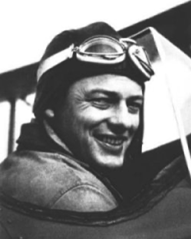
“Rule books are paper – they will not cushion a sudden meeting of stone and metal.”
Born in Lincoln Nebraska, educated at Culver Military Institute and attending Yale University, Ernest Kellogg Gann was an American author, aviator, sailor, conservationist and gypsy. Gann’s aviation themed writings include Fate is the Hunter, The High and the Mighty, The Aviator and In the Company of Eagles.
Gann’s writings were real and fictional memoirs of his flying and nautical adventures.
Gann learned to fly, by purchasing a Stinson Reliant then moving to a Waco A. Gann found part time work as a flight instructor and charter pilot writing short stories during his down time.
Gann was hired as a First Officer with American Airlines on the Douglas DC-2 and DC-3 aircraft. During WWII, as airline pilots and aircraft were absorbed into the United States Army Air Forces, Air Transport Command, Gann volunteered to join this group. Flying Douglas DC-3s, C-47s, C-54s and the Consolidated C-87 Liberator Express out of Gander, Newfoundland, Goose Bay, Labrador, and Presque Isle, ME flying the North Atlantic route to Europe. Then to Natal, Brazil flying routes in the South Atlantic, and finally to Chabua, India flying the famed treacherous Burma Hump.
After hostilities ended, Gann returned to American Airlines however the domestic routes no longer held Gann’s interest and when offered a position with the newly formed Matson Airlines by E.L. “Slonnie” Sloniger (1), Matson’s Chief Pilot. Gann flew the Western Pacific triangle between, San Francisco, Honolulu, and Los Angeles in DC-4 aircraft.
After Matson Airlines went under, Gann devoted his time to writing, sailing, art, and other personal pursuits.
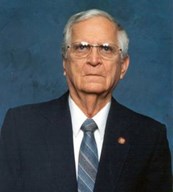 William Gasper was born in Omaha, Nebraska on March 28, 1928. Graduating from South High School, Omaha in 1945, he received an Associate Engineering Degree in 1949 from the University of Omaha and then earned a B S Degree in Electrical Engineering from the University of Nebraska, Lincoln in 1951. He joined Allis-Chambers in Milwaukee, WI from 1951 to 1952 with graduate training courses for electrical engineers. He entered the U.S. Air Force in 1953, receiving a direct commission as a 2nd Lt. where he was a Communications Officer. After the Air Force, Gasper worked for E.A. Pedersen Co. doing electrical switch gear design. He accepted a position with Westinghouse in 1954 as a Test Engineer for the J40/J46 jet engines used in Navy fighter aircraft. Gasper worked for Trans World Airlines (TWA) from 1955 to 1983 where his focus was developing electrical specifications for new commercial aircraft. Some of his major accomplishments include: developed the installation design for an engine dual fire detection system on commercial aircraft; authored the “SWAMP” Report now recognized as MIL-W-5088 Military Wiring Manual and Commercial Aircraft Specification; consulted with NASA bidders who were developing the space shuttle and consulted with Admiral Eaton in Washington D.C. on Naval aircraft catastrophic wire failures. The Navy subsequently banned a type of wire from future use on naval aircraft. Gasper left TWA in 1983 for Hughes Helicopters where he developed the wiring system hardware and installation design for the Longbow Apache helicopter, with emphasis on shielding for 200 volt/meter environments. During Gasper’s career, he became recognized as a national and international authority in the avionics area of aircraft wiring construction and connector interfaces. Mr. Gasper has enhanced both commercial and military aircraft safety by influencing the development and selection of wire constructions that are not vulnerable to catastrophic failure.
William Gasper was born in Omaha, Nebraska on March 28, 1928. Graduating from South High School, Omaha in 1945, he received an Associate Engineering Degree in 1949 from the University of Omaha and then earned a B S Degree in Electrical Engineering from the University of Nebraska, Lincoln in 1951. He joined Allis-Chambers in Milwaukee, WI from 1951 to 1952 with graduate training courses for electrical engineers. He entered the U.S. Air Force in 1953, receiving a direct commission as a 2nd Lt. where he was a Communications Officer. After the Air Force, Gasper worked for E.A. Pedersen Co. doing electrical switch gear design. He accepted a position with Westinghouse in 1954 as a Test Engineer for the J40/J46 jet engines used in Navy fighter aircraft. Gasper worked for Trans World Airlines (TWA) from 1955 to 1983 where his focus was developing electrical specifications for new commercial aircraft. Some of his major accomplishments include: developed the installation design for an engine dual fire detection system on commercial aircraft; authored the “SWAMP” Report now recognized as MIL-W-5088 Military Wiring Manual and Commercial Aircraft Specification; consulted with NASA bidders who were developing the space shuttle and consulted with Admiral Eaton in Washington D.C. on Naval aircraft catastrophic wire failures. The Navy subsequently banned a type of wire from future use on naval aircraft. Gasper left TWA in 1983 for Hughes Helicopters where he developed the wiring system hardware and installation design for the Longbow Apache helicopter, with emphasis on shielding for 200 volt/meter environments. During Gasper’s career, he became recognized as a national and international authority in the avionics area of aircraft wiring construction and connector interfaces. Mr. Gasper has enhanced both commercial and military aircraft safety by influencing the development and selection of wire constructions that are not vulnerable to catastrophic failure.
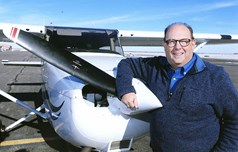 Terry L. Gibbs, grew up on a farm near Orchard, NE. Following high school graduation, Terry spent a year at community college, then enrolled in the University of Nebraska-Lincoln electrical engineering program. He graduated in 1979, accepting a position with a defense contractor in Scottsdale, AZ. In 1984 he received his master’s degree in electrical engineering from Arizona State University, also earning his pilot’s license and became a Certificated Flight Instructor.
Terry L. Gibbs, grew up on a farm near Orchard, NE. Following high school graduation, Terry spent a year at community college, then enrolled in the University of Nebraska-Lincoln electrical engineering program. He graduated in 1979, accepting a position with a defense contractor in Scottsdale, AZ. In 1984 he received his master’s degree in electrical engineering from Arizona State University, also earning his pilot’s license and became a Certificated Flight Instructor.
Terry joined a co-worker at Deer Valley Aviation, providing flight instruction when they were not on the clock at Motorola’s Government Electronics Group. Deer Valley grew from three planes to 13 planes, and Terry acquired his aircraft mechanic and airline transport pilot certifications. At its height, the fleet had 72 aircraft, offering training for commercial airlines and conducting charter flights across North and Central America.
In 1992, Terry and his wife, Deb, moved back to Nebraska where Terry joined the University of Nebraska at Kearney. He also spent 16 years as a pilot and director of training for Midway Aviation, based at the Kearney Regional Airport. In 1995, Terry became a designated pilot examiner of which at that time there were fewer than 600 worldwide. Terry was named director of the UNK Aviation Program in August, 2001.
Terry is an exceptional aviator, instructor, mentor and aviation safety advocate. He brilliantly imparted his knowledge to hundreds of individuals in the aviation industry worldwide. These students are not only from rural Nebraska but international as well. His leadership has guided graduates to obtain careers on the flight decks of well-known airlines, corporate flight departments, chief pilots, check pilot and aviation directors of operation. His selfless dedication saw him speaking to aviation clubs and organizations, working with Boy Scouts for their Aviation Badges and sharing his enthusiasm for aviation to individuals of all ages.
Terry retired in 2019 from the University of Kearney Aviation program but remains on the faculty staff at the University.
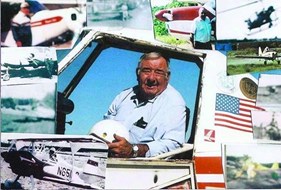 Alfred C. Glaser was born on November 25, 1929, on a small farm three miles west of Spalding, Nebraska. He came from a hard working family of seven children. Glaser began flying lessons in 1942 at the age of 12. He received his private license in 1947 and his commercial in 1950. After making plans to keep his flying service operating, he volunteered for Army Aviation and served in the Korean War from 1951 through 1953, where he operated and maintained helicopters. He was honorably discharged in 1953.
Alfred C. Glaser was born on November 25, 1929, on a small farm three miles west of Spalding, Nebraska. He came from a hard working family of seven children. Glaser began flying lessons in 1942 at the age of 12. He received his private license in 1947 and his commercial in 1950. After making plans to keep his flying service operating, he volunteered for Army Aviation and served in the Korean War from 1951 through 1953, where he operated and maintained helicopters. He was honorably discharged in 1953.
Glaser saw the need for rotor wing aircraft to be added with fixed wing aircraft as a tool in agriculture and took his skills and military background to his business. He was one of the first aerial applicators in the state and the first to use helicopters. The business grew to include aerial seeding, pollination and freeze prevention. Glaser Flying Service Inc. adopted the motto “Crop Care by Air”. The business continued to grow with: search & rescue, air ambulance, charter, predator control, fire control, instruction, aircraft sales & service and many new types of aerial application.
For many years, Glaser had a seven state distributorship for the North American Aircraft, which included aircraft sales, service, work with design and test flight of new equipment. He was instrumental in the start of the Nebraska Aviation Trades Association (NATA). He served as their President in 1964 and their Secretary-Treasurer in 1965. Glaser was a test pilot in the first Wide Area Spray Program (WASP), which proved that new generation aircraft could spray 10,000 acres per day with the Federal and State evaluators giving a 100% rating on coverage.
Glaser also holds certificates and ratings of instrument, single/multi engine land, commercial rotor wing and airframe and power plant with inspection authorization. In 1976, Senator J.J. Exon recognized Glaser as a true “Pioneer in Ag Aviation”. In 1981, he received the Airman of the Year Award from the Nebraska Aviation Trades Association. Glaser represented Nebraska as the Executive Secretary for the start of the National Agricultural Aviation Association (NAAA). In 2003, Glaser was the recipient of the prestigious Charles Taylor Award which is given for fifty continuous years in aviation maintenance. He has also been honored with the Wright Brothers’ Master Pilot Award for fifty years with no violations or accidents. At age 77, Alfred Glaser has spent over half a century as a commercial pilot along with being an STC holder. He is still flying and actively promoting aviation in Nebraska.
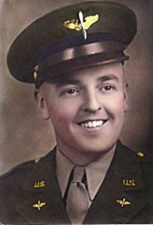 Lester Keith Glaze was born in Kearney, Nebraska on June 15, 1920. His love for flying began when his parents took him and his brother for a ride in a Ford Tri-motor in the early 1930’s. Glaze entered the Civilian Pilot Training program in 1940. After completing phase one, he was told to report to Omaha for a written test in the fall of 1942. Fifty young flyers took the test but only fourteen passed. He was then sent to Fort Crook (now Offutt Air Force Base) for a physical exam and told to go home and pack and expect a call to duty within a week or so.
Lester Keith Glaze was born in Kearney, Nebraska on June 15, 1920. His love for flying began when his parents took him and his brother for a ride in a Ford Tri-motor in the early 1930’s. Glaze entered the Civilian Pilot Training program in 1940. After completing phase one, he was told to report to Omaha for a written test in the fall of 1942. Fifty young flyers took the test but only fourteen passed. He was then sent to Fort Crook (now Offutt Air Force Base) for a physical exam and told to go home and pack and expect a call to duty within a week or so.
Glaze received his pilot wings at Chickasha, Oklahoma, after training in Coffeyville, Kansas with the Wilson-Bonfils Flying School. Glaze was in the Air Transport Command in the China-Burma-India Theater of Operation during World War II. For his service there, he was awarded the Chinese Pilot Wings. He was part of the group that flew C46 and C47 planes over the “Hump”. Glaze remained in this theater until December 1945.
As an Air Force reservist, Glaze was recalled to support the Korean War effort as a pilot. Colonel Glaze wears the Distinguished Flying Cross and Air Medal among his many service awards and decorations. He retired from Offutt Air Force Base and is the longest living member of the Offutt Officers’ Club.
Glaze was very active in the Civil Air Patrol (CAP) in Central Nebraska. He provided much of his personal resources and time including the purchase and moving of an old rural school to the Broken Bow Airport for CAP meetings, emergency management and communications facility. He and his wife, Maxine, hosted several International Exchange Cadets from Germany and other countries. He also provided service for numerous Aerospace Education training seminars for teachers and CAP members. Glaze also coordinated Air Force airlift flights to further the CAP missions in Nebraska and surrounding states.
Glaze served on the Broken Bow Airport Authority for several years and was primarily responsible for the many upgrades to the airport and terminal services building.
Keith Glaze also served as Chairman of the Custer County Republican Committee, the Hump Pilots Association, the Air Force Association and was a charter member of the Broken Bow Elks.
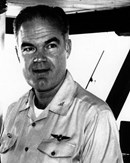 Capt. Earl F. Godfrey, retired U.S. Navy pilot with thirty-four years of service, saw combat action in World War II, the Korean Conflict, and the Viet Nam War. He logged more than 6,000 hours in fighter aircraft. Graduating first in his class at Test Pilot School, he test piloted and helped develop many small jets in the 1950s. He had a significant impact on the development of jet airplanes and their use by the U.S. Navy.
Capt. Earl F. Godfrey, retired U.S. Navy pilot with thirty-four years of service, saw combat action in World War II, the Korean Conflict, and the Viet Nam War. He logged more than 6,000 hours in fighter aircraft. Graduating first in his class at Test Pilot School, he test piloted and helped develop many small jets in the 1950s. He had a significant impact on the development of jet airplanes and their use by the U.S. Navy.
Godfrey combined skills as an aviator and sailor with leadership abilities, serving as Executive Officer of the aircraft carrier USS Ticonderoga, commanding the aircraft carrier USS Kittyhawk, and serving as Chief of Staff for the 7th Fleet. He also commanded two squadrons of A-4 Skyhawks, VA55 and VA125. He received numerous military aviation medals, decorations, citations, and awards.
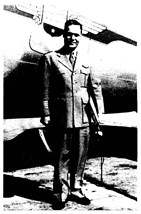 “No need to worry about (Gurney) – Clear head – Steady nerves – Agile as a monkey” is how lifelong friend Charles (Slim) Lindbergh described our honoree, Harlan (Bud) Gurney.
“No need to worry about (Gurney) – Clear head – Steady nerves – Agile as a monkey” is how lifelong friend Charles (Slim) Lindbergh described our honoree, Harlan (Bud) Gurney.
Bud Gurney’s aviation carrier began working at the Lincoln Standard Aircraft Company, Lincoln, Nebraska while earning money to attend high school by cleaning the factory floor and sorting tools. Eventually Gurney worked on the assembly line while learning engine work. Seeing the potential and under the tutelage of factory manager, Otto Timm, Gurney and another young gentleman by the name of Charles A. Lindbergh were invited to accompany Timm on test flights. Gurney subsequently began taking flying lessons.
Several years later after gaining flying experience, Lindbergh invited Gurney to join him barnstorming around the Midwest with Gurney performing a wing walking act and exhibition parachute jumps. Gurney became quite proficient in the performance of maintenance on the air circus aircraft between shows.
In 1926, Robertson Aircraft Company won the government contract to fly mail between St Louis and Chicago. Gurney was hired by Charles Lindbergh, the chief pilot, to rebuild and maintain the company aircraft, but it wasn’t long before Gurney was in the cockpit flying the mail. Eventually Robertson was absorbed by Universal Airlines for which Gurney was the district flight manager. He then worked for Transcontinental Air Transport later becoming Trans World Airlines. At the age of 27, he signed on as a Captain with United Airlines.
During World War II, Gurney flew for the Air Transport Command in Alaska and around the Pacific. Following the War he rejoined United Airlines. Years later, Gurney was the most Senior Captain on the line to transfer from the Douglas prop fleet to the DC-8 jet. Gurney retired in 1965. Holding an Airframe and Engine Certificate earned in 1952, He enjoyed repairing, maintaining and flying vintage aircraft and assisting others in that endeavor. Although Harlan (Bud) Gurney never did graduate from high school, he was one of those of his generation that even though they lacked formal education, excelled in and grew with their chosen profession.
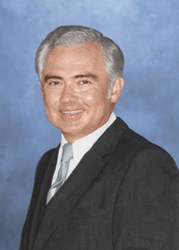 Dr. William A. "Bill" Hamilton, while serving as an aide to Governor Charles Thone in 1979-1980, worked with then Aeronautics Director, Wayne Andersen, to insure the Nebraska Department of Aeronautics was maintained as a cabinet-level department. In 1989, appointed by Governor Kay Orr, Hamilton served on the Nebraska Aeronautics Commission until 1992. A private pilot since 1968, he knew that General Aviation's greatest need was weather dissemination. Consequently, he strongly supported the installation of weather-information kiosks at public airports across Nebraska. Nebraska became the national leader in accessible, free-to-the-user and on-line aviation weather systems. He served a one-year term as the chairman of the Nebraska State Airline Commission. Proud of Nebraska's award-winning Navigational Aids Division, Hamilton worked to increase its funding and expand Nebraska's ownership, installation and maintenance of a state-wide system of navigational and weather systems. Hamilton fully supported the revolving hangar-loan program and use of surplus funds for EPA/NDEQ-approved aerial-spray pads at public airports.
Dr. William A. "Bill" Hamilton, while serving as an aide to Governor Charles Thone in 1979-1980, worked with then Aeronautics Director, Wayne Andersen, to insure the Nebraska Department of Aeronautics was maintained as a cabinet-level department. In 1989, appointed by Governor Kay Orr, Hamilton served on the Nebraska Aeronautics Commission until 1992. A private pilot since 1968, he knew that General Aviation's greatest need was weather dissemination. Consequently, he strongly supported the installation of weather-information kiosks at public airports across Nebraska. Nebraska became the national leader in accessible, free-to-the-user and on-line aviation weather systems. He served a one-year term as the chairman of the Nebraska State Airline Commission. Proud of Nebraska's award-winning Navigational Aids Division, Hamilton worked to increase its funding and expand Nebraska's ownership, installation and maintenance of a state-wide system of navigational and weather systems. Hamilton fully supported the revolving hangar-loan program and use of surplus funds for EPA/NDEQ-approved aerial-spray pads at public airports.
In 1991, inspired by North Dakota's Upper Mid-West Aviation Symposium, Hamilton worked with the charter members to establish the Nebraska Aviation Council and Symposium. He remained a faithful attendee, speaker and contributor at annual conferences.
In 1987, Bill became Regional Representative for AOPA. For the next 24 years, Hamilton defended General Aviation in as many as seven states, working with state and local officials to defend airports against residential housing encroachment or closure and with state legislatures to improve state funding for airports. It was his mission to defend against legislation harmful to General Aviation.
For a quarter-century, Hamilton served as a featured commentator for USA Today, writing for the editorial pages. His nationally syndicated column "Central View," still appears in print and on-line. In 2014, he was inducted into the Oklahoma Journalism Hall of Fame. Among Hamilton's military honors are: the Silver Star, the Distinguished Flying Cross, the Legion of Merit, 20 Air Medals, four Bronze Stars, the Purple Heart, Army and Air Force Commendation Medals, and the Master Parachutist Badge. Bill has been inducted into the Colorado Aviation Hall of Fame, the University of Oklahoma Army ROTC Wall of Fame, North Dakota Aeronautics Council Outstanding Service Award and the University of Nebraska's Alumni Achievement Award. Bill co-holds a World Aviation Speed Record with wife Penny.
Hamilton received his education at the University of Oklahoma, the Army Language School, the George Washington University, the U.S Naval War College, the University of Nebraska (Ph.D.), and Harvard University.
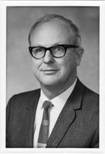 Rolland (Rollie) A. Harr was born in Ainsworth, Nebraska on July 4, 1918 and was raised by his grandparents. He attended Ainsworth and Chadron elementary schools but graduated from Chadron High. He then attended three years of college at Chadron State. It was here that Rollie learned to fly in a Federal civil pilots’ course and flying became his passion. Harr finished college with an additional semester at Omaha University for secondary training and then went to Hastings College for both a flight instructor and commercial pilot’s license.
Rolland (Rollie) A. Harr was born in Ainsworth, Nebraska on July 4, 1918 and was raised by his grandparents. He attended Ainsworth and Chadron elementary schools but graduated from Chadron High. He then attended three years of college at Chadron State. It was here that Rollie learned to fly in a Federal civil pilots’ course and flying became his passion. Harr finished college with an additional semester at Omaha University for secondary training and then went to Hastings College for both a flight instructor and commercial pilot’s license.
He and his wife, Faye, and their son relocated to Chadron where Rollie taught ROTC flight school. When he went to Army Flight School during WWII, he had already accumulated more hours instructing than his instructors had time in the air.
Harr’s career in Nebraska aviation included the position of Nebraska’s state pilot in the mid 1940's. He gradually became involved in the problems of the State Aeronautics Commission. He became secretary of the Aeronautics Commission in 1943, which was the forerunner of the State Department of Aeronautics. Fourteen years later, he became the head of the department. The department supervised the use of revenues from the state aviation gas tax, supervised and approved airport improvements and gave final word on all airport programs. This led to the direct operation of five former Air Force bases which Nebraska took over following WWII. Harr took an active role in a decision made by a seven-state regional Civil Aeronautics Board which boosted Nebraska air service to third in the nation. Seventeen of Nebraska’s cities had air service. This experience qualified Harr to head a newly created Airport Authority director position in Lincoln.
His beginning salary was $7,800 a year in 1959. At that time, the airport was operating out of an old office at Union Airport. Harr was instrumental in moving Lincoln’s general aviation operation to it’s present location. It was the country’s first use of a SAC military base with civilian runways. Two railroads and a highway were moved to make way for the 4000 foot runway and the general aviation terminal which opened in 1960. The Authority’s budget the first year was $90,000 but by the time Harr retired the annual budget exceeded $20 million.
During his time as director, Harr developed the industrial park, built a new terminal, had to deal with an air traffic controllers’ strike, fare differentials that drew travelers to Omaha and even took his turn on a snow plow if necessary.
After retiring in 1983, Harr remained active behind the scenes until he and his wife moved to Phoenix, Arizona in 1989. Harr still lives at Sierra Winds retirement home. He is as active as his 91 years will allow.
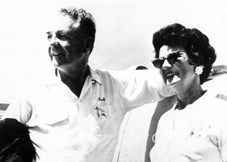 Earl and Pauline Hawks founded an airport on the family farm near Bruning, Nebraska, where Earl was born in 1906. He and Pauline were married in 1939, two years before Earl went on active duty in the Civil Air Patrol to fly coastal patrol. He transitioned into P-51 Mustangs to protect the continental U.S. from Japanese attack during World War II. Upon discharge in 1947, Earl returned to Nebraska and bought his first airplane, a Piper J-3 Cub. A hanger and landing strip were built across the road from the house and “Hawks Field” was developed east of the spot where Earl’s father first broke forty acres of native sod and sowed the first winter wheat in Thayer County. Pauline was Nebraska Flying Farmer and Rancher’s first queen in 1951 and their first Woman of the Year in 1971. Earl’s awards include the Advancement of Rural Aviation, the Nebraska Hospitality Award and the Nebraska Flying Farmer of the Year. With their flight school and crop spraying business, Earl and Pauline accumulated more than 27,000 and 1,800 flight hours respectively.
Earl and Pauline Hawks founded an airport on the family farm near Bruning, Nebraska, where Earl was born in 1906. He and Pauline were married in 1939, two years before Earl went on active duty in the Civil Air Patrol to fly coastal patrol. He transitioned into P-51 Mustangs to protect the continental U.S. from Japanese attack during World War II. Upon discharge in 1947, Earl returned to Nebraska and bought his first airplane, a Piper J-3 Cub. A hanger and landing strip were built across the road from the house and “Hawks Field” was developed east of the spot where Earl’s father first broke forty acres of native sod and sowed the first winter wheat in Thayer County. Pauline was Nebraska Flying Farmer and Rancher’s first queen in 1951 and their first Woman of the Year in 1971. Earl’s awards include the Advancement of Rural Aviation, the Nebraska Hospitality Award and the Nebraska Flying Farmer of the Year. With their flight school and crop spraying business, Earl and Pauline accumulated more than 27,000 and 1,800 flight hours respectively.
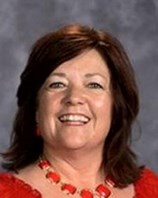 For Terri Haynes, a small western Nebraska airport has come with a variety of aviation opportunities. Terri began as a Certified Flight Instructor at Chadron in 1982 which she continues today. Terri taught many local students, and several have continued a career in aviation. In addition to flight instructing, she has had many experiences in pilot services such as aerial photography, fire spotting, aerial surveillance, aircraft ferrying, and numerous airplane rides for youth. Additionally, she has given many youth groups airport tours and served as a classroom speaker on many occasions.
For Terri Haynes, a small western Nebraska airport has come with a variety of aviation opportunities. Terri began as a Certified Flight Instructor at Chadron in 1982 which she continues today. Terri taught many local students, and several have continued a career in aviation. In addition to flight instructing, she has had many experiences in pilot services such as aerial photography, fire spotting, aerial surveillance, aircraft ferrying, and numerous airplane rides for youth. Additionally, she has given many youth groups airport tours and served as a classroom speaker on many occasions.
Upon completion of her Master’s Degree from Chadron State College, Terri became instrumental in forming the Airway Science program at Chadron State College and served as the faculty member for this program.
Appointed by Governor Ben Nelson, she served on the Nebraska Aeronautical Commission for seven years and proudly represented western Nebraska. Next Terri served on the Nebraska Airport Planning Committee for the Nebraska Department of Aeronautics. The many trips to Lincoln allowed her to take along her favorite co-pilot……Dad.
In 1990, her dad, Harold Perkins, decided to complete his private pilot certificate under her instruction. To date, they have not found another flight instructor-student combination of “daughter teaches father to fly.”
The local airline provided another aviation opportunity where Terri worked as station manager for over twenty years. The City of Chadron asked her to step up and serve as their Airport Manager which she did while also managing the airline.
Most recently, Terri spearheaded the 2018 Nebraska State Fly-In, a two-year volunteer commitment. The rather small facility packed in a highly successful weekend full of aviation entertainment for both pilots and the general public.
Terri has served many years on the Chadron Airport Zoning Board, Chadron Airport Advisory Board and AOPA Airport Support Network Volunteer and Certified Weather Observer. She is also a member of the Scottsbluff EAA Chapter 608.
Terri is strongly civic minded and has a strong sense of community. Her contributions to community are reflected in her awards: AKSARBEN Good Neighbor Award, Chadron Citizen of the Year, and Nebraska School Board Member of the Year.
Haynes received her education and flight training at Chadron State College and Fort Hays State University, Hays, KS. She has accumulated nearly 3000 hours of flight time with more than 1500 as a CFI. Terri routinely hosts local airport breakfasts at her home airport and enjoys visiting with the aviators and guests while she cooks their eggs to order.
 William B. Heilig, known as “Scottsbluff’s Mr. Aviation,” served for many years as manager of the city’s airport, Scottsbluff, Nebraska named its airport for him. Heilig, born in Lincoln, saw military service in World War II in the United States Army Air Force as a primary flight instructor, a teaching role he continued as a civilian.
William B. Heilig, known as “Scottsbluff’s Mr. Aviation,” served for many years as manager of the city’s airport, Scottsbluff, Nebraska named its airport for him. Heilig, born in Lincoln, saw military service in World War II in the United States Army Air Force as a primary flight instructor, a teaching role he continued as a civilian.
Heilig concentrated his efforts to promote aviation in western Nebraska. A charter member of the Aircraft Owners and Pilots Association and the Experimental Aircraft Association (EAA), he fostered aeronautical groups by helping organize the first flying club at the Scottsbluff, Nebraska airport and local chapters of the EAA and the Panhandle Soarers Glider Club. Heilig’s public service also included the presidency of the Nebraska Association of Airport Officials.
 Edward F. Hladovcak ferried wounded soldiers in the China-Burma-India Theater during World War II and took part in the first helicopter combat rescue in aviation history. Hladovcak and three wounded passengers crashed in the Burmese jungle one hundred miles behind Japanese lines. An experimental YR-4 helicopter, flown by Lt. Carter Harman, took two days (April 25-26, 1944) to transport Hladovcak and the three to safety.
Edward F. Hladovcak ferried wounded soldiers in the China-Burma-India Theater during World War II and took part in the first helicopter combat rescue in aviation history. Hladovcak and three wounded passengers crashed in the Burmese jungle one hundred miles behind Japanese lines. An experimental YR-4 helicopter, flown by Lt. Carter Harman, took two days (April 25-26, 1944) to transport Hladovcak and the three to safety.
After the war Hladovcak ran a flying service, called “Sandhills Airways,” at Neligh and Gordon, Nebraska. In the 1960s he worked as a flight trainer instructor for the U.S. Air Force and as a helicopter test pilot.
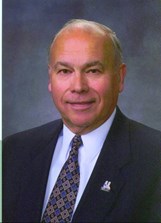 Ralph B. Holtmann was born in Brooklyn, New York on March 6, 1936. He attended school there and later traveled by subway to the Bronx to attend Manhattan College, where he graduated with a bachelor degree in civil engineering. He then received a commission as Second Lieutenant in the USAF.
Ralph B. Holtmann was born in Brooklyn, New York on March 6, 1936. He attended school there and later traveled by subway to the Bronx to attend Manhattan College, where he graduated with a bachelor degree in civil engineering. He then received a commission as Second Lieutenant in the USAF.
In March of 1959, Holtmann entered active duty and was assigned to Wright Patterson AFB, Ohio. In 1962, he was selected for an Air Force sponsored program specializing in construction of buildings and facilities in space and on the moon. The next several years were spent working with several construction squadrons in the States and a stint in Viet Nam. After Viet Nam, Holtmann was assigned to the 14th Aerospace Force in Colorado Springs where he worked with facilities throughout the world that were tasked with tracking man-made objects in space.
In 1973, Holtmann was assigned to the Headquarters of the Strategic Air Command at Offutt AFB, where he held several positions eventually being assigned to the Office of the Inspector General. Here he was charged with inspections of SAC bases for civil engineering organizations. In November 1979, Holtmann became the Base Civil Engineer at Offutt and was responsible for all facilities, including the runway, hangars, taxiways and buildings. He was responsible for the base master plan, which included converting historic base buildings for future use. These buildings were steeped in tradition and required a sensitive but practical approach. Holtmann was responsible for the planning, programming and development of one of the largest construction project, a maintenance facility to simultaneously house five specially modified RC-135 aircraft. Upon retiring from the Air Force in 1983, he was awarded the Legion of Merit for his efforts. In addition to the Legion of Merit, Holtmann received two Bronze Stars, four Meritorious Service Medals, Air Force Commendation Medal, Outstanding Unit Award with Valor and numerous service and campaign medals and ribbons during his career.
Holtmann then went to work for the Nebraska Department of Aeronautics as a Senior Engineer. He provided advice on planning projects and assistance during the construction of runways, taxiways, aprons and other facilities. He was the liaison between airport sponsors, their consultants and the Federal Aviation Administration.
In 1989, Holtmann became Director of Planning and Engineering for the Omaha Airport Authority. Eppley Airfield had one Category Two ILS and two Category One ILS systems when he started work there. Eppley now has two Category Three ILS approaches and will soon have four Category One ILS approaches. Two of these were installed by the Airport Authority but transferred to the FAA for operation and maintenance because of Holtmann’s ability to ensure their development.
Approximately $110 million of federal grants for development were acquired under Holtmann’s leadership. This included a state of the art communications center with access control and closed circuit television for the entire airport, expanded cargo aprons and facilities, a maintenance complex, numerous terminal projects, runway extension and a new runway with precision instrument approaches. The initial 7000 feet of construction for the new runway was scheduled as a three year project, but due to Ralph’s communications with the FAA, the contractors and engineers, the project was completed in just two years, and within the original budget. Upon his retirement, the Board of Directors entered a resolution in the records of the Omaha Airport Authority to commend Ralph’s efforts.
Upon retirement, Holtmann accepted a part time position with Lamp, Rynearson & Associates, Inc, where he continues to provide expertise for their airport team. Ralph and his wife, Pat, have raised four children and seven grandchildren and reside in Bellevue.
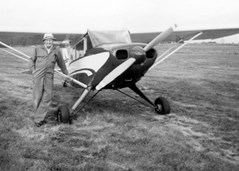 Leonard R. Hrouda, born in Clarkson, Nebraska in 1923, took his first flying lesson at age fifteen and completed a special Air Corps Cadet program during high school. After graduation from Clarkson High School, Hrouda attended the Cal-Aero Flight Academy in Ontario, Californiaand the University of Nebraska-Lincoln.
Leonard R. Hrouda, born in Clarkson, Nebraska in 1923, took his first flying lesson at age fifteen and completed a special Air Corps Cadet program during high school. After graduation from Clarkson High School, Hrouda attended the Cal-Aero Flight Academy in Ontario, Californiaand the University of Nebraska-Lincoln.
He served in the Army Air Corps as a single and multi-engine pilot from 1943-45. Hrouda established Great Plains Airways Air Taxi/Ambulance Service in Columbus, Nebraska. He also started the first aerial spraying service in Nebraska and offered aerial photo service. From 1948-56, he operated the Columbus airport. In fifty years, he logged more than 25,000 flight hours and instructed more than 500 students. He also served as a flight examiner for the Federal Aviation Administration and helped create the Nebraska Board of Aviation.
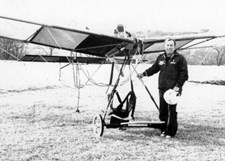 Marion “Shorty” Janousek, Nebraska parachutist and aerial balloon maker, began his career as a parachutist as a member of the U.S. Army 82nd Airborn Division in 1956. In his lifetime, Janousek made 3,849 jumps, mostly free-fall sky dives. In 1964 Janousek opened the Lincoln Parachute Loft for parachute repacking, repair, and sales. Through the Lincoln Parachute Club, he trained hundreds of Nebraskans to parachute.
Marion “Shorty” Janousek, Nebraska parachutist and aerial balloon maker, began his career as a parachutist as a member of the U.S. Army 82nd Airborn Division in 1956. In his lifetime, Janousek made 3,849 jumps, mostly free-fall sky dives. In 1964 Janousek opened the Lincoln Parachute Loft for parachute repacking, repair, and sales. Through the Lincoln Parachute Club, he trained hundreds of Nebraskans to parachute.
In 1986, Janousek was selected to do the rigging on a 425-foot, double aerial balloon designed to circle the globe. He was a long-time member of the Aircraft Owners and Pilots Association and the Experimental Aircraft Association. An accomplished pilot, parachutist and teacher, his favorite expression was, “...and now you know why the birds sing.”
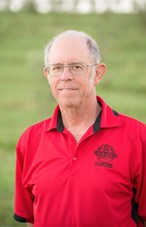 Dr. Jaworski pioneered hot air ballooning in Nebraska as the first native Nebraskan licensed to fly a hot air balloon. Between 1972 and 2017 he accrued over 2,800 hours of flight, carried over 7,000 passengers, and generated more than $360,000 for the benefit of charitable organizations.
Dr. Jaworski pioneered hot air ballooning in Nebraska as the first native Nebraskan licensed to fly a hot air balloon. Between 1972 and 2017 he accrued over 2,800 hours of flight, carried over 7,000 passengers, and generated more than $360,000 for the benefit of charitable organizations.
He is known worldwide for his enhancements to the double-walled hot air balloon in which he holds duration and distance world records. He developed techniques for high altitude balloon deployment of a manned hang glider; as well as high altitude long distance flights.
In addition to flying, winning, and organizing Nebraska competitive events, Dr. Jaworski is a frequent speaker at national ballooning seminars and Nebraska elementary schools.
As long-term President, charter member, and community coordinator for the Nebraska Balloon Club, he assists communities and charities in staging ballooning events.
He enjoys sharing the joy of flying with passengers of all ages. He actively seeks individuals with special needs and provides balloon flights to paraplegics, terminally ill, blind, and infirmed aged, who seek a new experience in life.
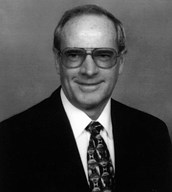 Al Jessen, Minden Airport Authority Chair for more than twenty years, worked to develop Pioneer Village Field by spearheading sixteen major improvement projects. He organized the 1996 Stinson and Experimental Aircraft Fly-in at Minden, giving special emphasis to the Young Eagles Program.
Al Jessen, Minden Airport Authority Chair for more than twenty years, worked to develop Pioneer Village Field by spearheading sixteen major improvement projects. He organized the 1996 Stinson and Experimental Aircraft Fly-in at Minden, giving special emphasis to the Young Eagles Program.
Jessen served as a flight instructor for more than fifty pilots and offered countless rides to local school children and adults. He served the state of Nebraska by flying University agricultural research teams and working with Nebraska Public Power to monitor Platte River water flow. He helped commercial firms develop computer-enhanced crop photos. He also consulted with Nebraska Educational Television, providing footage and expertise for news stories.
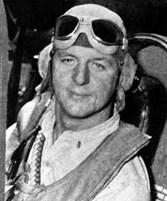 Byron M. Johnson, a U.S. Navy aviator, became the subject of one of the most dramatic and most published photographs of World War II. Johnson crash landed his Grumman F6F Hellcat onto the deck of the aircraft carrier U.S.S. Enterprise on November 10, 1943. Johnson’s life was saved by another officer, who was able to free him from the burning wreckage. Because of wartime censorship, the photograph and movie film were not released until January 1945. It has been used hundreds of times since then. Johnson, a Potter, Nebraska native, started an airport in Sidney, Nebraska after the war. He returned to school and became a lawyer in the Gering-Scottsbluff, Nebraska area.
Byron M. Johnson, a U.S. Navy aviator, became the subject of one of the most dramatic and most published photographs of World War II. Johnson crash landed his Grumman F6F Hellcat onto the deck of the aircraft carrier U.S.S. Enterprise on November 10, 1943. Johnson’s life was saved by another officer, who was able to free him from the burning wreckage. Because of wartime censorship, the photograph and movie film were not released until January 1945. It has been used hundreds of times since then. Johnson, a Potter, Nebraska native, started an airport in Sidney, Nebraska after the war. He returned to school and became a lawyer in the Gering-Scottsbluff, Nebraska area.
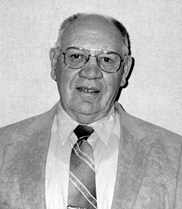 Donald I. Johnson, born on a ranch near Greeley, Nebraska, enrolled at the University of Omaha to study aviation maintenance after graduation from Scotia High School in 1941. He served as a crew chief on a C-47 troop carrier in the South Pacific. Johnson obtained his Aircraft and Engine rating at the Lincoln Aviation Institute. He learned to fly and worked for Lincoln Air Service and Prairie Air Ways.
Donald I. Johnson, born on a ranch near Greeley, Nebraska, enrolled at the University of Omaha to study aviation maintenance after graduation from Scotia High School in 1941. He served as a crew chief on a C-47 troop carrier in the South Pacific. Johnson obtained his Aircraft and Engine rating at the Lincoln Aviation Institute. He learned to fly and worked for Lincoln Air Service and Prairie Air Ways.
In 1961 the Johnsons moved to Wayne, Nebraska to establish Wayne Air Service, a full service, Fixed Based Operation that offered flight training, ground school, charter work, and aircraft maintenance. He also served as maintenance supervisor for Graham’s Flying Service in Sioux City. Johnson accepted an aviation maintenance instructor position at Western Nebraska Community College in Sidney, Nebraska in 1980. Upon retirement in 1990, he was the Designated Mechanics Examiner in the Panhandle, administering the oral and practical examinations and issuing the mechanic’s A&P Certificates.
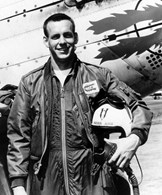 Lloyd L. Johnson, born in Oakdale, Nebraska, flew ninety-nine combat missions for the U.S. Army Air Force during World War II. Flying a P-47, Johnson shot down two German planes, one a Messerschmitt 262 jet fighter.
Lloyd L. Johnson, born in Oakdale, Nebraska, flew ninety-nine combat missions for the U.S. Army Air Force during World War II. Flying a P-47, Johnson shot down two German planes, one a Messerschmitt 262 jet fighter.
Johnson joined the Nebraska Air National Guard in 1949, an association spanning four decades. He saw three years of active duty during the Korean War, returned to Nebraska, and worked full-time with the Air Guard. He flew a variety of fighter and administrative aircraft, eventually becoming the chief support pilot. Johnson rose to the rank of Brigadier General before retiring in 1983.
 James E. Joyce was raised on a farm outside Atlantic, Iowa graduating from high school in 1958. He attended college, receiving his Airframe and Power Plant certificate. Over the next ten years he worked as a mechanic on corporate aircraft and rentals. During this time he received his Private Pilot certificate.
James E. Joyce was raised on a farm outside Atlantic, Iowa graduating from high school in 1958. He attended college, receiving his Airframe and Power Plant certificate. Over the next ten years he worked as a mechanic on corporate aircraft and rentals. During this time he received his Private Pilot certificate.
In 1969, James accepted a teaching position in the aviation maintenance department with Western Nebraska Vocational Technical School in Sidney, Nebraska. Jim retired from the school, now Western Nebraska Technical College, in May of 2006, ending a 36-year tenure. During that time Jim also served as a Division Chairman for the technical programs. In 1996, he was instrumental in the project to build a new aviation maintenance facility at the Sidney Airport. Jim and his aviation assistant moved all of the aircraft and equipment from the original location at the Sioux Army Depot to the Sidney Airport.
Jim held his Inspection Authorization for 25 plus years. He inspected and maintained many of the local aircraft. Jim was often times called for advice on resolving a challenging situation.
He was elected to two terms on the Sidney Airport Authority, and served as chairman for several years. Projects in which he was instrumental included the repaving of the main runway and a new 22,000 gallon fuel farm.
James E. Joyce is an aircraft mechanic, but first and foremost he is an educator. His sense of humor and watchful eye made him an excellent instructor. Jim’s willingness to share his wealth of knowledge made learning exciting and fun, leaving a lasting impression on those that had the pleasure of studying under him. It’s impossible to know for certain, but Jim may have taught well over 1,000 mechanics.
 Richard O. “Dick” Joyce, born in Lincoln, Nebraska in 1919, graduated from Lincoln High School and the University of Nebraska-Lincoln. He enlisted as a cadet in the Army Air Corps in 1941.During World War II, he served in the 95th Bomb Squadron–17th Bombardment Group, U.S.A.A.F., and was a major participant in the first significant American success against the Japanese. In this daring, daylight raid on Tokyo, Japan, he piloted one of the planes that bombed Tokyo under anti-aircraft fire. Historians have credited this mission with prematurely pushing the Japanese Navy into a disastrous attack on Midway, a defeat considered to be a turning point in World War II. After the war, he returned to Lincoln to run Henkle and Joyce Hardware Co. and fly as a general aviation pilot. Joyce was elected to the Lincoln Airport Authority and served on the board for twenty years. He delivered hundreds of speeches to groups of all types. When he died in 1983, a benefit airshow was held in his honor and a permanent memorial erected in the Lincoln Airport Terminal.
Richard O. “Dick” Joyce, born in Lincoln, Nebraska in 1919, graduated from Lincoln High School and the University of Nebraska-Lincoln. He enlisted as a cadet in the Army Air Corps in 1941.During World War II, he served in the 95th Bomb Squadron–17th Bombardment Group, U.S.A.A.F., and was a major participant in the first significant American success against the Japanese. In this daring, daylight raid on Tokyo, Japan, he piloted one of the planes that bombed Tokyo under anti-aircraft fire. Historians have credited this mission with prematurely pushing the Japanese Navy into a disastrous attack on Midway, a defeat considered to be a turning point in World War II. After the war, he returned to Lincoln to run Henkle and Joyce Hardware Co. and fly as a general aviation pilot. Joyce was elected to the Lincoln Airport Authority and served on the board for twenty years. He delivered hundreds of speeches to groups of all types. When he died in 1983, a benefit airshow was held in his honor and a permanent memorial erected in the Lincoln Airport Terminal.
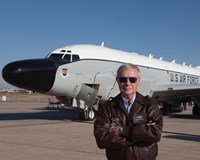 Roy C. Kessell, Lt. Col. USAF (Ret.) was born in Kansas City, Missouri, on July 29, 1946. At the age of eight, he knew he wanted to fly when his WWII veteran father took him to see the Blue Angels. Receiving several academic scholarships, Roy accepted an appointment to the United States Air Force Academy, majoring in Civil Engineering.
Roy C. Kessell, Lt. Col. USAF (Ret.) was born in Kansas City, Missouri, on July 29, 1946. At the age of eight, he knew he wanted to fly when his WWII veteran father took him to see the Blue Angels. Receiving several academic scholarships, Roy accepted an appointment to the United States Air Force Academy, majoring in Civil Engineering.
Graduating in the class of 1970, he was assigned to Laughlin AFB, Texas, where he earned pilot wings and served as an instructor pilot/check pilot in the supersonic T-38 Talon. As Assistant Wing Executive Officer, he managed all Wing inspection programs. His next operational assignment was to the 55th Strategic Reconnaissance Wing , Offutt AFB, flying the RC-135 as a Flight Commander, Instructor Pilot and Aircraft Commander on politically sensitive strategic reconnaissance missions. His last assignment was Operations Officer at Shemya AFB, Alaska, a remote Aleutian Island outpost.
In 1977 having studied meteorology at Texas A&M University, Roy’s duties at Offutt AFB included providing daily weather briefings to the Commander-in-Chief, Strategic Air Command. In addition, he developed tactics, plans and exercises for strategic reconnaissance assets (RC-135, U-2 and SR-71) worldwide.
Upon retiring from the U.S. Air Force with over 22 years of service, he earned his FAA Instructor Certificates and taught students at the Offutt Aero Club and Plattsmouth Municipal Airport. In 1999, Roy founded Flight! Nebraska Group with several flight instructors and aviation enthusiasts. He directed flight school operations that included students from the University of Omaha Aviation Institute’s Professional Flight Program and the U.S. Air Force Introductory Flight Training Program. He also served as the Plattsmouth Airport Manager.
Today, Colonel Kessell flies as an independent corporate pilot and flight instructor. He is an ATP rated pilot in the B-707, B-720, and CM-170 and holds a Gold Seal Flight Instructor Certificate. He has flown nearly 10,000 hours in over thirty different aircraft and given 5,000 hours of flight instruction.
Lt. Colonel Roy Kessell’s honors include the 2010 Nebraska Congressional District II Small Business Person of the Year Award; The Lt. Colonel Charles A. Lane Innovative Partnership Award from the Eastern Nebraska Community Action Partnership for creating opportunities for the underprivileged; five Meritorious Medals for service to the United States; and seven Air Medals for meritorious service while participating in aerial flight.
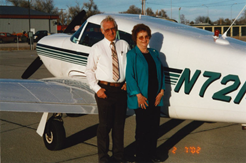 Robert (Bob) Kilmer has a long history of contributing to the advancement of aviation at Valentine, Nebraska.
Robert (Bob) Kilmer has a long history of contributing to the advancement of aviation at Valentine, Nebraska.
Bob had a deep interest in aviation from an early age. His interest grew as he attended an aviation class in high school and after graduation went on to enlist in the United States Air Force. He started flying lessons in 1952 in a Piper J-3 Cub. Upon leaving the Air Force in 1955 he attended Spartan Collage of Aeronautics and Technology in Tulsa, Oklahoma. He graduated with an Airframe and Powerplant Mechanic certificate went to work for Frontier Airlines as an A&P mechanic. He left Frontier in 1961 for a job as an aircraft mechanic with Sandhills Aero in Valentine, Nebraska. He went on to obtain his commercial pilot certificate, instrument, and flight instructor’s ratings and he purchased a share of Sandhills Aero. This began a long-time partnership with business partner, Willie Kerr. Together Bob and Willie operating the FBO providing a wide range of aviation services. This included aircraft maintenance aerial application, charter service and air ambulance. They made their first air ambulance flight in a Piper Tri-Pacer in 1964. They continued providing air ambulance service for 35 years. Willie retired in 1999. Bob was the recipient of the Charles Taylor Master Mechanic Award in 2003 and later he received the Wright Brothers Master Pilot Award.
Bob continues run Sandhills Aero with the help from his sons, Kelly and Willis, and his grandson Ryan who is an A & P with Inspection Authorization.
 Jack Knight was born March 14, 1892, in Lincoln Center, Kansas. He worked in Chicago as a mechanical engineer before joining the Army Air Service in 1917 as an instructor pilot. After the war, he hired on as an airmail pilot in Nebraska. A member of the First Christian Church in Omaha, Knight sang in the choir.
Jack Knight was born March 14, 1892, in Lincoln Center, Kansas. He worked in Chicago as a mechanical engineer before joining the Army Air Service in 1917 as an instructor pilot. After the war, he hired on as an airmail pilot in Nebraska. A member of the First Christian Church in Omaha, Knight sang in the choir.
In North Platte on February 22, 1921, Jack Knight awaited a relay airmail flight from California. He had just learned he would take part in an historic day-night continuous transcontinental airmail flight. Knight left for Omaha around 10:50pm. It began to snow near Kearney, but beacon fires set along the route by post office employees, airfield managers and farmers lighted the way.
As he approached Omaha’s Ak-Sar-Ben Field about 1:15am, burning fuel barrels marked the runway. The relief pilot from the east was grounded in Chicago. Never having flown the route from Omaha to Chicago, Knight studied a portion of a highway map he had torn off the office wall.
In a blizzard, the de Havilland DH-4B lifted off around 2:00am. Deep snow prevented Knight landing at Des Moines, forcing him to an emergency landing site lighted by railroad flares at Iowa City. He then flew toward Lake Michigan, which served as a “landmark” into Chicago. Knight landed at Checkerboard Field, 8:40am. Hundreds of people wanted to see if this daring young pilot had saved the future of day-night coast-to-coast airmail flight from political decommission.
When the Air Mail Service was reorganized later in 1921, Knight worked with the Postal Service and local civic leaders to set up an effective system of navigation beacons and emergency landing fields. At the outbreak of WWII, he worked in airway development and radio communications for the Civil Aeronautics Authority. An inspiring ambassador for aviation, Knight was inducted into the Michigan Aviation Hall of Fame as a recipient of the Spirit of Flight Award in 1999. He had flown United’s DC-3 passenger flights an impressive number of miles and retired from the company as Vice-President of Safety.
Jack Knight died February 24, 1945. His ashes were scattered over Lake Michigan. The flight jacket worn on his historic flight is displayed in the Lee Bird Terminal at North Platte.
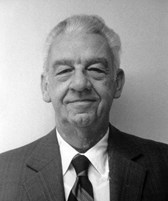 Walter J. Kreuscher served as Nebraska’s first official State Airport Engineer. A native of DeWitt, Nebraska, Kreuscher worked in 1942 as lead foreman when the Alliance Air Base was built. After military service during World War II, Kreuscher joined the fledgling Nebraska Department of Aeronautics as an engineer and embarked on extensive airport development. In 1958 he became the head of the Aeronautics Engineering Division.
Walter J. Kreuscher served as Nebraska’s first official State Airport Engineer. A native of DeWitt, Nebraska, Kreuscher worked in 1942 as lead foreman when the Alliance Air Base was built. After military service during World War II, Kreuscher joined the fledgling Nebraska Department of Aeronautics as an engineer and embarked on extensive airport development. In 1958 he became the head of the Aeronautics Engineering Division.
His thirty-three years with the department were marked by acquiring five surplus army airfields for municipal use; expanding an airport lighting program; installing radio navigation and weather stations across Nebraska; fostering improved hanger construction; and helping author the 1957 Airport Authorities Act, a law that financed future municipal airport development.
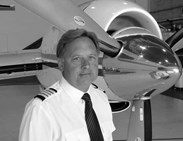 Robert J. Krist was born March 29, 1957 in Omaha, Ne. He graduated with honors from Creighton Preparatory School in Omaha in 1975. He then attended the University of St.Thomas in St. Paul, MN where he received a Bachelor of Arts degree in sociology. He then obtained a Master of Arts Degree in business administration and Human Relations from Webster University in St. Louis, MO in 1982.
Robert J. Krist was born March 29, 1957 in Omaha, Ne. He graduated with honors from Creighton Preparatory School in Omaha in 1975. He then attended the University of St.Thomas in St. Paul, MN where he received a Bachelor of Arts degree in sociology. He then obtained a Master of Arts Degree in business administration and Human Relations from Webster University in St. Louis, MO in 1982.
Krist served in the United States Air Force from 1979 to 2000 and retired as a Lt. Col. after flying more than 100 combat sorties.
Still an active pilot, Krist has flown more than thirty different fixed and rotary wing aircraft, logging over 14,000 hours.
During his 21 years in the Air Force, Krist held key leadership positions directing critical missions including the high visibility Looking Glass mission at Offutt Air Force Base in Bellevue, Ne. Krist scheduled operations and flew missions on the Looking Glass EC-135 aircraft, the Airborne Command Post for Strategic Air Command. When he retired he had flown all models of the RC-135 reconnaissance aircraft.
Among other operations, Krist served in both Operation Desert Shield and Desert Storm. His first Command was as an operational squadron commander flying combat reconnaissance sorties over Southwest Asia. In 1997, he was appointed as Chief of Plans and Programs for the 55th Wing at Offutt AFB where he coordinated Wartime Plans and Logistics Movements of over 4,000 personnel and billions of dollars of resources in the largest air wing in the United States Air Force.
In 1998, he was chosen as an Active Duty Air Force Advisor to then Nebraska Governor Ben Nelson and advised the Adjutant General of Nebraska.
Krist is a recipient of the Air Force Air Medal, Meritorious Service Medal, Air Force Commendation Medal, and the Aerial Achievement Medal among other honors.
He was appointed to the Nebraska Unicameral Legislature by Governor Dave Heineman on September 11, 2009. Krist is currently the Contract Manager for the United States Army Corps of Engineers Northwest Division Aviation Program and where he served as a pilot since 2000 and the Chief Pilot since 2002.
Senator Krist introduced and passed Legislative Bill 140 (LB 140) in 2013 to more accurately define an airport’s hazard area and extend the instrument approach zones from three to 10 miles at all Nebraska airports, thereby protecting the lives of pilots, their families and passengers, as well as those on the ground.
Senator Krist also co-sponsored LB 845 in 2014 to add an enforcement provision to the existing Meteorological Evaluation Tower (MET tower) laws and amend the required MET tower markings to correspond with those outlined in 76 Federal Register 36983 by the Federal Aviation Administration.
 John Kugler was born in McCook, NE on December 5, 1956. He earned an Associate of Arts from McCook Community College in 1977 and went on to earn his BSBA from the University of Denver in 1980.
John Kugler was born in McCook, NE on December 5, 1956. He earned an Associate of Arts from McCook Community College in 1977 and went on to earn his BSBA from the University of Denver in 1980.
John returned to his hometown to assist in the management of the family business, Kugler Company. He is now Marketing President with responsibilities of marketing functions in a five state area.
Kugler fell in love with hot air ballooning in 1978. He was first exposed to ballooning by a fellow worker who had a son who flew balloons and as Kugler says "the rest is history...". Since then his ballooning has taken him across Northern America and around the world with Steve Fossett on numerous occasions. He was a member of the Balloon Federation of America Gas Division from 1991 to 2006.
John has trained numerous pilots (including adventurer Steve Fossett) in the fundamentals of gas balloons utilizing ammonia as a lifting gas. He originally taught Fossett how to fly gas balloons and served on his core crew performing various tasks during Fossett’s solo around the world attempts, including Fossett’s successful flight in June 2002. Kugler’s other accomplishments include being the leading US pilot with experience in ammonia gas balloons; a builder of hot air and gas balloons and instructing and signing off Steve Fossett in Free Balloons. He is a key figure in the rebirth of gas ballooning in the United States and participed in the Virgin Global Challenger flights. He is also participating in the support and launching of the Celestial Eagle, a proposed Trans Pacific balloon flight that is in the development stages. In 1999 John and co-pilot Ralph "Red" Sheese placed 2nd after launching from Front Range Airport near Denver and landing near Boston, logging 1,710 miles in 67 non-stop hours. This qualified them in the 2000 International Gordon Bennett Cup in Belgium. The Coupe Aeronautique Gordon Bennett is the most prestigious event in aviation held annually around the world. During the 1980’s, McCook, NE was host to the McCook Balloon Blast featuring an amazing display of hot air balloons. Kugler has been the flight director and event organizer for the event for ten years. It continues to grow each year, becoming one of Nebraska’s most spectacular annual free family events. John is devoted to the advancement of knowledge in ballooning and teaching others that show interest and are willing to learn.
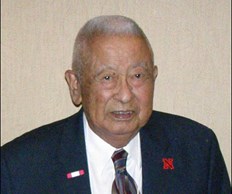 Ben Kuroki, a Japanese American, was born in the Gothenburg/Cozad area in 1917 but was raised near Hershey. After the bombing of Pearl Harbor, Ben volunteered to join the American Army but was turned down because of his heritage. He was later allowed to join the newly formed Army Air Corps, which thrilled Kuroki because he had been taking flying lessons before the war. He wanted to fly aerial warfare against Japan but knew he would never be the pilot, but hoped to be a gunner. Kuroki found his biggest enemy was racial prejudice. The military could not see beyond his Japanese heritage, but fortunately his crew members did. They even named two of their planes for him and walked en masse with him so that someone would not mistake him for the enemy. Kuroki was fighting two battles, one against America’s enemies and the other against racial bigotry. During World War II, he flew as a top gunner on B-24's in Europe and North Africa. Twenty-five missions meant a ticket home but Kuroki signed up for an additional five missions. He took part in one of the deadliest single air combat missions in the war, the low-level raid on the Ploesti oil refineries in Romania. After his thirty missions, he was sent back to the States to recruit Nisei men from the Japanese internment camps to join the 442nd Regiment, which became the most decorated American Army unit during the war. After that brief assignment, Kuroki requested and was granted the assignment he always wanted. He was cleared by Secretary of War, Henry Stimson, to fly as an aerial gunner in B-29's over Japan. He became the only Japanese-American aviator to fly missions directly against Japan and the first Japanese-American war hero. By the end of the war, Kuroki had completed twenty-eight air missions in the Pacific theater of war. With a total of 58 missions, he greatly surpassed the average air crew member’s, which was only ten to twenty-five. But Kuroki’s war was not over. He decided his 59th mission was to eliminate racial bigotry and to promote American patriotism. Almost all of his numerous speeches over the years have begun or ended with "I am the luckiest dude on this planet, because I was born in America and Nebraska."
Ben Kuroki, a Japanese American, was born in the Gothenburg/Cozad area in 1917 but was raised near Hershey. After the bombing of Pearl Harbor, Ben volunteered to join the American Army but was turned down because of his heritage. He was later allowed to join the newly formed Army Air Corps, which thrilled Kuroki because he had been taking flying lessons before the war. He wanted to fly aerial warfare against Japan but knew he would never be the pilot, but hoped to be a gunner. Kuroki found his biggest enemy was racial prejudice. The military could not see beyond his Japanese heritage, but fortunately his crew members did. They even named two of their planes for him and walked en masse with him so that someone would not mistake him for the enemy. Kuroki was fighting two battles, one against America’s enemies and the other against racial bigotry. During World War II, he flew as a top gunner on B-24's in Europe and North Africa. Twenty-five missions meant a ticket home but Kuroki signed up for an additional five missions. He took part in one of the deadliest single air combat missions in the war, the low-level raid on the Ploesti oil refineries in Romania. After his thirty missions, he was sent back to the States to recruit Nisei men from the Japanese internment camps to join the 442nd Regiment, which became the most decorated American Army unit during the war. After that brief assignment, Kuroki requested and was granted the assignment he always wanted. He was cleared by Secretary of War, Henry Stimson, to fly as an aerial gunner in B-29's over Japan. He became the only Japanese-American aviator to fly missions directly against Japan and the first Japanese-American war hero. By the end of the war, Kuroki had completed twenty-eight air missions in the Pacific theater of war. With a total of 58 missions, he greatly surpassed the average air crew member’s, which was only ten to twenty-five. But Kuroki’s war was not over. He decided his 59th mission was to eliminate racial bigotry and to promote American patriotism. Almost all of his numerous speeches over the years have begun or ended with "I am the luckiest dude on this planet, because I was born in America and Nebraska."
Kuroki served as an aviator in three theaters of war and four American Air Forces. During this time, he received three Distinguished Flying Crosses, an Air Medal with three Oak Leaf Clusters and the Distinguished Service Medal. He has been invited to the White House on four occasions between 2006-2008. At one of these visits he received a Presidential Citation. Cal Stewart(now deceased), a former crew member and his son, Scott, wrote and published a small booklet entitled The Most Honorable Son, Ben Kuroki, WWII Gunner - 4 Air Forces: 8th, 12th, 9th, 20th to tell Kuroki’s story. Ben has been honored several times by the Nebraska State Historical Society and Nebraska’s Governors. He was also the subject of a PBS documentary called Most Honorable Son. In November of 2010, Kuroki was invited back to Washington D.C. for the 13th annual American Veterans Center Conference where he received the Audie Murphy Award. Now at the age of 94, Ben Kuroki has been inducted into the Nebraska Aviation Hall of Fame.
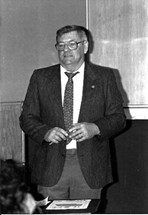 Robert D. Lammers was born on August 9, 1932 in Hooper, NE. He served in the United States Air Force from May 1950 until his discharge in September 1953, having earned the rank of Staff Sergeant. During his time in the Air Force Lammers’ electronics career began as a Fire Control Systems Technician. Following his discharge, he studied engineering at the University of NE and in 1964 earned an electronics degree from R.E.I. (Radio Engineering Institute) in Omaha, NE, graduating at the top of his class.
Robert D. Lammers was born on August 9, 1932 in Hooper, NE. He served in the United States Air Force from May 1950 until his discharge in September 1953, having earned the rank of Staff Sergeant. During his time in the Air Force Lammers’ electronics career began as a Fire Control Systems Technician. Following his discharge, he studied engineering at the University of NE and in 1964 earned an electronics degree from R.E.I. (Radio Engineering Institute) in Omaha, NE, graduating at the top of his class.
On October 25, 1953 Bob was united in marriage to Patricia Allen a registered nurse from Blair, NE. Together they raised five children--three sons and two daughters.
Lammers joined the Department of Aeronautics, Navaids Division in April of 1966 as an Electronics Specialist. He and two other technicians maintained seven state owned VOR’s, thirteen NDB’s and one 75 mHz fan marker. Lammers was promoted to Assistant Chief in October 1969 and became Chief of Navaids in April 1971. Bob earned his pilots license in 1975.
At the time he became chief, there were seven VOR’s, sixteen NDB’s, two 75 mhz fan markers, a weather teletype system serving thirteen airports and ten weather reporting stations. During his first year, antenna coupling units were designed, fabricated, tested and installed on "H" transmitter equipment. The purpose of the units was to eliminate facility outages caused by ice on the antennas.
In 1974 a new state owned and operated VOR was commissioned 9.5 miles west of Thedford, NE. This facility served the Sandhills region, which was previously devoid of VHF coverage. This was constructed entirely by Navaids. During selection of the site, it was determined that it would require a "mountain top" installation due to the rugged terrain. In design phase this configuration was modified. The equipment was housed in a poured, underground, concrete building using a conventional VOR counterpoise system at ground level. This eliminated the problems normally encountered with the long feed lines between the transmitter and antenna in a normal VOR mountain top installation. The DME was added in 1977 and the facility continues to operate.
In the 1980’s Lammers saw the need for an airport lighting program, this program was approved by the Aeronautics commission on March 19, 1982. This program was developed to reduce the actual project expense required to install a low intensity lighting on municipal airports in NE. The program was basically a project of near exchange of services and material costs for a new or replacement system. NDA provided, at no cost to the sponsor the light fixtures, cable, lighted wind cone assembly, rotating beacon less the tower, the electric eye and installation. The sponsor, at no cost to NDA provided the trenching and backfilling, connectors, ducts, beacon tower, wind cone pole, obstructions lights and labor.
Navaids continued to remain responsible for the engineering, installation and maintenance of all state owned navigational aids. In 1984, responsibility of 68 rotating beacons was added. They designed, re-built and installed these beacons at a lower energy cost to the local airports. One metal halide lamp lasted as long as fifteen incandescent lamps. This reduced maintenance and parts cost as well as cutting electrical consumption by about 40%. The majority of those beacons are still in service today.
It was Lammers’ dream to have the State, FAA, National Weather Service and the local communities join together to provide timely aviation weather observations. This became a reality with the beginning of the Shared Weather Observation Program (SWOP) in January of 1980. After about a year of negotiations, SWOP became the only program of it’s type in the nation. Hourly and special weather observations were made and disseminated between 7:00 am and 7:00 pm at seventeen locations. All participating parties contributed 25% towards the cost, which was about 75 cents per observation.
During the late ‘80’s still another new method of gathering weather was being introduced to the country. Lammers focused in on this opportunity, working initially with Henry Wulf, Diane Hofer and others in the NDA’s Engineering Division to receive federal AIP funding to install eight Automated Weather Observing Systems better known as AWOS’s in Nebraska Once purchased these systems were installed by Navaids personnel. Nebraska remains today, one of the few states that installs and maintains their own AWOS systems. Bob did not stop with the initial installation but worked to see that those systems, being non-fed, had their observations disseminated into NADIN, the National Airspace Data Interchange Network. In 1992 the Department of Aeronautics received the "Most Innovative State Program Award" for their"Weather Program" from National Association of State Aviation Officials at their annual meeting.
An active and continuous surplus property program was pursued during Lammers’ years as Chief. Personnel carefully screened GSA and FAA surplus catalogs and ‘fiche, completing applications requesting the donation of electronic equipment, components and parts to maintain and improve the Navaids Division’s operations. In fiscal year 1975-1976 the items acquired through the program valued in excess of $37,250.00.
In the early ‘90’s a request for a better approach to the Fremont airport was received. In researching the options, no suitable location could be found for a VOR on the Fremont Airport or surrounding area. Lammers being familiar with the area understood the many obstacles involved and was instrumental in working with the Fremont city administrators in cost sharing the installation of a VOR at the Scribner State Airfield. The facility provides better approaches to the Fremont airport and is the only state owned airfield that has a VOR. This VOR was commissioned in September, 1995.
Lammers retired September 1, 1994. In his 28 years he was always looking for ways to strengthen the aeronautics division within the State of Nebraska. His vision for the future is confirmed from the areas we just spoke of. Bob, known for his harmonious relationships, on numerous occasions, walked into a meeting, when tension was evident and came out with a handshake, smiles and a verbal commitment. He acquired much knowledge about aviation and navigational aids, always sharing this information and knowledge with those around him, doing so in a very eager manner. He had a gift of teaching and presenting the knowledge he had gained which was evident in the many presentations he did at airports, weather events and conferences over the years.
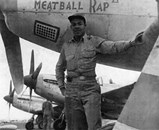 Lt. Colonel Charles A. Lane was born in 1925 in St. Louis, Missouri. Lane entered the Cadet Corps at Tuskegee Institute in Alabama in 1943. After graduating from flying class 44-H, he joined the Army Air Corps, flying with the 99th Pursuit Fighter Squadron, 332nd Fighter Group, on twenty-six combat missions in Italy during World War II. This African-American unit, known as the “Red Tail” group because of their distinctive aircraft paint scheme, established the unprecedented record of flying more than 1,500 missions in Europe and North Africa, losing only ninety-eight pilots.
Lt. Colonel Charles A. Lane was born in 1925 in St. Louis, Missouri. Lane entered the Cadet Corps at Tuskegee Institute in Alabama in 1943. After graduating from flying class 44-H, he joined the Army Air Corps, flying with the 99th Pursuit Fighter Squadron, 332nd Fighter Group, on twenty-six combat missions in Italy during World War II. This African-American unit, known as the “Red Tail” group because of their distinctive aircraft paint scheme, established the unprecedented record of flying more than 1,500 missions in Europe and North Africa, losing only ninety-eight pilots.
Lane later served as a Communications/Electronics officer and worked for twelve years in Air Force Special Security, serving in Vietnam from 1964–1968 and Guam from 1968–1970. He flew his final mission in the B-52 Stratofortress, retired in 1970, and moved to Omaha, Nebraska, where he managed the Greater Omaha Community Action Program until 1992. Lane currently represents Omaha’s Alfonza Davis Chapter on the Tuskegee Airmen, Inc. National Board of Directors.
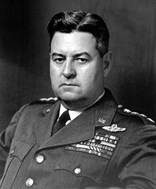 Curtis E. LeMay commanded the Strategic Air Command (SAC) at Offutt Air Force Base after its post-war relocation to Nebraska. An Ohio native, LeMay entered the Army Air Corps in 1930 and gained valuable flying experience for the world war to follow. LeMay’s innovative and effective bombing strategies helped him become the army’s youngest Major General in 1944. After World War II General LeMay commanded American air forces in Europe and organized the Berlin Airlift, a Cold War success. In 1948 he became commander of the newly reorganized SAC. LeMay spent nine years overseeing SAC’s remarkable growth from his Nebraska command center. At his departure this ever-alert force consisted of thirty-nine bomber wings and 224,000 personnel stationed at sixty-eight bases around the globe.
Curtis E. LeMay commanded the Strategic Air Command (SAC) at Offutt Air Force Base after its post-war relocation to Nebraska. An Ohio native, LeMay entered the Army Air Corps in 1930 and gained valuable flying experience for the world war to follow. LeMay’s innovative and effective bombing strategies helped him become the army’s youngest Major General in 1944. After World War II General LeMay commanded American air forces in Europe and organized the Berlin Airlift, a Cold War success. In 1948 he became commander of the newly reorganized SAC. LeMay spent nine years overseeing SAC’s remarkable growth from his Nebraska command center. At his departure this ever-alert force consisted of thirty-nine bomber wings and 224,000 personnel stationed at sixty-eight bases around the globe.
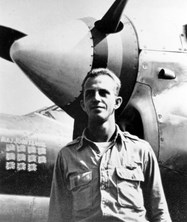 John S. Loisel became the state’s leading air ace in World War II. Born in Idaho and raised in Norfolk, Nebraska, Loisel attended the University of Nebraska and joined the United States Army’s Flying Cadet program, completing training in October 1941. During the war in the Pacific Theater he flew 300 combat missions over the course of three consecutive years, longer than any U.S. pilot. Flying a P-38 Lightning in the 475th Fighter Group, Loisel downed eleven Japanese airplanes. Before war’s end he reached the rank of lieutenant colonel in command of the group.
John S. Loisel became the state’s leading air ace in World War II. Born in Idaho and raised in Norfolk, Nebraska, Loisel attended the University of Nebraska and joined the United States Army’s Flying Cadet program, completing training in October 1941. During the war in the Pacific Theater he flew 300 combat missions over the course of three consecutive years, longer than any U.S. pilot. Flying a P-38 Lightning in the 475th Fighter Group, Loisel downed eleven Japanese airplanes. Before war’s end he reached the rank of lieutenant colonel in command of the group.
Loisel remained in the military and in 1950 returned to combat in the P-80 Shooting Star jet fighter in Korea. He retired from the Air Force in 1970 with more than 5,500 flying hours.
 William (Bill) Lyon left his hometown of Shelbyville, Illinois shortly after graduating from high school and landed in Lincoln, courtesy of the US Air Force. His vision of becoming an Air Force pilot changed direction when he earned his Private Pilot certificate through the Lincoln Aviation Institute. He was now destined for a long and distinguished career of service to Nebraska’s aviation community. Lyon progressed rapidly, earning his Multi-engine, Instrument, Helicopter and Instructor ratings, as well as his Aircraft and Power plant license. When Lyon joined the Department of Aeronautics in 1969 he was already a polished professional, having accumulated over 4,000 hours of instructor time. Going from his role as an instructor to that of Department Pilot was a natural transition for Bill as he widened his leadership role in general aviation. Over the next 40 years Bill Lyon’s quiet professionalism impacted nearly every facet of aviation in Nebraska. Starting as Aviation Services Representative and PIREPS editor, Lyon’s influence continued to expand to include pilot seminars, state aviation charts, airfield inspections, airport directories and special projects, such as aerial photography and airborne infrared sensors. His legacy includes his role as a founding member of the annual Aircraft Maintenance Symposium. But, flying has always been his true passion. Rated as an Airline Transport Pilot with over 16,000 hours, Bill has flown untold numbers of distinguished executives. They include Governors Tieman, Exon, Thone, Kerry, Orr, Nelson, Johanns, and Heineman. His accomplishments have been recognized on the national scene by the National Association of State Aviation Officials, the National Business Aircraft Association, Aircraft Owners and Pilots Association.
William (Bill) Lyon left his hometown of Shelbyville, Illinois shortly after graduating from high school and landed in Lincoln, courtesy of the US Air Force. His vision of becoming an Air Force pilot changed direction when he earned his Private Pilot certificate through the Lincoln Aviation Institute. He was now destined for a long and distinguished career of service to Nebraska’s aviation community. Lyon progressed rapidly, earning his Multi-engine, Instrument, Helicopter and Instructor ratings, as well as his Aircraft and Power plant license. When Lyon joined the Department of Aeronautics in 1969 he was already a polished professional, having accumulated over 4,000 hours of instructor time. Going from his role as an instructor to that of Department Pilot was a natural transition for Bill as he widened his leadership role in general aviation. Over the next 40 years Bill Lyon’s quiet professionalism impacted nearly every facet of aviation in Nebraska. Starting as Aviation Services Representative and PIREPS editor, Lyon’s influence continued to expand to include pilot seminars, state aviation charts, airfield inspections, airport directories and special projects, such as aerial photography and airborne infrared sensors. His legacy includes his role as a founding member of the annual Aircraft Maintenance Symposium. But, flying has always been his true passion. Rated as an Airline Transport Pilot with over 16,000 hours, Bill has flown untold numbers of distinguished executives. They include Governors Tieman, Exon, Thone, Kerry, Orr, Nelson, Johanns, and Heineman. His accomplishments have been recognized on the national scene by the National Association of State Aviation Officials, the National Business Aircraft Association, Aircraft Owners and Pilots Association.
Lyon retired from the Nebraska Department of Aeronautics in 2011. Bill Lyon has influenced virtually every sector of aviation in Nebraska—from airports and commercial enterprises to executive transportation and flying safety. Bill is a true icon in Nebraska’s general aviation community.
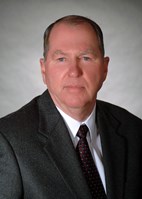 Stuart E. MacTaggart, Col. USAF (Ret.) served 27 years as a U. S. Air Force Pilot. Following his retirement, he spent many years promoting aviation in Nebraska.
Stuart E. MacTaggart, Col. USAF (Ret.) served 27 years as a U. S. Air Force Pilot. Following his retirement, he spent many years promoting aviation in Nebraska.
Stu earned a Bachelor’s of Science Degree from the University of Wisconsin, and a Master’s Degree from Embry Riddle Aeronautical University. His military career included serving as Commander of the 328th Bombardment Squadron followed by HQ SAC as Chief of Future Aircraft Concepts; then as head of Air Crew Training for the Command (B52, KC10, FB111, KC135, B1, U2). He served numerus tours in Southeast Asia during Vietnam, flying over 150 combat missions in B52’s and C130 Aircraft. He was awarded the Legion of Merit for exemplary leadership, integrity, and unwavering dedication while serving in the Office of the Inspector General, at Headquarters Strategic Air Command, Offutt air Force Base. Stu was awarded the Distinguished Flying Cross, three Meritorious Service medals, six Air Medals, the Air Force Commendation Medal, and many others.
Following retirement from the Air Force in 1992, Stu worked as a corporate pilot then as a flight instructor for a major airline. He joined the Nebraska Department of Aeronautics in 1998 and piloted State aircraft flying the Governor, State, and University Officials. He led youth-oriented aviation programs including the Aviation Art Contest and several week-long aviation summer camps. In 2008 he received the Frank E. Sorenson Aviation Education Achievement Award.
Stu was appointed Director of the Nebraska Department of Aeronautics in 2004 until his retirement in 2009. His outstanding leadership was well-respected by the aviation industry. As Director he worked with FAA and local communities in the administration of the various state and federal programs. Stu improved every aspect of the Nebraska Department of Aeronautics and our States aviation community certainly benefited.
Stu spent almost 50 years as a professional aviator.
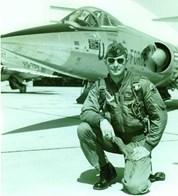 George J. Marrett was born in Grand Island, Nebraska in 1935 and graduated from Iowa State College in 1957 with a BS in chemistry. Shortly thereafter, he entered the United States Air Force as a Second Lieutenant in the Reserve Officers Training Corps. He graduated from pilot training in 1959 at Webb, AFB in Texas, where he flew the Lockheed T-33 Shooting Star. He went to advance flight training at Moody AFB in Georgia where he flew the North American F-86L, SabreJet. After four years in the 84th Fighter Interceptor Squadron at Hamilton AFB, California, flying the McDonnell F-101B Voodoo, he was selected to attend the USAF test pilot school in 1964. Here he flew the Northrop T-38 Talon, Lockheed F-104 Starfighter and General Dynamics F-106 Delta Dart. After graduation, he transferred to the fighter test branch at Edwards AFB, where he flew the McDonnell F-4C Phantom, Northrop F-5A Freedom Fighter and General Dynamics F-111A Aardvark.
George J. Marrett was born in Grand Island, Nebraska in 1935 and graduated from Iowa State College in 1957 with a BS in chemistry. Shortly thereafter, he entered the United States Air Force as a Second Lieutenant in the Reserve Officers Training Corps. He graduated from pilot training in 1959 at Webb, AFB in Texas, where he flew the Lockheed T-33 Shooting Star. He went to advance flight training at Moody AFB in Georgia where he flew the North American F-86L, SabreJet. After four years in the 84th Fighter Interceptor Squadron at Hamilton AFB, California, flying the McDonnell F-101B Voodoo, he was selected to attend the USAF test pilot school in 1964. Here he flew the Northrop T-38 Talon, Lockheed F-104 Starfighter and General Dynamics F-106 Delta Dart. After graduation, he transferred to the fighter test branch at Edwards AFB, where he flew the McDonnell F-4C Phantom, Northrop F-5A Freedom Fighter and General Dynamics F-111A Aardvark.
During the Vietnam conflict, Marrett flew the Douglas A-1 Skyraider as a"Sandy" rescue pilot in Thailand. He completed 188 combat with missions, over 600 combat hours and was awarded the Distinguished Flying Cross with two Oak Leaf Clusters and the Air Medal with eight Oak Leaf Clusters. Later, he published a non-fiction book about flying combat in Southeast Asia, titled Cheating Death: Combat Air Rescues in Vietnam and Laos.
Upon returning from the war, Marrett joined Hughes Aircraft Company as an experimental test pilot. For twenty years he flew test programs which helped develop attack radar and missiles in F-15, F-16 and F-18, aircraft and an early version of the B-2 Stealth bomber. He has flown over 40 types of military aircraft and logged over 8,500 hours.
Marrett is the author of three Air Force flight test reports and fourteen stories for aviation magazines, including Wings, Tailhook, Flight Journal, Air & Space and Aerospace Testing International, a British magazine.
His second book, Howard Hughes: Aviator, was published in October 2004. Marrett appeared on the History Channel programs, “Boy’s Toys and Modern Miracles” about Howard Hughes. He was also in “Man, Moment & Machines” talking about the Spruce Goose. Marrett was in both versions of the “Making of the Aviator”, that aired on several channels. He was a talking head on the DVD of the movie, “The Aviator”.
His third book, about his twenty years with Hughes Aircraft Company is called Howard Hughes’ Test Pilot. Marrett retired from Hughes in 1989 and lives in a small town, Atascadero, Ca. He is founder of the Estrella Warbird Museum at the Paso Robles airport where he flies his 1945 Stinson L-5E Sentinel and 1946 Aeronca L-16 Champ. He is the chief pilot for DP Industries flying their King Air C-90 and is on the board of trustees of the National Test Pilot School in Mojave, CA.
 Edwin Warren Martens, a lifetime resident of Nebraska, began his career during World War II as a B-17 pilot with the 92nd Bomb Group in England. He completed thirty missions over Europe and received the Distinguished Flying Cross. He served as a B-17 instructor until the end of the war.
Edwin Warren Martens, a lifetime resident of Nebraska, began his career during World War II as a B-17 pilot with the 92nd Bomb Group in England. He completed thirty missions over Europe and received the Distinguished Flying Cross. He served as a B-17 instructor until the end of the war.
Martens became a civilian instructor after the war and opened Martens Air Service in Grant, Nebraska. He restored and rebuilt old airplanes, and built new ones. He helped found the Experimental Aircraft Association Chapter 562, serving several years as president and vice-president. As a regular at local fly-ins, he won several awards for his work on a Waco UPF-7 that he rebuilt from a wreck.
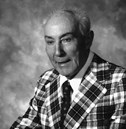 Thomas William “Tommy” Martin, Jr. was born in 1899 in Sioux City, Iowa. In 1949, Martin began operating Sioux Air, Inc. at the Sioux City, Iowa Municipal Airport, offering crop dusting and other services. He was an early member of the Civil Air Patrol. In the winter of 1948–49, he flew doctors to isolated areas and delivered supplies to farm families. In 1958, Martin opened Martin Field in South Sioux City, Nebraska. He continued aerial application, flew charter flights, and provided flight instruction and aircraft mechanical services. At the age of seventy-nine, Martin became a licensed glider pilot and instructor. In 1979, Martin was named Flight Instructor of the Year and received membership in the Silver Wings. He was awarded the Legion of Merit from 0X5 Aviation Pioneers. He was eighty years old when he flew his last flight, checking out his grandson for his glider pilot’s license. He logged more than 30,000 hours in fifty years of flying before he passed away in 1983.
Thomas William “Tommy” Martin, Jr. was born in 1899 in Sioux City, Iowa. In 1949, Martin began operating Sioux Air, Inc. at the Sioux City, Iowa Municipal Airport, offering crop dusting and other services. He was an early member of the Civil Air Patrol. In the winter of 1948–49, he flew doctors to isolated areas and delivered supplies to farm families. In 1958, Martin opened Martin Field in South Sioux City, Nebraska. He continued aerial application, flew charter flights, and provided flight instruction and aircraft mechanical services. At the age of seventy-nine, Martin became a licensed glider pilot and instructor. In 1979, Martin was named Flight Instructor of the Year and received membership in the Silver Wings. He was awarded the Legion of Merit from 0X5 Aviation Pioneers. He was eighty years old when he flew his last flight, checking out his grandson for his glider pilot’s license. He logged more than 30,000 hours in fifty years of flying before he passed away in 1983.
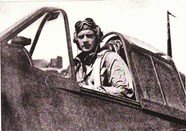 Donald M. McPherson was born on May 22, 1922, and raised in Adams, Nebraska. When the Navy V-5 program waived the two-year college requirement, McPherson enlisted on January 5, 1943, and was thereafter appointed as an Aviation Cadet on February 4th. He earned his commission and wings at Corpus Christi, Texas, on August 12, 1944. Upon arriving at Daytona Beach, Florida, for advanced training, Don was assigned to fly the F6F Hellcat. He completed carrier qualifications at Glenview, Illinois, before shipping off to Pearl Harbor, Hawaii, to await a combat assignment. There he earned the Pacific Defense Ribbon flying combat air patrols over the area. Don was then assigned to the USS Essex as a pilot with VF-83, Wonder 5 Flight.
Donald M. McPherson was born on May 22, 1922, and raised in Adams, Nebraska. When the Navy V-5 program waived the two-year college requirement, McPherson enlisted on January 5, 1943, and was thereafter appointed as an Aviation Cadet on February 4th. He earned his commission and wings at Corpus Christi, Texas, on August 12, 1944. Upon arriving at Daytona Beach, Florida, for advanced training, Don was assigned to fly the F6F Hellcat. He completed carrier qualifications at Glenview, Illinois, before shipping off to Pearl Harbor, Hawaii, to await a combat assignment. There he earned the Pacific Defense Ribbon flying combat air patrols over the area. Don was then assigned to the USS Essex as a pilot with VF-83, Wonder 5 Flight.
McPherson participated in cleanup operations near Iwo Jima and the Philippines before being assigned to strafing runs prior to the invasion of Okinawa. Don and his squadron were assigned to attack kamikaze aircraft before they could attack U.S. ships ear the island of Kikajima. He spotted two Japanese Val dive bombers on a converging course near the water and dived on them. The first Val’s pilot was hit and the aircraft crashed into the sea. Under heavy fire from the island, Don pounced on the second Val as it attempted to escape. A quick burst exploded the Val.
Over the next few months McPherson took part in raids on several Japanese islands, including the invasion of Okinawa, where they would try to bomb into the fortified caves in the hills. During a battle north of Okinawa on May 4, 1945, McPherson shot down three more Kamikaze aircraft earning his “ace” status. Three of McPherson’s Wonder 5 Flight also made “ace” that day.
On September 2, 1945, Wonder 5 Flight flew their final mission of WWII, a combat air patrol in the skies above the USS Missouri while General Douglas MacArthur accepted the complete and unconditional surrender of the Empire of Japan.
During his WWII service, Ensign Don McPherson earned the following decorations, citations, and awards: Naval Combat Aviator Wings; Distinguished Flying Cross w/2 stars; Navy Air Medal w/3 stars; Asia/Pacific Campaign Medal; WWII Occupation Medal; National Defense Service Medal; Navy Commendation Medal; Combat Service Commendation Medal.
Don McPherson left the service at the end of the war and returned home to Adams, Nebraska, where he was employed as a rural mail carrier and farmed as well. Don continues to make his home in Adams.
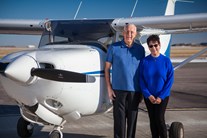 Clyde and Joan E. Mickelsen have played quiet, profound roles in supporting and mentoring aviation professionals as the owners and operators of Air Midway in Kearney. Born and raised a half mile from the Kearney airport, Clyde’s aviation interest began at age four when the grand opening of the original Kearney Municipal Airport was held. Months later, with WW II underway, the airport transformed into a large training base. Clyde watched as the B-17’s and other military aircraft flew their traffic patterns overhead.
Clyde and Joan E. Mickelsen have played quiet, profound roles in supporting and mentoring aviation professionals as the owners and operators of Air Midway in Kearney. Born and raised a half mile from the Kearney airport, Clyde’s aviation interest began at age four when the grand opening of the original Kearney Municipal Airport was held. Months later, with WW II underway, the airport transformed into a large training base. Clyde watched as the B-17’s and other military aircraft flew their traffic patterns overhead.
Clyde enlisted in the Air Force in 1957. Stationed in Texas, he took a ride in a J-3 Cub with an acquaintance. He signed up for flight lessons the same day. Following an honorable discharge, and with a pilot certificate in hand, he went to work at Buffalo Air Service in Kearney. While working the line and helping with business operations, Clyde started commuting to Lincoln to work on advanced ratings which included that of flight Instructor.
For some 15 plus years, Clyde was employed by various operators on the Kearney airport, instructing and flying charters. In 1985, Clyde and Joan E. purchased Andy’s Air Service and Midway Aviation. They combined the two entities forming Air Midway. Thus began a twenty-year informal agreement to provide aircraft and flight instructors to train students in the University of NE-Kearney Aviation Program. As the program grew, it became necessary to have more oversight in flight-training at the airport. Because of limited funds identified in the University of NE-Kearney budget, Clyde and Joan E. stepped up with an offer to split the salary cost with the university. This was one of the first private/public partnerships at UN-K and was instrumental in fostering the growth of the Aviation Systems Management Program.
The support the Mickelsen’s committed to this program and its students was more than a business decision. First and foremost, they were mentors, role models, and confidants to the students. The business relationship was secondary to the development of the individual. They provided employment and career opportunities to hundreds of college and high school students. It was an environment where hard work was expected, but it was rewarded. There were times when students did not have money to finish a rating. The Mickelsen’s trusted the students to do what was right. It was a mutual respect they held for each other.
They assisted medical flights at all hours of the day or night. They hosted political gatherings, Flying Farmers & Ranchers Conventions, general and corporate pilots, and several celebrities. Clyde also served as a certified weather observer.
Clyde and Joan E. retired in October, 2008, leaving a legacy to the aviation industry in Nebraska and to places beyond.
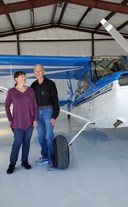 Edwin L. Nelson (Ed) was born July 21, 1944, in Potter, Nebraska. Ed grew up on an active farm/ranch/airport outside of Potter, Nebraska operated by his father Leonard. Ed grew up with a passion for flying and at a young age, knew his life would be focused on flying. Ed holds the following FAA certificates: Commercial, Single and Multi-Engine Land, Instrument, Flight Instructor Airplane Single and Multi-Engine, Instrument Airplane.
Edwin L. Nelson (Ed) was born July 21, 1944, in Potter, Nebraska. Ed grew up on an active farm/ranch/airport outside of Potter, Nebraska operated by his father Leonard. Ed grew up with a passion for flying and at a young age, knew his life would be focused on flying. Ed holds the following FAA certificates: Commercial, Single and Multi-Engine Land, Instrument, Flight Instructor Airplane Single and Multi-Engine, Instrument Airplane.
Ed is a veteran of the United States Airforce Strategic Air Command, Beale Airforce Base, having served 4 years as an Aircraft Maintenance Officer achieving the rank of Captain. Ed is a 1967 graduate of the University of Wyoming in Laramie. While in college, he completed the advanced ROTC courses and attended Officers Training School at Lincoln Air Force Base.
In his 58 plus years flying, Ed has accumulated over 26,500 hours of flight time in over 145 makes and models of aircraft and 12,600 hours of flight time in tailwheel aircraft. He has conducted over 6100 hours of flight instruction and instructed hundreds of aspiring pilots following their passion for flight. He enjoys teaching and continues to do so with precision and excellence. Ed has flown as an aerial applicator, night freight hauler, aerobatic competitor, flight instructor and slurry bomber co-pilot. Was a chief flight instructor and general manager at an Aerobatics flight school and Airport Manager at the Sidney, NE Airport.
Ed is a member of Aircraft Owners and Pilots Association, Experimental Aircraft Association, International Aerobatic Club, Vintage Aircraft Association, International Cessna 120/140 Association, Fairchild Club, Nebraska Antique Airplane Association and Quiet Birdman. Past member of the Nebraska Aviation Trades Association, Secretary/Treasurer, Vice President. Ed operated Sidney Aviation for over 35 years.
Ed's outstanding contributions to aviation is his dedication to instilling the passion of aviation in anyone who had a small spark. His natural charisma, engaging sense of humor, keen attention to detail and knowledge of flight safety is unparalleled. Ed's contributions have enabled countless numbers to realize their childhood dreams and secure their dream career.
 Leonard E. Nelson, born in Kimball, Nebraska, was instrumental in the development of the Kimball Municipal Airport and operated the first Fixed Base Operation at that location. He also developed the Bar J Lazy V Airport, one of Nebraska’s few commercially licensed, privately owned and operated, turf airports.
Leonard E. Nelson, born in Kimball, Nebraska, was instrumental in the development of the Kimball Municipal Airport and operated the first Fixed Base Operation at that location. He also developed the Bar J Lazy V Airport, one of Nebraska’s few commercially licensed, privately owned and operated, turf airports.
Nelson was a founding member of the Panhandle Clouddusters and an early member and strong supporter of the Nebraska Aviation Trades Association, demonstrating his dedication to effective crop pest control with minimal environmental impact. During his more than 8,000 hours of flying, he flew everything from civil humanitarian aid missions, to Air Transport Command shuttles during World War II, to air taxi flights, to participating in commemorative airmail flights. He also instructed dozens of civilian and Army Air Corps student pilots.
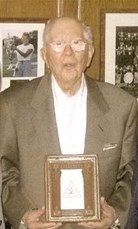 William Nyrop was born on April 1, 1912 on a farm in West Cedar Creek, NE. He grew up in Elgin and graduated from Elgin High School in May of 1930. He graduated from Doane College in Crete, NE in 1934 with a degree in history. He then completed a law degree from George Washington University Law School.
William Nyrop was born on April 1, 1912 on a farm in West Cedar Creek, NE. He grew up in Elgin and graduated from Elgin High School in May of 1930. He graduated from Doane College in Crete, NE in 1934 with a degree in history. He then completed a law degree from George Washington University Law School.
Nyrop joined the Civil Aeronautics Administration (CAA) in the spring of 1939 as a staff attorney. He was involved in the legal agreements when new routes were established for airlines. A few months later, he was transferred to the section that dealt with legal issues concerning aircraft accident investigation. This is where Nyrop developed his interest in aviation safety that would stay with him for the rest of his career. In 1940, President Roosevelt created the Civil Aeronautics Board (CAB). The CAB was given power to control airlines routes, airfares and subsidies. It was also responsible for safety rule making and airline accident investigation. Nyrop was asked to be the Executive Assistant. A position he accepted but had to resign later that year, when he joined the Army Air Force.
After the war, Nyrop worked with the Air Transport Association, which was responsible for establishing peacetime overseas routes for US airlines. He also served as a delegate to the International Civil Aviation Organization Assemblies, an international advisory body endorsed by 26 countries.
In October of 1950, Nyrop became Administrator of the CAA. This federal agency employed more than 18,000 people and had an annual budget of over $187 million. As administrator, he had a hand in everything that went on in the CAA. He constantly questioned his staff to know what was going on in each department so that he could make the most educated decisions. Nyrop made it mandatory for aircraft flying within designated air defense identification zones to file flight plans with the CAA. He also made it mandatory for all licensed pilots to obtain identification cards through the CAA. President Truman asked Nyrop to be chairman of the CAB in 1951.
Northwest Airlines was in trouble in the early 50’s and Nyrop was aware of it. They had safety problems and averaged a plane crash every 45 days. They usually didn’t have enough cash on hand to meet the payroll for more than 40 days. Members of Northwest’s Board offered Nyrop the presidency but he declined in order to join a private law practice., Later he reconsidered when asked again.
Nyrop’s first move as head of Northwest Airlines was to restore their financial credibility. He began paying off debts and nine months later the company didn’t owe anything. He standardized the existing fleet of airplanes ultimately ending up with just three types of aircraft.
Frequent strikes cast shadows on his record. From 1961 to 1978, there were 378 days of employee strikes. Union members were driven to strike by dislike for the same qualities that had made Northwest successful. While Nyrop and the unions fought bitter battles, many individual pilots had great respect for their boss.
Nyrop served as Northwest’s president and CEO from 1954-1976 and as chairman and CEO from 1976-1978. Nyrop had reached retirement age in 1977 but the board of directors asked him to stay on to deal with some labor problems that were going on at the time. But by 1978 Nyrop had lost control over the directors and the ducks stopped lining up at his command. Nyrop announced his retirement at the end of the company’s fiscal year. He had served 24 years and had the longest tenure in airline history. He served on the board of directors until 1984, making his total service thirty years.
During those thirty years, Nyrop transformed the struggling Northwest from a $27 million company to one worth $800 million, an industry leader in safety and one of the most financially sound airlines. Northwest turned a profit for 24 straight years with Nyrop in charge and ranked first in operating efficiency with its low break even load.
 Ray Page, aviation executive, put Lincoln, Nebraska, on the international map as a center of manufacturing, education, and promotion in the 1920s. Born in Friend, Nebraska, Page and his wife Ethel formed the Lincoln Standard Aircraft Company, which initially reconditioned surplus World War I airplanes for civilian use. The company soon began production and marketing of its own airplanes and the construction of one of Lincoln’s first commercial airfields.
Ray Page, aviation executive, put Lincoln, Nebraska, on the international map as a center of manufacturing, education, and promotion in the 1920s. Born in Friend, Nebraska, Page and his wife Ethel formed the Lincoln Standard Aircraft Company, which initially reconditioned surplus World War I airplanes for civilian use. The company soon began production and marketing of its own airplanes and the construction of one of Lincoln’s first commercial airfields.
Page’s company built one airplane a day—as well as parts and accessories—for customers around the world. Models included the Lincoln Standard and Lincoln Page and the single-seat Lincoln Sport. Page opened the Lincoln Aircraft School in 1922. Its most famous graduate was pilot Charles Lindbergh.
 Roger W. Peden was born June 17, 1933 on a farm south of Cozad, Nebraska. He began his aviation career at the age of 14 when he worked at the Gothenburg Airport. Instead of wages, he worked for flight time and soloed at 16.
Roger W. Peden was born June 17, 1933 on a farm south of Cozad, Nebraska. He began his aviation career at the age of 14 when he worked at the Gothenburg Airport. Instead of wages, he worked for flight time and soloed at 16.
Peden worked in Ainsworth as the first superintendent of Merritt Dam and used his airplane in this work. He began spraying part-time in a CallAir. In 1968, Peden was offered the job of Airport Manager and FBO at the Gothenburg Airport and so began the family business of Gothenburg Aviation. They offered flight training, an approved VA school, air ambulance, charter service, aerobatic training and aerial spraying.
During the Seventies, Gothenburg had the second largest flying school in Nebraska. They averaged 65 certifications a year. Roger taught advanced ratings to students from Nebraska, Kansas, Colorado, California and even Canada. In his first year of instructing, Roger had 47 students.
Gothenburg Aviation played an active role in the Nebraska State Essay contests and gave hundreds of free rides to children.
The Peden’s were very active in the Flying Farmers and hosted many fly-ins. They were selected as Flying Farmer and Rancher Airport Operator of the year in 1971 and again in 1991. They also received an award for contributing to A .P. T. program. Peden provided free check rides for the Flying Farmers. For ten years the NAAA fly-in was held annually at Gothenburg.
Peden’s greatest contribution to aviation was the number of people he encouraged and taught to fly. Sadly, he passed away on April 21, 1997.
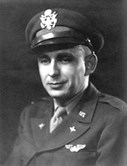 Charles O. Petersen was born in Queens, NY in 1916. Orphaned in 1929, he moved to Marquette, NE to live with his aunt. In 1939, he received his first plane ride with Evelyn Sharp at the Grand Island airport. He was immediately hooked on flying but could not afford lessons. When WWII broke out, he tried to enlist in the Navy’s air program but was rejected since he was married and had a daughter. He then joined the Army Air Corps, where he flew Stearmans, BT-13s, UC-78s and finally B-24s. Petersen was assigned to photo recon school and ended up in the 24th Combat Mapping Squadron, India, flying a modified B-24. He also served during the Korean War. In the early 1950’s, Petersen operated an FBO at the Grand Island airport, giving flight instruction and flying charter. In 1957, he began aerial spraying following a grasshopper infestation at Loop City. In 1966, Petersen moved to Minden, where the business grew to include seven Grumman Ag-Cats, making it the largest Ag-Cat operation in the country at that time. He gave flight instruction through the 1960s and 1970s and served on Minden’s Airport Board from 1980 to 1992. In 1982 Petersen Flying Service began discussions with the F AA concerning the use of automotive gasoline in the Pratt and Whitney R -985. Following the first auto fuel STC (Supplemental Type Certificates) obtained by the EAA for the Cessna 150, the FAA agreed to a test program proposed by Petersen for Ag-Cats and their radial engines. Petersen obtained his first two STCs on March 23, 1983 through his company, Petersen Aviation. Petersen Aviation then embarked on a test program which ultimately resulted in the issuance of auto fuel STC’s for 36 different engine types and over 100 different airframes. By 1989, over 20,000 auto fuel STCs had been sold to owners and operators all over the world. Petersen Flying Service was eventually sold to Buffalo Air Service of Kearney. Charles O. Petersen died in March of 1994.
Charles O. Petersen was born in Queens, NY in 1916. Orphaned in 1929, he moved to Marquette, NE to live with his aunt. In 1939, he received his first plane ride with Evelyn Sharp at the Grand Island airport. He was immediately hooked on flying but could not afford lessons. When WWII broke out, he tried to enlist in the Navy’s air program but was rejected since he was married and had a daughter. He then joined the Army Air Corps, where he flew Stearmans, BT-13s, UC-78s and finally B-24s. Petersen was assigned to photo recon school and ended up in the 24th Combat Mapping Squadron, India, flying a modified B-24. He also served during the Korean War. In the early 1950’s, Petersen operated an FBO at the Grand Island airport, giving flight instruction and flying charter. In 1957, he began aerial spraying following a grasshopper infestation at Loop City. In 1966, Petersen moved to Minden, where the business grew to include seven Grumman Ag-Cats, making it the largest Ag-Cat operation in the country at that time. He gave flight instruction through the 1960s and 1970s and served on Minden’s Airport Board from 1980 to 1992. In 1982 Petersen Flying Service began discussions with the F AA concerning the use of automotive gasoline in the Pratt and Whitney R -985. Following the first auto fuel STC (Supplemental Type Certificates) obtained by the EAA for the Cessna 150, the FAA agreed to a test program proposed by Petersen for Ag-Cats and their radial engines. Petersen obtained his first two STCs on March 23, 1983 through his company, Petersen Aviation. Petersen Aviation then embarked on a test program which ultimately resulted in the issuance of auto fuel STC’s for 36 different engine types and over 100 different airframes. By 1989, over 20,000 auto fuel STCs had been sold to owners and operators all over the world. Petersen Flying Service was eventually sold to Buffalo Air Service of Kearney. Charles O. Petersen died in March of 1994.
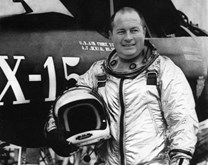 Vice Admiral Forrest Silas Petersen was born in Holdrege, May 16, 1922 and grew up in Gibbon. He attended the University of Nebraska—Lincoln for two years prior to entering the U. S. Naval Academy in 1941. During World War II Admiral Petersen saw action in the Mariana and Western Caroline Islands, Leyte Gulf, Okinawa, and Japan. He became a Naval Aviator in 1947. Admiral Petersen participated in test flights of the X-15, receiving the NASA Distinguished Service Medal, the Distinguished Flying Cross, and the National Society of Aerospace Professional’s Montgomery Award. He was joint recipient of the Collier Trophy and was also awarded numerous military decorations. Admiral Petersen was appointed Vice Admiral, U.S. Navy, in 1976 and assumed command of the Naval Air Systems Command. Admiral Petersen died in 1990 and was buried in Arlington National Cemetery, Arlington, VA. He was a member of the Society of Experimental Test Pilots and the American Institute of Aeronautics & Astronautics.
Vice Admiral Forrest Silas Petersen was born in Holdrege, May 16, 1922 and grew up in Gibbon. He attended the University of Nebraska—Lincoln for two years prior to entering the U. S. Naval Academy in 1941. During World War II Admiral Petersen saw action in the Mariana and Western Caroline Islands, Leyte Gulf, Okinawa, and Japan. He became a Naval Aviator in 1947. Admiral Petersen participated in test flights of the X-15, receiving the NASA Distinguished Service Medal, the Distinguished Flying Cross, and the National Society of Aerospace Professional’s Montgomery Award. He was joint recipient of the Collier Trophy and was also awarded numerous military decorations. Admiral Petersen was appointed Vice Admiral, U.S. Navy, in 1976 and assumed command of the Naval Air Systems Command. Admiral Petersen died in 1990 and was buried in Arlington National Cemetery, Arlington, VA. He was a member of the Society of Experimental Test Pilots and the American Institute of Aeronautics & Astronautics.
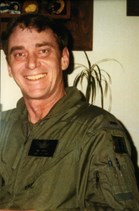 Wesley L. Peyton was born in Onawa, Iowa, on March 17, 1945. After graduating from high school, he attended the University of South Dakota, Vermilion. He then entered the U.S. Army Rotary Wing Flight School at Fort Wolters, Texas & completed Advanced Rotary Wing Training at Hunter Army Air Field, GA. Wes served a year-long tour of duty in Vietnam flying aero-medical evac helicopters. Wes returned to civilian life in Omaha, NE, joined the NE Army National Guard in Lincoln, NE, where he served as an Aero-Medical Evac Helicopter Pilot for the 24th Medical Air Evacuation Company. He was deployed in Operation Desert Shield/Desert Storm where Wes served with distinction. Awards received over the years include the National Defense Service Medal with Bronze Service Star, Army Lapel Button, Army Service Ribbon, Army Master Aviator Badge, Air Medal, Vietnam Service Medal, Vietnam Campaign Medal, Vietnam Cross of Gallantry with Palm, Good Conduct Medal, Army Reserve Components Achievement Medal with 2 Oak Leaf Clusters, Distinguished Flying Cross, Bronze Star Medal, Expert Marksmanship Qualification Badge , Southeast Asia Service Medal with 2 Bronze Service Stars, and a Meritorious Unit Commendation Ribbon.
Wesley L. Peyton was born in Onawa, Iowa, on March 17, 1945. After graduating from high school, he attended the University of South Dakota, Vermilion. He then entered the U.S. Army Rotary Wing Flight School at Fort Wolters, Texas & completed Advanced Rotary Wing Training at Hunter Army Air Field, GA. Wes served a year-long tour of duty in Vietnam flying aero-medical evac helicopters. Wes returned to civilian life in Omaha, NE, joined the NE Army National Guard in Lincoln, NE, where he served as an Aero-Medical Evac Helicopter Pilot for the 24th Medical Air Evacuation Company. He was deployed in Operation Desert Shield/Desert Storm where Wes served with distinction. Awards received over the years include the National Defense Service Medal with Bronze Service Star, Army Lapel Button, Army Service Ribbon, Army Master Aviator Badge, Air Medal, Vietnam Service Medal, Vietnam Campaign Medal, Vietnam Cross of Gallantry with Palm, Good Conduct Medal, Army Reserve Components Achievement Medal with 2 Oak Leaf Clusters, Distinguished Flying Cross, Bronze Star Medal, Expert Marksmanship Qualification Badge , Southeast Asia Service Medal with 2 Bronze Service Stars, and a Meritorious Unit Commendation Ribbon.
In 1981, Wes became one of the original pilots in the newly formed SkyMed Helicopter EMS Program developed at the Med Center in Omaha, NE. As Lead Pilot for the SkyMed program, Wes was instrumental in establishing helipads, protocols and relationships at the many hospitals served by the University of NE Med Center. Ranging as far west as Broken Bow and North Platte in Nebraska to many hospitals in Western IA, northeastern KS and southwest SD. Wes’ tireless efforts were directly responsible for the success of the SkyMed program that is, to this day, a significant player in the EMS Helicopter Operations in the Eastern NE and Western IA .
 Albert C. Potter has served for thirty years as Chair of the Aurora Airport Authority. His progressive leadership moved the Aurora Municipal Airport from a 1600-foot grass runway to a facility with a 4,300' x 75' lighted runway and the most modem equipment. The Aurora, Nebraska airport was named 1994 Nebraska Airport of the Year by the Nebraska Department of Aeronautics. Potter’s first airplane was a 58hp Taylor Cub. He bought it in parts and assembled it himself. He ran his own flying school, then served as a flight instructor in the U.S. Navy during World War II. He also flew for the U.S. Fish and Wildlife Service and the Department of the Interior in Alaska.
Albert C. Potter has served for thirty years as Chair of the Aurora Airport Authority. His progressive leadership moved the Aurora Municipal Airport from a 1600-foot grass runway to a facility with a 4,300' x 75' lighted runway and the most modem equipment. The Aurora, Nebraska airport was named 1994 Nebraska Airport of the Year by the Nebraska Department of Aeronautics. Potter’s first airplane was a 58hp Taylor Cub. He bought it in parts and assembled it himself. He ran his own flying school, then served as a flight instructor in the U.S. Navy during World War II. He also flew for the U.S. Fish and Wildlife Service and the Department of the Interior in Alaska.
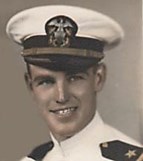 William A. (Bill) Quinn was born in Omaha NE on November 4, 1921. Bill graduated from Creighton Prep High School when he joined the U S Navy a few weeks after the Japanese attack on Pearl Harbor. After graduation he completed officer training at the University of Iowa and was commissioned as Ensign. After graduation from advanced flight training at NAS Corpus Christi, he was assigned as a co pilot of a Martin PBM Mariner flying boat, assigned to Patrol Squadron VPB-25. His crew was sent to Mindoro Island, Philippines.
William A. (Bill) Quinn was born in Omaha NE on November 4, 1921. Bill graduated from Creighton Prep High School when he joined the U S Navy a few weeks after the Japanese attack on Pearl Harbor. After graduation he completed officer training at the University of Iowa and was commissioned as Ensign. After graduation from advanced flight training at NAS Corpus Christi, he was assigned as a co pilot of a Martin PBM Mariner flying boat, assigned to Patrol Squadron VPB-25. His crew was sent to Mindoro Island, Philippines.
His crew completed 31 successful reconnaissance patrols monitoring Japanese naval activity. On the 32'nd patrol they lost an engine and ditched into the sea with 40 to 50 foot rolling swells. After 12 hours in the water the crew was rescued by a U.S. Navy Destroyer and returned to the Philippines. Two patrols later his crew again experienced an engine loss necessitating a landing at Tam Quam Point, French Indochina. One crew member was rescued by submarine while the rest of the crew moved inland to evade the Japanese and the native coastal people of Indochina who were rewarded with a bag of rice for each downed flyer brought to the Japanese. The crew was aided by the French resistance. After evading Japanese patrols for three months, eight members of the crew were captured at Ple Tonan Indo China after a brief firefight in which Bill Quinn was wounded. After harsh interrogation, six of his men were executed. Bill Quinn was the seventh prisoner in line when the executions stopped, sparing him and his radioman. The two remaining prisoners were eventually transported to Saigon where they remained POW's until they were freed on Sept. 5, 1945.
During the C-47 flight from Saigon to Calcutta, India, Bill was asked to relieve the plane's exhausted copilot so he could rest from the around the clock flying former POW's from various locations around South East Asia. As the only surviving witness to the executions at Ple Tonan, Bill provided testimony for the war crimes of six Japanese soldiers which resulted in six murder convictions.
After the war, Bill settled in Omaha and was involved as a sales rep. for Westinghouse Elevators. He then moved to Denver, CO with his wife Bette and raised their three children while operating a construction materials sales company.
 Horace W. Quinn, (front row, third from right) who lived through remarkable circumstances during World War II, served as a radio operator-gunner on a B-24 bomber in the Army Air Force. Quinn’s airplane made an emergency landing in neutral Spain on his first mission. He was captured by Germans but escaped to North Africa. Returning to the air, Quinn flew seventeen more missions, including raids on the Ploesti oil refineries. On February 22, 1944, Quinn’s plane was shot down over Germany. He endured fourteen months captivity and severe privations as a prisoner of war.
Horace W. Quinn, (front row, third from right) who lived through remarkable circumstances during World War II, served as a radio operator-gunner on a B-24 bomber in the Army Air Force. Quinn’s airplane made an emergency landing in neutral Spain on his first mission. He was captured by Germans but escaped to North Africa. Returning to the air, Quinn flew seventeen more missions, including raids on the Ploesti oil refineries. On February 22, 1944, Quinn’s plane was shot down over Germany. He endured fourteen months captivity and severe privations as a prisoner of war.
After the war Quinn started the municipal airport in his hometown of Lodgepole, Nebraska. He flew a number of rescue missions during the terrible Blizzard of ’49.
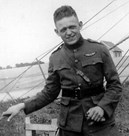 Orville A. Ralston, an Ainsworth, Nebraska dentist and aviation promoter, was Nebraska’s only World War I ACE, one of the “War Birds.” One of the first American Contingent with the Royal Flying Corps, Ralston was later named “C” Flight Commander with the Seventeenth Aero Squadron, U.S. Aero Service. From December 19,1917 to March 3,1919, he scored numerous victories flying Viper SE5-type aircraft, as well as “Sopwith Camels.” He was awarded the Distinguished Service Cross, our Nation’s highest award for courage and valor in combat, and two golden service chevrons.
Orville A. Ralston, an Ainsworth, Nebraska dentist and aviation promoter, was Nebraska’s only World War I ACE, one of the “War Birds.” One of the first American Contingent with the Royal Flying Corps, Ralston was later named “C” Flight Commander with the Seventeenth Aero Squadron, U.S. Aero Service. From December 19,1917 to March 3,1919, he scored numerous victories flying Viper SE5-type aircraft, as well as “Sopwith Camels.” He was awarded the Distinguished Service Cross, our Nation’s highest award for courage and valor in combat, and two golden service chevrons.
Ralston lived in Ainsworth from 1920-36, serving as City Councilman and Mayor, chairing the committee that established the first Ainsworth Municipal Airport. He served in the Air Services Reserve Corps, participated in “Air Circus” and brought Air Shows to the community. As World War II began, he volunteered for service and was appointed to the rank of Major in the U.S. Army Air Corps. He was killed in a plane crash in 1942, as a passenger on a B-17 training mission.
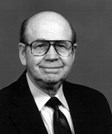 Billy G. Ray, a World War II Army Air Corps B-24 pilot, successfully flew forty-nine missions. He was shot down on his fiftieth mission in 1944 and remained a prisoner of war in Germany until his release in 1945, shortly before V.E. Day.
Billy G. Ray, a World War II Army Air Corps B-24 pilot, successfully flew forty-nine missions. He was shot down on his fiftieth mission in 1944 and remained a prisoner of war in Germany until his release in 1945, shortly before V.E. Day.
Ray helped organize the Chappell Development Committee to develop the local airport, recreation area, and golf course in Chapell, Nebraska. In 1985, the Chappell VFW Post 7002 honored him with the Degree of Honor in Service and Citizenship for service to country and community. Ray became a licensed pilot in 1942 and continued to fly his plane into his eighties.
 King Rhiley, Jr. has a long history of contributing to the advancement of aviation at Oshkosh, Nebraska.
King Rhiley, Jr. has a long history of contributing to the advancement of aviation at Oshkosh, Nebraska.
King had a true passion for aviation and his career spanned more than 60 years. Starting with his first solo flight in 1947 he earned a Commercial Pilot Certificate for single and multi-engine land aircraft. He earned a Flight Instructor Certificate, an Instrument Rating, and was rated for Rotorcraft and Rotorcraft Instructor. He logged approximately 30,000 hours of flying time.
However, he will be remembered most for his tireless dedication to advancing general aviation at the Garden County Airport in Oshkosh, Nebraska. Over his long career he taught many people to fly, operated an aerial applicator service, offered pilot services to aircraft owners and volunteered flights to hospitals for critically ill residents, a much-needed service in rural Nebraska.
As manager of Garden County Airport in the late 1950’s and 1960’s, he oversaw several major projects. These including grading and marking the runway, adding runway lights and building hangars. In 1969 he oversaw paving the runway and extending its length to 3,700 feet.
In 2019 the City of Oshkosh demonstrated its appreciation for his life-long commitment to aviation in their community by renaming the airport “Garden County Airport—King Rhiley Field”. An amazing honor that inspired the Rhiley family to nominate him for the Nebraska Aviation Hall of Fame.
 Todd was introduced to aviation at a young age when a neighbor gave him a ride in a Cessna 170. He did an aviation research project while he was in the 8th grade with Terri-Perkins Haynes of Chadron, NE. She would be his flight instructor two years later. On March 6th, 1985 Todd had his first lesson and took his private pilot check ride on August 2nd, 1988. Todd started his formal education at Chadron State College then transferred to Spartan School of Aeronautics in Tulsa, OK. He earned his Commercial Certificate and Instrument rating in both single and multi-engine aircraft while he was there. Todd then transferred to Metro State College in Denver, CO. where he earned his flight instructor rating at Centennial Airport. Next, he went back to Chadron working as a flight instructor and commercial pilot for L & D Aero. He also did aerial photography and was a Certified Weather observer while working there. He instructed numerous pilots there and introduced many to aviation and encouraged private pilots to continue earning ratings and learning more in advanced aircraft. Most pilots in and near Chadron have completed a flight reviews with Todd at least once. Todd conducted many EAA young eagle flights and just as he was earlier, instilled a love of aviation in many of them.
Todd was introduced to aviation at a young age when a neighbor gave him a ride in a Cessna 170. He did an aviation research project while he was in the 8th grade with Terri-Perkins Haynes of Chadron, NE. She would be his flight instructor two years later. On March 6th, 1985 Todd had his first lesson and took his private pilot check ride on August 2nd, 1988. Todd started his formal education at Chadron State College then transferred to Spartan School of Aeronautics in Tulsa, OK. He earned his Commercial Certificate and Instrument rating in both single and multi-engine aircraft while he was there. Todd then transferred to Metro State College in Denver, CO. where he earned his flight instructor rating at Centennial Airport. Next, he went back to Chadron working as a flight instructor and commercial pilot for L & D Aero. He also did aerial photography and was a Certified Weather observer while working there. He instructed numerous pilots there and introduced many to aviation and encouraged private pilots to continue earning ratings and learning more in advanced aircraft. Most pilots in and near Chadron have completed a flight reviews with Todd at least once. Todd conducted many EAA young eagle flights and just as he was earlier, instilled a love of aviation in many of them.
Throughout 1993 to 1996 he became a Certified Instrument Instructor, completed his B of A Degree, flew contract for the Department of Agriculture and continued instructing for L & D Aero and Jensen Air of Lusk, WY. An airline career was still his goal, so in late 1996 he was hired by Pietsch Flying Service of Minot, ND flying charter, air ambulance and gained his Air Transport Certification there in December 1996. He went on to fly freight for Alliance Air and was hired later by American Eagle as a Captain flying throughout the US and Canada. Todd wanted to be closer to Chadron, so he interviewed with Frontier Airlines in January 2001 and was offered a First Officer position flying Boeing 737s. His twin brother Rodd was also hired by Frontier Airlines in 2002 and they both transitioned to the Airbus. Todd became a Captain in 2003 and later that year Todd and his brother Rodd flew together as a crew on flight 403 from Denver to Los Angeles. In 2005, at 36, Todd discovered he had colon cancer. He continued to fly with it in remission and learned 4 years later that it had returned. He educated others and assisted them in treatment. Aviation continued with Todd buying a Cessna 180 and flying it with his brother Rodd to places where they hadn’t flown. Todd flew in all of the lower 48 states, Hawaii, Canadian provinces and Mexico. Todd continued to fly the Cessna 180 and took his final flight on December 10th, 2014. Todd passed away on December 23rd, 2014. His legacy continues through the people he instructed and flew.
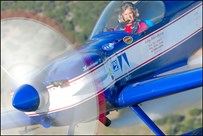 Debby Rihn-Harvey, a native Nebraskan, is a third generation aviator, who began flight instruction with her father as the teacher. Her career includes being a captain for Southwest Airlines, managing a flight school and fixed-base operation at La Porte Municipal Airport. Rihn-Harvey is an Aerobatic Competency Evaluator for the International Council of Airshows and a FAA Designated Flight Examiner administering flight exams for Private Pilot through Airline Transport Pilot certificates.
Debby Rihn-Harvey, a native Nebraskan, is a third generation aviator, who began flight instruction with her father as the teacher. Her career includes being a captain for Southwest Airlines, managing a flight school and fixed-base operation at La Porte Municipal Airport. Rihn-Harvey is an Aerobatic Competency Evaluator for the International Council of Airshows and a FAA Designated Flight Examiner administering flight exams for Private Pilot through Airline Transport Pilot certificates.
Debby Rihn-Harvey is one of the highest ranked aerobatics competitors in the U.S. She won the Betty Skelton ‘First Lady of Aerobatics’ trophy in 2011 and is the longest standing member of the U.S. Unlimited Aerobatics Team, representing both North America and Europe. She has previously been inducted into the EAA Sport Aviation Hall of Fame in 2007, received the Loyd P. Nolan Lifetime Achievement Award in 2010 and the International Ninety Nine’s Award of Achievement for Contributions to Aviation in 2012.
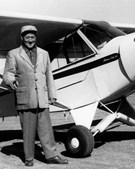 Andrew A. Risser, born in Wisner, Nebraska in 1894, learned to fly in 1926 and established the Norfolk Flying School in 1928. In his forty years as a pilot, Risser flew crop dusting operations, air tours, airmail flights, barnstorming, Civil Defense black-out inspections, law enforcement aerial searches, and other emergency flights. He was honored by the Daniel Guggenheim Foundation for Outstanding Achievements in the Promotion of Aviation in Norfolk, Nebraska, designated Mr. Norfolk Aviation by the Chamber of Commerce and dubbed Best Cub Pilot in the World by William Piper. Risser retired from flying in 1966 after teaching 2,300 student pilots and logging 21,000 hours of flight time.
Andrew A. Risser, born in Wisner, Nebraska in 1894, learned to fly in 1926 and established the Norfolk Flying School in 1928. In his forty years as a pilot, Risser flew crop dusting operations, air tours, airmail flights, barnstorming, Civil Defense black-out inspections, law enforcement aerial searches, and other emergency flights. He was honored by the Daniel Guggenheim Foundation for Outstanding Achievements in the Promotion of Aviation in Norfolk, Nebraska, designated Mr. Norfolk Aviation by the Chamber of Commerce and dubbed Best Cub Pilot in the World by William Piper. Risser retired from flying in 1966 after teaching 2,300 student pilots and logging 21,000 hours of flight time.
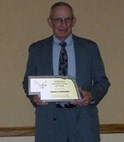 Ronald Dale Rodgers was born on December 23, 1933 in Cozad, Nebraska. He graduated from Kearney High School in 1951. Soon after he served the US Navy from 1951 to 1954, where he flew as Crew Chief aboard a PBM seaplane during the Korean conflict. Rodgers was awarded an Air Medal for meritorious achievement while flying over Pusan Bay.
Ronald Dale Rodgers was born on December 23, 1933 in Cozad, Nebraska. He graduated from Kearney High School in 1951. Soon after he served the US Navy from 1951 to 1954, where he flew as Crew Chief aboard a PBM seaplane during the Korean conflict. Rodgers was awarded an Air Medal for meritorious achievement while flying over Pusan Bay.
He received his private pilot fixed wing license in 1957 and joined the Army to attend Warrant Officer Candidate School. He graduated from the Army helicopter maintenance school and went on to graduate from helicopter pilot training in May of 1959. He served a tour in Korea and then in South Vietnam in 1961. While in Vietnam, Rodgers flew 18 passenger double rotor helicopters, ferrying troops. He served as assistant maintenance officer with the first helicopter unit.
Rodgers returned to civilian flying in 1962. He flew for several years with Mississippi Valley Helicopters of Wahoo, NE. There he flew support of the construction of the Nike-Minuteman missile site. He flew for the filming of the Chevrolet Corvette commercials over the Royal Gorge in Colorado. He then worked for a Colorado company spraying crops and forest fires.
Rodgers taught US Army primary helicopter pilots for ten years at Fort Walters, Texas. He returned to Kearney, NE in 1973 where he started Rodgers Helicopter Service. Here he did crop spraying, power line patrol and construction, heavy lifting and rescue. In 1981-2, Rodgers set up an air ambulance service. After many hours of labor, Good Samaritan Air Care of Kearney transported it’s first patient on March 4, 1982. They quickly provided critical care flights for Nebraska and Northern Kansas. Ron Rodgers has accumulated over 22,000 hours in helicopters and fixed wing aircraft. His dedication and safety record as a pilot, flight instructor and mechanic over the past 60 years are the reasons he is being inducted into the Nebraska Aviation Hall of Fame.
 The Hershey Flying Service was established in 1949 by Pete and Floyd Roueche as an aerial application business. They started the season in the southern states and eventually made their way back to Nebraska providing aerial application along the way Their first plane, a 1939 J-3 Cub was a wreck they picked up for $400. They bolted on a tank and started spraying.
The Hershey Flying Service was established in 1949 by Pete and Floyd Roueche as an aerial application business. They started the season in the southern states and eventually made their way back to Nebraska providing aerial application along the way Their first plane, a 1939 J-3 Cub was a wreck they picked up for $400. They bolted on a tank and started spraying.
In 1969, the brothers purchased their first Ag-Cat and fell in love with the aircraft. Five years later, they decided to retire from the aerial application business and go strictly into repairing, refurbishing, and modifying the hardworking Grumman Ag-Cat. They were responsible for building all their jigs and fixtures for the aircraft, a skill they had both learned working in California at the aircraft bomber and pursuit factories prior to WWII. Later, they served their country by joining the Armed Forces, Pete as an Army infantry soldier and Floyd as an aircraft mechanic.
The Roueches were responsible for many STC (Supplemental Type Certificate) modifications to the Ag- Cat, along with holding numerous PMA (Parts Manufacturer Approval) replacement parts to support the fleet. Hershey Flying Service became the premier repair facility for Ag-Cats with a customer base made up of the US, Canada, Mexico, and numerous countries around the world, including Australia, Chile, the United Kingdom, and Venezuela. Goldene, Pete’s wife, who worked alongside her husband once said, “We do pretty much everything from the ground up.”
An STC of which The Roueches were most proud was increasing the hopper by 14 inches, allowing it to carry 425 gallons of liquid during a spraying operation instead of the normal 300 gallon capacity. They built the fiberglass hopper and nicknamed the Ag-Cat “The Fat Cat.”
A series of shops housed the different manufacturing processes: fiber glass, metal stamping and part fabrication, painting, framework, and mechanic work. The ventilated paint shop walls and ceiling fixtures bore one color, that of the Ag-Cat yellow glow!
For years, many young men from the Hershey area were employed at The Hershey Flying Service. Under the tutelage and mentorship of Pete and Floyd Roueche, they gained knowledge, the importance of attention to detail, and a sense of pride in doing a job well. Those life-long lessons have left lasting impressions.
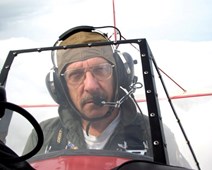 Richard E. Russell was born in Broken Bow, NE and attended schools in Broken Bow and Kearney. He is a Life member of the University of Nebraska Alumni Association. A Korean and Vietnam veteran, Russell retired from the US Air Force in 2001 after serving a total of 41 years active, reserve and guard service. Throughout his military service, he received numerous awards, including Meritorious Service Medals, four Humanitarian Service Medals and was selected one of twelve Outstanding Air Force Security Police in 1982. He also received several commendations and citations from the Assistant Secretary of the Air Force and the Secretary of Defense during his time as the Sixth Air Force Reserve Command Chief Master Sergeant. In 1984, Dick became an Aviation Safety Inspector for the FAA working from a GS7 position to a GM15 middle manager in just four years. Among his assignments was project manager for the civil certification of the Bell-Boeing Tiltrotor aircraft, manager of all FAA flight programs and as Aircraft Policy Officer for the FAA flight inspection program based in Oklahoma. Russell has been an active ham radio operator since high school. He served with the Civil Air Patrol and Coast Guard Auxiliary as an Emergency Services Operations Specialist, Incident Commander and search and rescue pilot for over 40 years. Dick has been an adjunct professor in aviation, aerospace studies, management, organizational development, criminal justice, law enforcement and police science for over 30 years and has taught at several colleges and universities including Embry Riddle Aeronautical University. He retired from the FAA but continued his aviation career as a flight instructor and FAA designated examiner for Flight Safety International. He currently serves as an adjunct professor of aviation studies for Southeastern Oklahoma State University, an aviation insurance agent and consultant and partner in DNR Aviation, LLC, for the preservation and continued flying of antique and classic airplanes. He has accumulated over 21,000 accident free hours in military and civilian aircraft since his first flight at Broken Bow in a Howard DGA15. Russell holds an ATP Certificate with CE650 and CE560XL type ratings and flight instructor certificates for airplanes, helicopters and seaplanes. Maintaining a history of community involvement, Dick has been an active member of the Air Force Association and Aerospace Education Foundation doing education in aerospace for over 25 years. He is a member of the Flying Conestogas and a regular attendee at the annual Nebraska Antique Airplane Association fly-in at Minden. Russell is immediate past Commander of the Central States Shrine Flying Fez Association and was recognized in 2006 as one of thirteen Masons in Kansas to receive the DeMolay International Legion of Honor. Russell feels fortunate to have flown everything from his Meyers OTW biplane to the F16 and F4 aircraft.
Richard E. Russell was born in Broken Bow, NE and attended schools in Broken Bow and Kearney. He is a Life member of the University of Nebraska Alumni Association. A Korean and Vietnam veteran, Russell retired from the US Air Force in 2001 after serving a total of 41 years active, reserve and guard service. Throughout his military service, he received numerous awards, including Meritorious Service Medals, four Humanitarian Service Medals and was selected one of twelve Outstanding Air Force Security Police in 1982. He also received several commendations and citations from the Assistant Secretary of the Air Force and the Secretary of Defense during his time as the Sixth Air Force Reserve Command Chief Master Sergeant. In 1984, Dick became an Aviation Safety Inspector for the FAA working from a GS7 position to a GM15 middle manager in just four years. Among his assignments was project manager for the civil certification of the Bell-Boeing Tiltrotor aircraft, manager of all FAA flight programs and as Aircraft Policy Officer for the FAA flight inspection program based in Oklahoma. Russell has been an active ham radio operator since high school. He served with the Civil Air Patrol and Coast Guard Auxiliary as an Emergency Services Operations Specialist, Incident Commander and search and rescue pilot for over 40 years. Dick has been an adjunct professor in aviation, aerospace studies, management, organizational development, criminal justice, law enforcement and police science for over 30 years and has taught at several colleges and universities including Embry Riddle Aeronautical University. He retired from the FAA but continued his aviation career as a flight instructor and FAA designated examiner for Flight Safety International. He currently serves as an adjunct professor of aviation studies for Southeastern Oklahoma State University, an aviation insurance agent and consultant and partner in DNR Aviation, LLC, for the preservation and continued flying of antique and classic airplanes. He has accumulated over 21,000 accident free hours in military and civilian aircraft since his first flight at Broken Bow in a Howard DGA15. Russell holds an ATP Certificate with CE650 and CE560XL type ratings and flight instructor certificates for airplanes, helicopters and seaplanes. Maintaining a history of community involvement, Dick has been an active member of the Air Force Association and Aerospace Education Foundation doing education in aerospace for over 25 years. He is a member of the Flying Conestogas and a regular attendee at the annual Nebraska Antique Airplane Association fly-in at Minden. Russell is immediate past Commander of the Central States Shrine Flying Fez Association and was recognized in 2006 as one of thirteen Masons in Kansas to receive the DeMolay International Legion of Honor. Russell feels fortunate to have flown everything from his Meyers OTW biplane to the F16 and F4 aircraft.
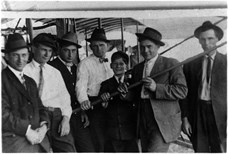 In 1911, seven brothers constructed and flew one of the first heavier-than-air machines made in Nebraska. The seven were the Savidge brothers, George, John, Joe, Dave, Matt, Phillip and Louis from Ewing, NE. In partnership as inventors, mechanics and pilots, their aircraft was an exposed cockpit biplane model.
In 1911, seven brothers constructed and flew one of the first heavier-than-air machines made in Nebraska. The seven were the Savidge brothers, George, John, Joe, Dave, Matt, Phillip and Louis from Ewing, NE. In partnership as inventors, mechanics and pilots, their aircraft was an exposed cockpit biplane model.
The dream of flying was born early in the brothers. There was a large barn on the Savidge place, located eleven miles South and ½ West of Ewing. The haymow of this barn became the workshop for the brothers. The boys started with gliders, studying hawks in flight. They then built models, increasing them in size until they were in proportion to the weight of a cat. They then tied one of the farm cats to the glider and would slide them out of the haymow door. When the gliders were perfected so that they would land with a live cat without crashing, they enlarged their gliders to work with a man.
The boys bought their engines, propellers and rubber tired wheels custom made. They had no plans but their own to work from and their first flights were made from a meadow on their home place. After awhile, they perfected their craft so that they could circle and land the plane to the same place they had taken off from. They put a notice in the paper stating that anyone who wished to see them fly could come to the farm on May 7, 1911. It was on that evening that Matt Savidge became Nebraska’s first pilot.
The brothers perfected their airplane until they were sure it was safe and then started on barnstorming trips in the Midwest states. For five years the Savidges successfully flew their plane. During this time Matt, the most daring of the boys, learned to loop the plane as well as other stunts. He was the first pilot in the world to introduce skywriting. He mapped out his name on paper. Then tied smoke candles to the frame of his plane.
During the summer of the fifth year, the boys completed one of their airplanes. John took it up for a test flight but was not satisfied with the way it worked. Matt then decided to try it for some of his stunts. The rest of the brothers tried to stop him but Matt overrode them. He ascended to a height of five or six hundred feet and started a spiral glide. All went well until the last hundred feet when the plane plunged straight down, nose first. The front of the plane was driven into the earth and the engine landed on Matt, who was killed instantly. It has remained a mystery with the Savidges why the plane crashed, as the engine was running smoothly until it hit the earth. There was speculation that strut wires or the control wires jammed. This tragic accident ended their flying careers.
The planes were dismantled, the engines boxed and the wings and propellers stored in the barn. Parts of these planes are in the possession of different members of the Savidge family today.
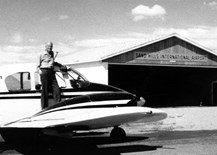 Rector E. Searle, born in 1896 in Ogallala, Nebraska, started the R.E. Searle Motor Co., which he operated from 1916 to 1967. In 1919 Searle bought a World War I surplus Jenny, the first airplane in Keith County. He developed an airport site on the Searle Ranch just west of Ogallala, where he erected a hangar.
Rector E. Searle, born in 1896 in Ogallala, Nebraska, started the R.E. Searle Motor Co., which he operated from 1916 to 1967. In 1919 Searle bought a World War I surplus Jenny, the first airplane in Keith County. He developed an airport site on the Searle Ranch just west of Ogallala, where he erected a hangar.
Searle sold his first airplane in 1921. During the next fifty years he sold more than 2,000 airplanes and was awarded the coveted million dollar sales award three times from Piper Aircraft Corporation. Rector got his first pilot’s license in 1935. The City of Ogallala acquired the land for a municipal airport in 1970 and dedicated Searle field in ceremonies held in 1972. Searle flew more than one million miles in his 15,000 hours in numerous aircraft.
Evelyn Sharp was a Nebraska native who was one of the first women to ferry US Army Air Force fighters during WWII. Her background includes a connection to homesteading, which is why Homestead NM of America will honor her with a banner to be featured with others on the monument visitor center. In conjunction with the Centennial of Flight the monument will host the historian of the Wright Brothers National Memorial to speak about the Wright Brothers accomplishments. There will be various hands on activities from organizations such as the Nebraska Aviation Hall of Fame, the Strategic Air and Space Museum and the Nebraska Air National Guard. Flyovers will be held including a P-51, which Evelyn flew, KC-135, and an L3 & L5 just to name a few.
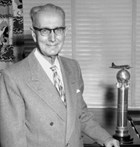 E. J. Sias incorporated the Lincoln Auto and Tractor School in 1918 and two years later started training aircraft mechanics. In 1928, Sias acquired the former Ray Page flight school and combined it with his mechanics school under the name Lincoln Airplane and Flying School. Flight training was first conducted at the old Municipal Airport in Lincoln, NE but was moved to Union Airport, which Sias owned. Union Airport was located north of Fletcher Avenue between North 56th and 70th. By 1938 the schools were “widely known throughout the world”. In 1939, the Chief of the Army Air Corp, Major General Henry “Hap” Arnold, selected the nine best civilian flying schools in the nation to train Air Corps pilots. Sias’ school was one of them. Bad flying weather doomed the Air Corps training in Lincoln, so Sias moved the Air Corps flight training to Lakeland, FLin late 1940 and sold it. Sias then moved his civilian training program from the old Municipal Airport to Union Airport, where it continued in conjunction with the University of Nebraska. This federally sponsored program had been initiated in 1939 and was aptly named, the Civilian Pilot Training Program. It served primarily as the screening program for potential military pilots. It was phased out in 1944. In 1941, the Lincoln Airplane and Flying School celebrated it’s 21st anniversary. Sias received dozens of telegrams and letters of congratulations, including messages from major airlines, plane manufactures, the Chairman of the Civil Aeronautics Board and the Chief of the Army Air Corps. Sias dissolved both his Lincoln Airplane and Flying School and the Lincoln Aeronautical Institute corporations in July 1945, when he was 68 and retired. Sias died in 1955 in Lincoln. Union Airport was closed in 1964 when municipal aviation returned to the deactivated air base.
E. J. Sias incorporated the Lincoln Auto and Tractor School in 1918 and two years later started training aircraft mechanics. In 1928, Sias acquired the former Ray Page flight school and combined it with his mechanics school under the name Lincoln Airplane and Flying School. Flight training was first conducted at the old Municipal Airport in Lincoln, NE but was moved to Union Airport, which Sias owned. Union Airport was located north of Fletcher Avenue between North 56th and 70th. By 1938 the schools were “widely known throughout the world”. In 1939, the Chief of the Army Air Corp, Major General Henry “Hap” Arnold, selected the nine best civilian flying schools in the nation to train Air Corps pilots. Sias’ school was one of them. Bad flying weather doomed the Air Corps training in Lincoln, so Sias moved the Air Corps flight training to Lakeland, FLin late 1940 and sold it. Sias then moved his civilian training program from the old Municipal Airport to Union Airport, where it continued in conjunction with the University of Nebraska. This federally sponsored program had been initiated in 1939 and was aptly named, the Civilian Pilot Training Program. It served primarily as the screening program for potential military pilots. It was phased out in 1944. In 1941, the Lincoln Airplane and Flying School celebrated it’s 21st anniversary. Sias received dozens of telegrams and letters of congratulations, including messages from major airlines, plane manufactures, the Chairman of the Civil Aeronautics Board and the Chief of the Army Air Corps. Sias dissolved both his Lincoln Airplane and Flying School and the Lincoln Aeronautical Institute corporations in July 1945, when he was 68 and retired. Sias died in 1955 in Lincoln. Union Airport was closed in 1964 when municipal aviation returned to the deactivated air base.
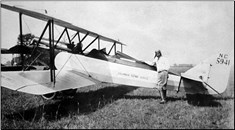 John Siems, through his flying career, reflects the extraordinary efforts needed to get Nebraska aviation—literally—"off the ground." Siems received his pilot's license in 1930, one of the first 4,000 in the nation. He managed the Columbus, Nebraska airport where, as a barnstormer and aerial acrobat, he caught the public's attention, then taught them to fly. In 1940 Siems started the Fremont, Nebraska airport. World War II interrupted his civilian career, but not his flying. He taught more than 2,000 students in Cadet Pilot Training School. After the war Siems returned to Fremont and qualified as a flight examiner. He worked untiringly on the development of the airport and the Fremont community until his retirement in 1970.
John Siems, through his flying career, reflects the extraordinary efforts needed to get Nebraska aviation—literally—"off the ground." Siems received his pilot's license in 1930, one of the first 4,000 in the nation. He managed the Columbus, Nebraska airport where, as a barnstormer and aerial acrobat, he caught the public's attention, then taught them to fly. In 1940 Siems started the Fremont, Nebraska airport. World War II interrupted his civilian career, but not his flying. He taught more than 2,000 students in Cadet Pilot Training School. After the war Siems returned to Fremont and qualified as a flight examiner. He worked untiringly on the development of the airport and the Fremont community until his retirement in 1970.
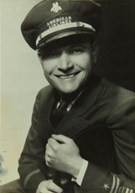 Moorefield, Nebraska native, Eyer L. “Slonnie” Sloniger went on to have one of the more colorful and interesting carriers of any of the early aviation pioneers of the Golden Age of Aviation. Slonnie or Old Number 1 was a Spad pilot in the US Air Service during WWI, then a barnstormer, racer, test pilot, an early air mail pilot moving on to a carrier as a commercial pilot with over 24,000 hours. Sloniger learned to fly upon entering the Heavier Than Air Division of the US Army Signal Corps because he “just didn’t want to walk or brush horses.” After WWI Sloniger was a test pilot and barnstormer for Ray Page’s Lincoln Standard Aircraft Company. He flew for American oil companies in Mexico delivering their employee payroll bomber style to avoid the Mexican Banditos that worked the highways and railroads. During negotiations for an air mail contract in China, Sloniger was confused by the Chinese Army as a Russian spy, was arrested and almost shot as a spy. Employed by Robertson Airlines, he was one of the pilots that flew the inaugural flight for Contract Air Mail Route #2 with the likes Charles A. (Slim) Lindbergh and another Nebraska native, Harlan (Bud) Gurney. Robertson Airlines eventually evolved into what is now known as American Airlines with Sloniger being the first pilot thus having the seniority Number of One. After 20 years with American Airlines, Sloniger moved to Matson Airlines Director of Flight Operations and when that venture failed, he flew on demand or charter flights for Cal Eastern.
Moorefield, Nebraska native, Eyer L. “Slonnie” Sloniger went on to have one of the more colorful and interesting carriers of any of the early aviation pioneers of the Golden Age of Aviation. Slonnie or Old Number 1 was a Spad pilot in the US Air Service during WWI, then a barnstormer, racer, test pilot, an early air mail pilot moving on to a carrier as a commercial pilot with over 24,000 hours. Sloniger learned to fly upon entering the Heavier Than Air Division of the US Army Signal Corps because he “just didn’t want to walk or brush horses.” After WWI Sloniger was a test pilot and barnstormer for Ray Page’s Lincoln Standard Aircraft Company. He flew for American oil companies in Mexico delivering their employee payroll bomber style to avoid the Mexican Banditos that worked the highways and railroads. During negotiations for an air mail contract in China, Sloniger was confused by the Chinese Army as a Russian spy, was arrested and almost shot as a spy. Employed by Robertson Airlines, he was one of the pilots that flew the inaugural flight for Contract Air Mail Route #2 with the likes Charles A. (Slim) Lindbergh and another Nebraska native, Harlan (Bud) Gurney. Robertson Airlines eventually evolved into what is now known as American Airlines with Sloniger being the first pilot thus having the seniority Number of One. After 20 years with American Airlines, Sloniger moved to Matson Airlines Director of Flight Operations and when that venture failed, he flew on demand or charter flights for Cal Eastern.
When Sloniger finally retired, he never took the controls again. He always said “When I could not do as good a job of flying as I demanded of others, I would stop. A man who keeps flying beyond his time becomes an object of pity.”
“You can always tell when a man has lost his soul to flying. The poor guy is hopelessly committed to stopping whatever he is doing long enough to look up and make sure the aircraft purring overhead continues on course and does not suddenly fall out of the sky. It is also his bounden duty to watch every aircraft within view take off and land.”
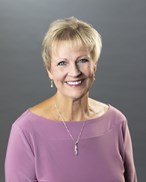 Diana L. Smith has a long history of contributing to the advancement of aviation in Beatrice and across the State of Nebraska. Her efforts in promoting aviation are exemplified through her strong motivation and outstanding enthusiasm, while serving as manager of the Beatrice Airport and on numerous boards and commissions.
Diana L. Smith has a long history of contributing to the advancement of aviation in Beatrice and across the State of Nebraska. Her efforts in promoting aviation are exemplified through her strong motivation and outstanding enthusiasm, while serving as manager of the Beatrice Airport and on numerous boards and commissions.
In 1971, Diana began employment at the Beatrice Airport advancing to airport manager in the year 2000, the position she currently holds today. She was a certified weather observer and is a member of the Beatrice Airport Foundation. Through these many years, her professionalism and dedication have enriched the aviation community.
Diana is a founding member of the Nebraska Aviation Council and was instrumental in the creation of the annual Nebraska Aviation Symposium. She served as secretary/treasurer for the Nebraska Aviation Council from 1992-1996, as vice president in 2011, 2013, 2017 and 2018, assuming its chairmanship in 1998, 2014-2016. Diana is also a member of the Nebraska Association of Airport Officials and served as secretary/treasurer from 1995-1998. She is a lifetime member of the Flying Conestoga’s, an aviation booster club, serving as secretary since 2009. Diana is resourceful, creative, and solution-oriented.
In 2013, Governor Dave Heineman appointed Diana to the Nebraska Aeronautics Commission. In this position, she works closely with the Nebraska Department of Transportation, Division of Aeronautics and many local communities across the state in the administration of various state and federal programs which focus on the development of airports. She served the commission as chairperson in 2015, her term running until 2019.
Diana is a strong and effective aviation supporter and has encouraged many pilots both young and old to pursue their aviation interests. She is well-respected by the aviation community and is proactive in meeting the challenges facing Nebraska’s flying public.
Nebraska’s aviation community has most certainly benefited from her efforts.
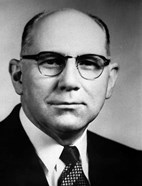 Frank E. Sorenson, the dean of Nebraska air education, advanced the understanding of aviation and aerospace for countless Nebraska students and teachers. Born in Phillips, Nebraska, he earned his bachelors, masters, and doctorate degrees from the University of Nebraska, then joined its faculty.
Frank E. Sorenson, the dean of Nebraska air education, advanced the understanding of aviation and aerospace for countless Nebraska students and teachers. Born in Phillips, Nebraska, he earned his bachelors, masters, and doctorate degrees from the University of Nebraska, then joined its faculty.
His accomplishments were many and nationally recognized. Sorenson organized an annual teacher workshop on general aviation, co-sponsored by the Nebraska Department of Aeronautics, and a student flight program. He served for many years on the Civil Air Patrol education committee with the rank of colonel, on NASA’s education advisory committee, and as an officer of the Link Foundation (a long-time underwriter of aerospace education).
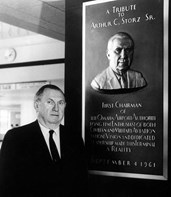 Arthur C. Storz Sr., a World War I Airman and influential Omaha civic leader, helped developed Strategic Air Command (SAC) at Offutt Air Force Base. Storz was a charter member of the SAC Consultation Committee, serving as chair from 1963 to 1971 and Chair Emeritas from 1971 until his death in 1978.
Arthur C. Storz Sr., a World War I Airman and influential Omaha civic leader, helped developed Strategic Air Command (SAC) at Offutt Air Force Base. Storz was a charter member of the SAC Consultation Committee, serving as chair from 1963 to 1971 and Chair Emeritas from 1971 until his death in 1978.
Storz was a respected spokesperson for civil aviation and exercised leadership in expanding the Omaha Municipal Airport into the Jet Age. He helped motivate the Omaha City Council to establish the Omaha Airport Authority, serving as its first chair from 1959 to 1969 and Chair Emeritas from 1969 to 1978. In recognition of his dedicated efforts and accomplishments, the expressway between Eppley Airfield and the Interstate is named in his honor.
 Charles Edward Taylor was born in Illinois, May 24, 1868. At age ten he moved with his family to Lincoln where he attended the Lincoln Public Schools. In 1890 Taylor moved to Kearney where he fabricated metal house numbers. In 1901 he worked for the Wright Cycle Company repairing bicycles, allowing the Wright brothers to concentrate on their aeronautical work. He worked with them to design the engine for their glider. Taylorbuilt the engine while Orville and Wilbur built the frame. The engine was built in six weeks, weighed 170 pounds, and produced twelve horsepower at 1,025 revolutions per minute. On December 17, 1903 the first sustained powered flight was accomplished by Orville and Wilbur Wright at Kitty Hawk, NC. The dawn of powered flight had arrived. Taylor died in 1956 and was interred in the Portal of Folded Wings, Valhalla Aviation Memorial in Burbank, CA. In 1965 Taylor was inducted into the National Aviation Hall of Fame in Dayton, OH as the world’s First Airplane Mechanic. The Charles Taylor “Master Mechanic” Award Program, recognizing the “unsung heroes of aviation” who have served at least fifty years in aviation maintenance, was introduced by the Federal Aviation Administration in 1993. May 24, 2003, the 135th anniversary of his birth, will be declared “Aviation Maintenance Technicians Day” by a proclamation from the Governor of the State of Nebraska.
Charles Edward Taylor was born in Illinois, May 24, 1868. At age ten he moved with his family to Lincoln where he attended the Lincoln Public Schools. In 1890 Taylor moved to Kearney where he fabricated metal house numbers. In 1901 he worked for the Wright Cycle Company repairing bicycles, allowing the Wright brothers to concentrate on their aeronautical work. He worked with them to design the engine for their glider. Taylorbuilt the engine while Orville and Wilbur built the frame. The engine was built in six weeks, weighed 170 pounds, and produced twelve horsepower at 1,025 revolutions per minute. On December 17, 1903 the first sustained powered flight was accomplished by Orville and Wilbur Wright at Kitty Hawk, NC. The dawn of powered flight had arrived. Taylor died in 1956 and was interred in the Portal of Folded Wings, Valhalla Aviation Memorial in Burbank, CA. In 1965 Taylor was inducted into the National Aviation Hall of Fame in Dayton, OH as the world’s First Airplane Mechanic. The Charles Taylor “Master Mechanic” Award Program, recognizing the “unsung heroes of aviation” who have served at least fifty years in aviation maintenance, was introduced by the Federal Aviation Administration in 1993. May 24, 2003, the 135th anniversary of his birth, will be declared “Aviation Maintenance Technicians Day” by a proclamation from the Governor of the State of Nebraska.
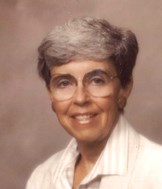 LaQuita J. "Keeta" Thompson grew up in Hastings, Nebraska. Her first remembrances of wanting to fly were during WWII when she watched the B-17s practice their low-level flying maneuvers over her farm. Thereafter in her bedtime dreams, she jumped from the branches of their big cottonwood tree, using her arms as the wings of an airplane. A story reminiscent of the Kansan Amelia Earhart!
LaQuita J. "Keeta" Thompson grew up in Hastings, Nebraska. Her first remembrances of wanting to fly were during WWII when she watched the B-17s practice their low-level flying maneuvers over her farm. Thereafter in her bedtime dreams, she jumped from the branches of their big cottonwood tree, using her arms as the wings of an airplane. A story reminiscent of the Kansan Amelia Earhart!
After rearing four sons, Keeta's flying career began at age 46 at Scotts Bluff County Airport with a 1976 Christmas present from her husband Dick, a non-pilot. In twenty months she qualified as a private, commercial and instrument rated pilot, as well as a flight instructor. She ultimately qualified as an instructor in SEL, MEL, SES, Instrument and Glider. In 1981, Keeta earned her Airline Transport Pilot certificate, the second woman in Nebraska to obtain this rating. Three years later she was recognized as a Gold Seal Instructor by the Federal Aviation Administration.
In 1978, Keeta began her professional career at Valley Airways, serving as charter pilot and instructor. Later, she flew as a corporate pilot for Mutual of Omaha, Papas Trucking, Coca-Cola, Brown Bean Co, and Western Pathology Laboratories. Keeta was hired by the US Federal Parks System to detect and count wildlife and also served as an aerial photography pilot in Nebraska and Wyoming for National Geographic Society. She served as president of her own company, Bluff Aero, Inc. at the Scotts Bluff County Airport.
Keeta has received many awards for her contributions to aviation. In 1982, she was selected as the Central Region's "Flight Instructor of the Year." The next year, the Nebraska Department of Aeronautics presented her with an "Outstanding Service Award." In 1990, Governor Kay Orr appointed her to the Nebraska State Airline Authority Board. The following year, Governor E. Benjamin Nelson asked her to serve on the Nebraska Aeronautics Commission, the first woman to do so.
Keeta is also credited with initiating and directing a successful promotion to the Kansas City FAA for the installation of the RCO in 1992. She and William B. Heilig were instrumental in chartering EAA Chapter 608. Keeta taught semester classes of private, commercial, and instrument credit courses at Nebraska Western College, and pinch hitter courses at the airport as well as updated seminars for Civil Air Patrol pilots' search and rescue training.
LaQuita "Keeta" Thompson has logged 7,642 hours. Her contributions to the aviation industry, her public support of aviation, and her willingness to educate youth in her community are exemplary.
 Roy W. Timm was born in Wahoo, Nebraska and raised on a farm southwest of Ithaca, Nebraska. He moved to Iowa at a early age, graduated from high school at Green, Iowa and became involved in aviation. Roy traded labor for flying time and instruction from a farmer-flight instructor, who had a strip on a farm near Floyd, Iowa. Upon returning from the Army Roy helped at the family farm and worked at the Fremont, Nebraska airport, instructing, spraying crops, flying charter, and in the airshow business. In 1955 he earned his Airline Transport Rating. He moved to Keokuk, Iowa when the Hoerner Box company bought their first airplane, a Cessna 310. This was the start of a thirty-year corporate aviation history with Hoerner Box company and their succeeding companies. Upon retirement in 1982 he moved back to the farm and returned to flight instruction. Roy instructed for COMAIR in Cincinnati, American Central Airlines, Mid Continent Airlines, and Sky Harbor Air Service in Omaha. During this period Roychecked instructors, pilots, and students. He passed on knowledge gained from more than forty years and 30,000 hours of flying.
Roy W. Timm was born in Wahoo, Nebraska and raised on a farm southwest of Ithaca, Nebraska. He moved to Iowa at a early age, graduated from high school at Green, Iowa and became involved in aviation. Roy traded labor for flying time and instruction from a farmer-flight instructor, who had a strip on a farm near Floyd, Iowa. Upon returning from the Army Roy helped at the family farm and worked at the Fremont, Nebraska airport, instructing, spraying crops, flying charter, and in the airshow business. In 1955 he earned his Airline Transport Rating. He moved to Keokuk, Iowa when the Hoerner Box company bought their first airplane, a Cessna 310. This was the start of a thirty-year corporate aviation history with Hoerner Box company and their succeeding companies. Upon retirement in 1982 he moved back to the farm and returned to flight instruction. Roy instructed for COMAIR in Cincinnati, American Central Airlines, Mid Continent Airlines, and Sky Harbor Air Service in Omaha. During this period Roychecked instructors, pilots, and students. He passed on knowledge gained from more than forty years and 30,000 hours of flying.
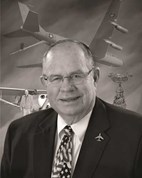 Richard L. Trail, Lt. Col. USAF (retired), was born and raised on a farm south of McCook, Nebraska. He learned to fly in 1953 in his father’s J-3 Cub. Immediately after high school, he received an appointment to the newly formed Air Force Academy. He was the first native Nebraskan to attend and graduate from there. He was the first student to solo in a sailplane and the first to fly in and out of the new airbase built for the Academy.
Richard L. Trail, Lt. Col. USAF (retired), was born and raised on a farm south of McCook, Nebraska. He learned to fly in 1953 in his father’s J-3 Cub. Immediately after high school, he received an appointment to the newly formed Air Force Academy. He was the first native Nebraskan to attend and graduate from there. He was the first student to solo in a sailplane and the first to fly in and out of the new airbase built for the Academy.
Trail was rated as both a navigator and pilot and flew the T-28, T-33, T-34, T-39 and the C47. His career was mainly as a aerial re-fueler. He began in the KC-97 and then went on to the KC-135 logging about 7000 hours as pilot, co-pilot and instructor.
He spent 450 days in theatre during the Vietnam war flying over two hundred sorties. The most notable was in 1967 when his crew won the MacKay Trophy for the Meritorious Flight of the Year. The crew was contacted by a carrier based Navy tanker which was running low on fuel and would soon have to ditch. Trail’s crew decided to help and this was the first time an Air Force tanker had re-fueled a Navy plane. The Navy tanker had fuel on board to pass to fighters, but none for themselves. While hooked to the Air Force tanker, the Navy tanker re-fueled several Navy fighters. This was the first tri-level aerial re-fueling in history.
Awards won by Trail included the Distinguished Flying Cross and the Air Medal with four Oak Leaf Clusters.
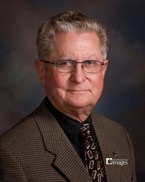 Gary M. Trego was born in North Platte, Nebraska on August 11, 1937. After serving in the U.S. Navy and attending the University of Nebraska - Lincoln, he returned to work on the family ranch in Sutherland, NE in the early 60's. He enjoyed ranching but had an additional desire — to fly. He convinced his father that he could perform all his ranch duties and run an aviation business on the side. Trego built a sod strip on the family ranch and obtained a Part 135 charter certificate. Trego Charter Service was born. In,1966, Trego and his wife, Terry, established Trego Aviation, Inc. in Ogallala, NE, owning and operating the FBO. Trego held a Part 135 charter certificate and served as chief pilot. In 1968, he moved his flying career to North Platte, where he became president of Lee Bird Flying Service. In 1970, Trego became the owner of the FBO in North Platte and re-established it as Trego Aviation, Inc. Once again, he held a Part 135 charter certificate and was chief pilot and Director of Operations. The Tregos have remained owners ever since.
Gary M. Trego was born in North Platte, Nebraska on August 11, 1937. After serving in the U.S. Navy and attending the University of Nebraska - Lincoln, he returned to work on the family ranch in Sutherland, NE in the early 60's. He enjoyed ranching but had an additional desire — to fly. He convinced his father that he could perform all his ranch duties and run an aviation business on the side. Trego built a sod strip on the family ranch and obtained a Part 135 charter certificate. Trego Charter Service was born. In,1966, Trego and his wife, Terry, established Trego Aviation, Inc. in Ogallala, NE, owning and operating the FBO. Trego held a Part 135 charter certificate and served as chief pilot. In 1968, he moved his flying career to North Platte, where he became president of Lee Bird Flying Service. In 1970, Trego became the owner of the FBO in North Platte and re-established it as Trego Aviation, Inc. Once again, he held a Part 135 charter certificate and was chief pilot and Director of Operations. The Tregos have remained owners ever since.
In 1994, their daughter, Traci and son-in-law, Vince Dugan became co-owners and the name was changed to Trego/Dugan Aviation, Inc. In the late 90's Trego received a type rating in the Citation 500 series of private jets. In 2003, Trego-Dugan Jet Management, LLC was created and a charter base was established at Chicago Executive Airport. At the same time, Trego/Dugan Aviation, Inc formed a subsidiary and purchased the assets of Grand Island Aviation, becoming the FBO in Grand Island, NE. In 2009, Trego/Dugan expanded into airline ground handling, performing counter and baggage services. As of November 2011, the Trego/Dugan family of companies operates the FBOs in North Platte and Grand Island, conducts airline ground handling for two airlines in five states and has six private jets on it’s Part 135 charter certificate. Trego has over 13,000 hours of flight time in aircraft as varied as a Piper Cub and the Citation II business jet. His ratings include commercial, multi-engine, airline Transport Pilot, CFI and CFII. He has received numerous aviation awards including the 1990 Nebraska Flight Instructor of the Year and the 1990 Flight Instructor of the Year–Central Region. Trego Aviation was the regional Piper Dealer of the Decade in the 1980's. Trego was appointed by the Governor of Nebraska as a Commissioner of the Nebraska Department of Aeronautics. He served on the Commission from 1990 to 2000 and as Chairman in 1993 and 1998.
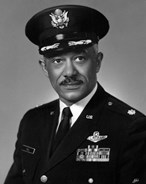 Lt. Colonel Harrison “Harry” Tull was drafted into a segregated Army Air Corps in 1943 and was accepted to the Aviation Cadet Program at Tuskegee, Alabama. Assigned to the Aerial Bombardment School in Texas, he received his rated observer wings in 1944. During World War II, he flew with the prestigious 477th Bombardment Group in the B-25. During the Korean War, he served as a navigation instructor. Since desegregation was a new idea in the armed forces at the time, assigning an African-American officer to an air crew required a vote of acceptance by the rest of the members. Tull was accepted unanimously, and his crew was assigned to Yokota Air Base, Japan, flying Korean postwar support missions with the 98th Bombardment Wing. From 1956–1970, he served in the field of electronic warfare. Tull was assigned to the 55th Electronic Intelligence Operations Squadron at Offutt Air Force Base In Omaha, Nebraska, commanding it until his retirement in 1970.
Lt. Colonel Harrison “Harry” Tull was drafted into a segregated Army Air Corps in 1943 and was accepted to the Aviation Cadet Program at Tuskegee, Alabama. Assigned to the Aerial Bombardment School in Texas, he received his rated observer wings in 1944. During World War II, he flew with the prestigious 477th Bombardment Group in the B-25. During the Korean War, he served as a navigation instructor. Since desegregation was a new idea in the armed forces at the time, assigning an African-American officer to an air crew required a vote of acceptance by the rest of the members. Tull was accepted unanimously, and his crew was assigned to Yokota Air Base, Japan, flying Korean postwar support missions with the 98th Bombardment Wing. From 1956–1970, he served in the field of electronic warfare. Tull was assigned to the 55th Electronic Intelligence Operations Squadron at Offutt Air Force Base In Omaha, Nebraska, commanding it until his retirement in 1970.
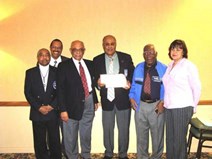 On January 16, 1941, the War Department announced the formation of the 99th Pursuit Squadron, a black flying unit, to be trained at Tuskegee, Alabama, the home of Tuskegee Institute. The Secretary of the Army announced that eleven white officers would be assigned to the duty of training 429 enlisted men and 47 officers as the first black military personnel in the flying school. From the inception of the 99th through the period that signaled the ending of WW II (1946), the following numbers of black combat flyers completed training: 673 single-engine pilots; 253 twin-engine pilots; 58 liaison field artillery officers and 132 navigators. The bulk of the flyers were in the 332nd Fighter Group, which consisted of the 99th Fighter Squadron; the 100 th Fighter Squadron; the 301 st Fighter Squadron; the 302nd Fighter Squadron; the 616th Bombardment Squadron; the 618th Bombardment Squadron and the 619th Bombardment Squadron. These men called themselves the "Lonely Eagles", a name which became their reality.
On January 16, 1941, the War Department announced the formation of the 99th Pursuit Squadron, a black flying unit, to be trained at Tuskegee, Alabama, the home of Tuskegee Institute. The Secretary of the Army announced that eleven white officers would be assigned to the duty of training 429 enlisted men and 47 officers as the first black military personnel in the flying school. From the inception of the 99th through the period that signaled the ending of WW II (1946), the following numbers of black combat flyers completed training: 673 single-engine pilots; 253 twin-engine pilots; 58 liaison field artillery officers and 132 navigators. The bulk of the flyers were in the 332nd Fighter Group, which consisted of the 99th Fighter Squadron; the 100 th Fighter Squadron; the 301 st Fighter Squadron; the 302nd Fighter Squadron; the 616th Bombardment Squadron; the 618th Bombardment Squadron and the 619th Bombardment Squadron. These men called themselves the "Lonely Eagles", a name which became their reality.
Among these men, were Nebraskans Alfonza W. Davis, Paul Adams, Ralph Orduna, John L. Harrison, Woodrow Morgan, Edward Watkins, Harrison A. Tull and Charles A. Lane, Jr., who trained to become flyers. The enlisted members trained to be aircraft and engine mechanics, armament specialists, radio repairmen, parachute riggers, control tower operators, policemen, administrative clerks and other skills necessary to fully function as an Army Air Corps (AAC) flying squadron or ground support unit. Enlisted men from Nebraska were: Melvin C. Robinson, Jethro Spurlock, William B. Patterson, Ellsworth P. Pryor, Calvin Hobbs, Albert Johnson, Jr., Erven McSwain, Marion N. Moore and Robert D. Holts. Standards were not lowered for the pilots or any others who trained in operations, meteorology, intelligence, engineering, medicine or other fields. The first aviation cadet class trained at Tuskegee Army Air Field (TAAF) in Tuskegee, Alabama beginning July 1941. They completed training nine months later in March 1942. From 1942 through 1946, 993 pilots graduated and received commissions and pilot wings. Black navigators, bombardiers and gunnery crews were trained at bases elsewhere in the US. Mechanics were trained at Chanute Air Base in Rantoul, Illinois until facilities were in place in 1942 at TAAF.
These airmen fought wars against an enemy military force overseas and against racism at home and abroad and forged the path for what forever changed the fabric of this country. Airmen who did not go overseas trained at Selfridge Field, Michigan as bomber crews in the 477th Bombardment Group (Medium). This composite group also included the 602ndAir Engineering Squadron, 616 th, 617th, 618th and the 619th Squadrons and was equipped with B-26 and later B-25 aircraft. Highly trained military officers, they were denied access to the base officers' club, experiencing a great deal of racism and were treated as "trainees". The group was transferred to Godman Field, Kentucky, then later to Freeman Field Indiana, where the hostilities reached a climax. Black officers tried to enter the club against direct orders. 103 officers were arrested and faced court martial. These proceedings were quickly dropped against 100 of the officers; 2 officers eventually had charges dropped and 1 officer, Lt. Roger "Bill" Terry, was convicted. In 1995 all references to the Freeman Field incident were purged from the airmen’s records and the charges against Mr. Terry had been reversed.
Campaigns of the 332nd Fighter Squadron included Sicily; Naples-Foggia; Anzio; Rome-Arno; Normandy; Northern France; Southern France; North Apennines; Rhineland; Central Europe; Po Valley, and Air Combat-EAME Theater. The 99th Fighter Squadron earned the "Distinguished Unit Citation" for Sicily, June-July, 1943; Cassino, May 1, 1944 and Germany, March 1945. On July 2, 1943, the 99th shot down their first enemy aircraft. Racial attitudes and discriminatory behavior of some Army Air Force leaders and officials led them to question the performance of the Tuskegee Airmen (TA). The 99 th Squadron and allied forces landed in Anzio January 21, 1944. The unit had seventeen confirmed kills, four probable victories and six damaged enemy aircraft by February 10th. News of the success of the TA reached military leaders. Many leaders began to favor them and praised their achievements and included them in more vital missions. The TA earned the respect of bomber crews who depended upon them for coverage. They were dubbed the "Red-tail Angels" by groups they escorted. Perhaps the unit’s greatest claim to fame was they never lost a bomber to enemy fighters. Sixty-six of these pilots were killed in aerial combat while another thirty-two were shot down and captured as POWs. After the war, Black airmen returned to the US and faced continued racism. Achievements and accolades attributed to these courageous men returning to their civilian lives in Nebraska have been: holding positions in leadership and respect as businessmen, teachers, civic leaders, community mentors, proclamations from public and City Officials and even public and military buildings named in their honor.
The distinguished record of the TA include 993 trained fighter pilots flying 1,578 missions, 15,533 sorties and awards to included 1 Legion of Merit,1 Silver Star, 2 Soldier Medals, 8 Purple Hearts, 95 Distinguished Flying Crosses, 14 Bronze Stars and 744 Air Medals and clusters. On March 29th, 2007, the TA was collectively honored and bestowed the most distinguished award established by the US Congress, the Congressional Gold Medal in recognition of their selfless service to their country.
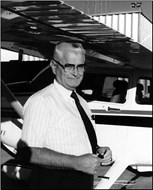 Tom Umberger, who made his mark on aviation in Lincoln, Nebraska, received his early training at the Lincoln Aeronautical Institute. During World War II his skills were put to good use at Lincoln's Army Air Force Technical Training School. He later received a flight instructor's rating and an appointment as Aircraft and Engine Mechanic and Pilot Flight Examiner by the Federal Aviation Administration. In 1945 Umberger managed Union Airport and became president of Union Air Service. He merged with the Lincoln Aeronautical Institute to become Lincoln Aviation, an accredited flight school and Piper aircraft dealer. Lincoln Aviation was sold to Duncan Aviation in 1979. Tom Umberger worked for Duncan until 1984.
Tom Umberger, who made his mark on aviation in Lincoln, Nebraska, received his early training at the Lincoln Aeronautical Institute. During World War II his skills were put to good use at Lincoln's Army Air Force Technical Training School. He later received a flight instructor's rating and an appointment as Aircraft and Engine Mechanic and Pilot Flight Examiner by the Federal Aviation Administration. In 1945 Umberger managed Union Airport and became president of Union Air Service. He merged with the Lincoln Aeronautical Institute to become Lincoln Aviation, an accredited flight school and Piper aircraft dealer. Lincoln Aviation was sold to Duncan Aviation in 1979. Tom Umberger worked for Duncan until 1984.
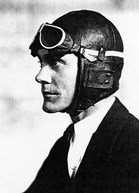 Reuben L. Wagner was born in Fairbury, July 7, 1897. He attended the University of Nebraska before enlisting in the Aviation Section of the U.S. Army Signal Corps and receiving flight training. He served as an Army aviation reservist, stunt pilot, and a pilot for the U.S. Post Office Department Air Mail Service. In 1928 he flew the first airmail plane to Lincoln, landing at Page Field. In 1934 Wagner was assigned to United Air Lines (UAL) air passenger service as a senior pilot. He supervised training of UAL DC-3 pilots. In 1942 he flew the first Air Transport Command (ATC/UAL) flight from San Diego to Australia in a C-87 (converted B-24). He continued to fly passenger service for United until his 1957 retirement from United Air Lines as the company’s senior captain with more than 31,000 hours flight time. He was presented with the President’s Award, United Airline’s highest honor. Wagner’s last flight for UAL was from Honolulu to San Francisco on a DC-7 christened the “Captain Reuben L. Wagner.”
Reuben L. Wagner was born in Fairbury, July 7, 1897. He attended the University of Nebraska before enlisting in the Aviation Section of the U.S. Army Signal Corps and receiving flight training. He served as an Army aviation reservist, stunt pilot, and a pilot for the U.S. Post Office Department Air Mail Service. In 1928 he flew the first airmail plane to Lincoln, landing at Page Field. In 1934 Wagner was assigned to United Air Lines (UAL) air passenger service as a senior pilot. He supervised training of UAL DC-3 pilots. In 1942 he flew the first Air Transport Command (ATC/UAL) flight from San Diego to Australia in a C-87 (converted B-24). He continued to fly passenger service for United until his 1957 retirement from United Air Lines as the company’s senior captain with more than 31,000 hours flight time. He was presented with the President’s Award, United Airline’s highest honor. Wagner’s last flight for UAL was from Honolulu to San Francisco on a DC-7 christened the “Captain Reuben L. Wagner.”
 Between 1942 and 1944, 1,102 women served as pilots for the U.S. Army Air Forces. They participated with instructor training, towing targets for air to air gunnery and ground to air anti-aircraft practice, transporting personnel and cargo and ferrying airplanes to training fields and embarkation points. This freed the male pilots for combat.
Between 1942 and 1944, 1,102 women served as pilots for the U.S. Army Air Forces. They participated with instructor training, towing targets for air to air gunnery and ground to air anti-aircraft practice, transporting personnel and cargo and ferrying airplanes to training fields and embarkation points. This freed the male pilots for combat.
The original group was called the Women’s Auxiliary Ferrying Squadron or WAFS. In 1943 they were re-designated Women AirforceService Pilots or WASP. By December of 1944 the group had unceremoniously been disbanded. During that short time frame, the ladies had logged over 60 million miles in military aircraft. At the final graduation ceremony in Sweetwater, Texas, General "Hap" Arnold spoke of their exemplary safety and delivery record.
In 1977, Congress granted veteran status to this group. This allowed them to receive medical benefits and the American Campaign Medal and the WWII Victory Medal. But most important to these ladies was that they could now be buried in our Nation’s cemeteries and their caskets could bear the United States Flag. On March 10, 2010 the Women Airforce Service Pilots were awarded the Congressional Gold Medal for their service in World War II.
Nineteen of those women came from Nebraska. They are: Dorothy L. Bancroft, Mary B. Beecham, Lois V. Boien, Lois A. Bristol, Grace "Betty" E. Clements, Mary A. Jershin, Eileen "Ikey" A. Kealy, Marybelle J. Lyall, Esther L. Mueller, Roberta E. Mundt, Margaret "Peggy" L. Nispel, Millicent A. Peterson, Alice L. Riss, Evelyn G. Sharp, B. Kristin Swan, Helen A. Turner, Isabel E. Tynon, Jane E. Waite and Mary E. Williamson. All but four of these ladies are deceased, they are Lois A Bristol Young, B. Kristin Swan Lent, Millicent A. Peterson Young and Dr. Mary E. Williamson.
 Elton L. “Wes” Weston was born in Gibbon, Nebraska. He entered the Aviation Cadet Program in Lackland, Texas in February 1954, earning his wings of silver. Weston’s military aviation career spanned twenty-three years and approximately 6,000 hours, mostly in fighter aircraft. He returned to Kearney, Nebraska to begin his second aviation career. In 1975, he and his wife Bev bought Midway Aviation in Kearney. As Chief Pilot, he developed an FAA-approved certified pilot training program. Weston worked with Dr. Leonard Skov, Dean of Education at Kearney State College, to organize an FAA-approved flight school for the college. He established aircraft rental, air taxi, and charter operations. He became an FAA examiner and offered flight instruction. In 1982 Wes and Bev received the Nebraska Airport Operator of the Year award for outstanding operation, presented by the International Flying Farmers.
Elton L. “Wes” Weston was born in Gibbon, Nebraska. He entered the Aviation Cadet Program in Lackland, Texas in February 1954, earning his wings of silver. Weston’s military aviation career spanned twenty-three years and approximately 6,000 hours, mostly in fighter aircraft. He returned to Kearney, Nebraska to begin his second aviation career. In 1975, he and his wife Bev bought Midway Aviation in Kearney. As Chief Pilot, he developed an FAA-approved certified pilot training program. Weston worked with Dr. Leonard Skov, Dean of Education at Kearney State College, to organize an FAA-approved flight school for the college. He established aircraft rental, air taxi, and charter operations. He became an FAA examiner and offered flight instruction. In 1982 Wes and Bev received the Nebraska Airport Operator of the Year award for outstanding operation, presented by the International Flying Farmers.
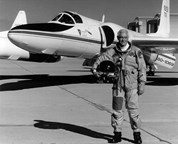 Ronald R. Williams, of Milford, Nebraska earned his greatest notoriety in 1985 while involved in high altitude research, flying the ER-2 for NASA/Lockheed. He made the first flight into the ozone hole over the Antarctic. He served for twenty-two years in the U.S Air Force, flying 250 combat missions in the F-4 during the Vietnam War and later in the U-2 squadron, flying 167 combat missions. He rose to the rank of lt. colonel and was awarded the Distinguished Flying Cross with one oak leaf cluster and the Air Medal with seventeen clusters. Williams retired in 1996, continuing to serve as a consultant to NASA, advising and instructing ER-2 pilots on ER-2 operations.
Ronald R. Williams, of Milford, Nebraska earned his greatest notoriety in 1985 while involved in high altitude research, flying the ER-2 for NASA/Lockheed. He made the first flight into the ozone hole over the Antarctic. He served for twenty-two years in the U.S Air Force, flying 250 combat missions in the F-4 during the Vietnam War and later in the U-2 squadron, flying 167 combat missions. He rose to the rank of lt. colonel and was awarded the Distinguished Flying Cross with one oak leaf cluster and the Air Medal with seventeen clusters. Williams retired in 1996, continuing to serve as a consultant to NASA, advising and instructing ER-2 pilots on ER-2 operations.
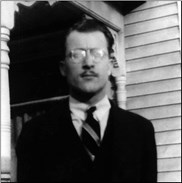 Richard Wood helped design and build Howard Hughes' "Spruce Goose," a legendary airplane. A native of Oxford, Nebraska, Wood earned a degree in aeronautical engineering in California, then moved back to Nebraska to learn to fly. After a stint with the Boeing company in Wichita, Kansas he moved to Hughes Aircraft in southern California in 1947. Wood served as a stress analyst on the Spruce Goose, the world's largest airplane. The need for the huge cargo plane disappeared with World War II's end. But Hughes continued work on the plane and piloted its one brief test flight in November 1947.
Richard Wood helped design and build Howard Hughes' "Spruce Goose," a legendary airplane. A native of Oxford, Nebraska, Wood earned a degree in aeronautical engineering in California, then moved back to Nebraska to learn to fly. After a stint with the Boeing company in Wichita, Kansas he moved to Hughes Aircraft in southern California in 1947. Wood served as a stress analyst on the Spruce Goose, the world's largest airplane. The need for the huge cargo plane disappeared with World War II's end. But Hughes continued work on the plane and piloted its one brief test flight in November 1947.
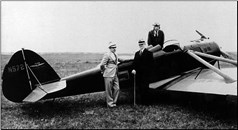 F. Pace Woods, Sr., whose family helped build Lincoln, Nebraska, helped elevate the city to one of the commercial aviation centers of the 1920s. In 1926 he formed the Arrow Aircraft and Motors Corporation, which briefly held a position as a leading American airplane manufacturer. At its peak Woods' company employed more than 700 workers, who could build four Arrow airplanes a day. He delivered 187 Arrows before the financial crash of 1929. The company's fortunes withered, and Woods sold out in 1941. By that time, though, his Arrow Sport, "the spinless wonder," had secured a place in aviation history.
F. Pace Woods, Sr., whose family helped build Lincoln, Nebraska, helped elevate the city to one of the commercial aviation centers of the 1920s. In 1926 he formed the Arrow Aircraft and Motors Corporation, which briefly held a position as a leading American airplane manufacturer. At its peak Woods' company employed more than 700 workers, who could build four Arrow airplanes a day. He delivered 187 Arrows before the financial crash of 1929. The company's fortunes withered, and Woods sold out in 1941. By that time, though, his Arrow Sport, "the spinless wonder," had secured a place in aviation history.
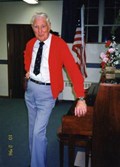 Henry W. Wulf was born on January 10, 1924 at Falls City, Nebraska . He attended several rural grade schools and graduated in 1942 from Falls City High School. After graduation, he worked as an auto mechanic until being drafted in 1943 to the U.S. Navy. After several internal combustion engine schools, Henry was joined by several other specialists to operate a squadron of Aircraft Rescue Boats (ARB’s) intended to be used to rescue pilots and crews from aircraft downed at sea. He was discharged from the Navy in December 1945.
Henry W. Wulf was born on January 10, 1924 at Falls City, Nebraska . He attended several rural grade schools and graduated in 1942 from Falls City High School. After graduation, he worked as an auto mechanic until being drafted in 1943 to the U.S. Navy. After several internal combustion engine schools, Henry was joined by several other specialists to operate a squadron of Aircraft Rescue Boats (ARB’s) intended to be used to rescue pilots and crews from aircraft downed at sea. He was discharged from the Navy in December 1945.
After returning home, Henry helped with the sale and disposition of many horses and mules during the closing of Ft. Robinson, Nebraska in 1946-47. It is now operated by the Game and Parks Department of Nebraska as an historical site used for camping and recreation.
After receiving a BS in civil engineering from the University of Nebraska in 1957, Henry was tested and passed the registration requirements for a Professional Engineer.
From the fall of 1951 to March 1960, Henry was employed by HWS Engineering and assigned to projects of planning, surveys, pre-construction conferences and project observation on villages, cities, counties and private utility projects that needed upgrading. This wide variety of projects served him well on the planning and construction of water, sanitary sewer systems, storm sewers, electrical distribution systems and electrical vaults on airports. He did preliminary surveys on the extension and renovation of runways and facilities on the Lincoln Airport conversion from a military airport to public airport. He also served on the survey crew for the United States Air Force and proposed sites to be used for hardened, below ground missile silos in southeast Nebraska. This work required a more exact level of surveys for the siting of Atlas missile facilities in Nebraska.
In March of 1960, Henry started to work for the Nebraska Department of Aeronautics and in 1965 became Assistant Airport Engineer. In March of 1982, he was elevated to the position of State Airport Engineer.
During his years at NDA, Henry helped to revise the statewide zoning handbook for public airports to control the height of structures in the vicinity of an airport. He also assisted the Lancaster County Planning and Zoning Board in creating regulations to control the height of structures and the use of land in and around the approaches and land immediately next to a general aviation airport that is registered by the Lancaster County Board and NDA. Henry pushed all airports to update their height restriction zoning and by the time of Henry’s retirement 75% of Nebraska airports were thus zoned.
Henry always thought of how aviation facilities could be improved. He worked with airport sponsors and the Federal Aviation Administration to develop new runways, extend runways and construct hangars. He planned trips to visit airports all over Nebraska. At each location, he would meet with Airport Authority Boards, City Managers, Mayors or anyone interested in developing the airport. He explained how federal funds could be obtained and what obligations would be incurred.
Henry participated in the site selections for new airports and coordinated funding. Several new airports as well as new runways were built across the State because of Henry’s tenacity in making things happen. He envisioned a State Airport System which had an airport in every county and within thirty minutes driving time.
In 1985, the Pavement Condition Index (PCI) program was started, which Henry developed. Nebraska was the second state to do this. He understood that if maintenance was not performed, there were not enough funds to reconstruct pavement. He made sure that everyone in NDA’s engineering department understood the importance of this and that repairs were a priority. Because of Henry’s urging a state team was started to assist airports with maintenance and crack filling.
The Seal Coat program evolved at this same time. Under this program, the airport hired NDA as their engineer (free of charge) to seal coat asphalt pavements. All Airports were grouped into one bid, so prices were lower. NDA paid 75% of the construction costs and 100% of the engineering costs. This led to improved pavements and longer pavement life, which reduced the need for overlays and reconstruction.
State owned AWOS (automated weather observation systems) were installed as a result of Henry’s efforts. NDA received a FAA grant, which was unique at the time. Seven were installed in 1990, shortly after Henry’s retirement.
Henry envisioned that every airport in the state would have an instrument approach. He insisted that zoning regulations be developed for the most critical instrument approaches to all runways. Twenty years after Henry’s vision, the FAA has developed a satellite navigation system which can bring instrument approaches to every airport in the state that has clear approaches which meet the instrument criteria. Due to his efforts in airport zoning, many of Nebraska’s airports have clear approaches.
Henry was instrumental in developing (with National Geodetic Survey & Nebraska Department of Roads) geodetic control in the airport vicinity consisting of permanent survey marks accurately connected to the National Spatial Reference System (NSRS). This control and the NSRS connection assures accurate relativity between surveyed points on the airport and between these points and other surveyed points in the National Airspace System (NAS). These survey points are Permanent Airport Control Station (PACS) and Secondary Airport Control Station (SACS). Some of the points have local relevance because they were named for local pilots & airport officials.
Henry was State Airport Engineer 24/7 until he retired in March of 1990. During 1960 to 1990 there were 272 state grant projects, 214 hangar loans and 320 federal grants at 73 Nebraska airports. Without Henry’s visions and tenacity, the airports in Nebraska would not be what they are today.
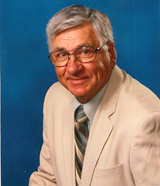 George started his aviation career in the United States Air Force in 1962 as a jet engine mechanic and was honorably discharged in 1966. After serving in the Air Force he continued to gain ratings and certifications in aviation while working as both an auto and aviation mechanic.
George started his aviation career in the United States Air Force in 1962 as a jet engine mechanic and was honorably discharged in 1966. After serving in the Air Force he continued to gain ratings and certifications in aviation while working as both an auto and aviation mechanic.
Highlights of his career include employment with Boeing Aircraft Company in Everett, Washington, on the final assembly of the 1st three 747 aircraft produced. He also worked for Air-Kaman and Air Venture in Omaha while completing Beechcraft Service Training for the King Air 100, obtaining his FAA Inspection Authorization, private and commercial pilot ratings.
In 1973 George obtained FAA Certified Repair Station # MY2R022L for Central Cylinder Service Inc. while working for Northwestern Bell as a pilot and mechanic. George worked for Northwestern Bell for 11 years and received his ATP while working both as a pilot and as a technician. He maintained and flew Citation and Falcon jets at that time.
During those years he continued to grow Central Cylinder Service into one of the most respected and diverse repair facilities in general aviation. He has completed countless annual inspections, major and minor repairs and developed repair processes over the years. His expertise and professionalism is known throughout the aviation community and he has built a career out of being reliable, honest and professional at all times. All this while being a friend and mentor to many pilots and mechanics.
George has taken the mission to “keep em flying” to heart and has established himself as a go-to guy for the Rolls Royce Merlin and Allison V12 engines as well as having the ability and knowledge to come up with repair solutions for almost any engine part that comes through the door.
